- Latest News
- Jawazat and MOI
- Driving in KSA

- Places to Visit in Saudi Arabia
- Places to Visit in Madina

6 things to know about Madain Saleh
Table of Contents
We have explained everything about Madain Saleh including its history in Quran and Hadith and its relationship with the current Al Ula.
- 12 tourist places to visit in Al Ula
Madain Saleh History
Madain Saleh was once the capital of the Kingdom of Lihyan. It is believed that the people of Thamud started inhabiting this place at around 2100 B.C. (i.e. around 4100 years from now).
This area has been discussed in the Holy Quran and a Hadith. There is a story of Prophet Saleh عليه السلام and his camel.
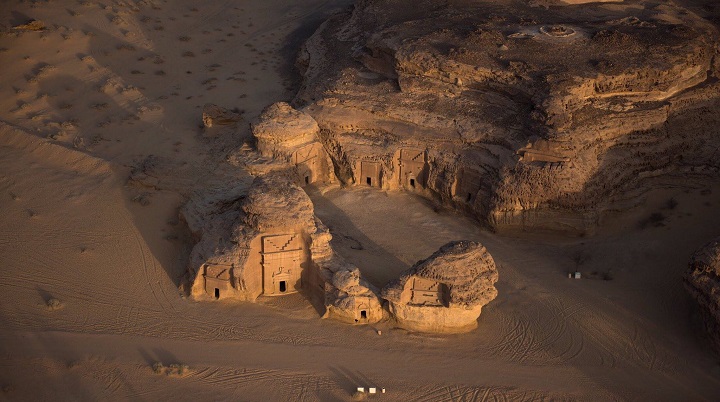
Prophet Saleh and his camel
People of Thamud used to live in this area where Prophet Saleh عَلَيْهِ ٱلسَّلَامُ was sent to guide them. This is the reason this area is called Madain Saleh.
To test Prophet Saleh عَلَيْهِ ٱلسَّلَامُ, they asked him to bring a particular camel from a solid, which the leaders of Thamud later killed. Finally, Allah destroyed the people of Thamud with an earthquake.
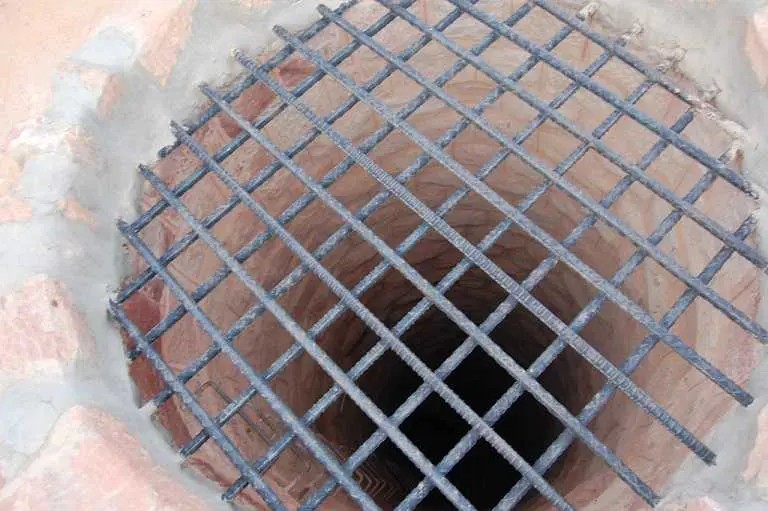
Madain Saleh in Quran
A section is present in the Holy Quran which explains the real story of these houses.
- “And you carve out of the mountains, homes, with skill”. Ash-Shu’ara 26:149 .
- “And do not touch her with harm, lest you be seized by the punishment of a terrible day. But they hamstrung her and so became regretful. And the punishment seized them. Indeed, that is a sign, but most of them were not to be believers.” Ash-Shu’ara 26:156-158

Madain Saleh Hadith
In the eyes of many scholars, it is forbidden to visit Madain Saleh due to a hadith of Prophet Muhammad ﷺ where he abstained people from entering the place.
Prophet Muhammad ﷺ said: “Do not enter the ruined dwellings of those who were unjust to themselves unless (you enter) weeping, lest you should suffer the same punishment as was inflicted upon them.” – Sahi Bukhari 3381

Why is Madain Saleh forbidden?
As you can read in the Hadith given above, Prophet Muhammad ﷺ has forbidden Muslims to visit Madain Saleh for entertainment.
However, it is allowed to visit if you go there crying, taking a lesson from those who abstained from the path of Allah and how Allah cursed them.
Why is Al Ula cursed?
Al Ula is a significant region, and Madain Saleh or Hegra is just a small area located 22 km north of the city.
Therefore, it would be wrong to state that the entire Al Ula region is cursed, as Madain Saleh is only a tiny part. So, you can still plan a trip to Al Ula and avoid the cursed areas of Madain Saleh.
For the latest updates, you can join our ✅ WhatsApp group or ☑️ Telegram Channel .
Never pay the full price🏷️; join the 📢 Saudi Coupon Codes group and get sales updates and discount codes in one place.
RELATED ARTICLES MORE FROM AUTHOR
Masjid al-nabawi underground parking guide, 8 landmark mountains in madina, ethq well in madina, 6 facts about arees well – bir al-khatam, 4 facts about ghars well in madina, 5 historical mihrab of masjid al nabawi.
Take advantage of the search to browse through the World Heritage Centre information.
Share on social media
Unesco social media, hegra archaeological site (al-hijr / madā ͐ in ṣāliḥ).
- Description
The Hegra Archaeological Site (al-Hijr / Madā ͐ in Ṣāliḥ) is the first World Heritage property to be inscribed in Saudi Arabia. Formerly known as Hegra it is the largest conserved site of the civilization of the Nabataeans south of Petra in Jordan. It features well-preserved monumental tombs with decorated facades dating from the 1st century BC to the 1st century AD. The site also features some 50 inscriptions of the pre-Nabataean period and some cave drawings. Al-Hijr bears a unique testimony to Nabataean civilization. With its 111 monumental tombs, 94 of which are decorated, and water wells, the site is an outstanding example of the Nabataeans’ architectural accomplishment and hydraulic expertise.
Description is available under license CC-BY-SA IGO 3.0
Site archéologique de Hegra (al-Hijr / Madā ͐ in Ṣāliḥ)
Le Site archéologique de Hegra (al-Hijr / Madā ͐ in Ṣāliḥ), est le premier site de ce pays inscrit sur la Liste du patrimoine mondial. Anciennement appelé Hegra, il s’agit du plus important site conservé de la civilisation des Nabatéens au sud de Pétra (Jordanie), il comporte notamment des tombes monumentales aux façades décorées, datant principalement du 1er siècle avant J.C. au 1er siècle après J.C. Le site compte aussi une cinquantaine d’inscriptions de la période pré-nabatéenne et des dessins rupestres. Al-Hijr est un témoignage unique de la civilisation nabatéenne. Avec ses 111 tombes monumentales, dont 94 avec des façades décorées, et ses puits, le site est un exemple exceptionnel de la qualité de l’architecture des Nabatéens et de leur maîtrise des techniques hydrauliques.
الحجر (مدائن صالح)
يشكل موقع الحجر الأثري (مدائن صالح) في المملكة العربية السعودية، أول موقع لها يدرج في قائمة التراث العالمي. كان يسمى في الماضي الحجرة، وهو أكبر موقع مُصان لحضارة الأنباط جنوب البتراء بالأردن. ويحوي مقابر ضخمة مُصانة جيداً، تعود واجهاتها المزخرفة إلى القرن الأول قبل الميلاد وصولاً إلى القرن الأول الميلادي. الموقع قائم على مسافة 500 كلم من جنوب شرق البتراء، ويشمل حوالي 50 نقشاً من الحقبة السابقة للأنباط، وعدداً من رسوم الكهوف. يحمل موقع الحجر شهادة فريدة عن حضارة الأنباط. وتعتبَر مقابره الضخمة البالغ عددها 111 مقبرة (وقد زُين 94 منها بالزخارف)، وآباره المائية، مثلاً استثنائياً عن الإنجازات المعمارية للأنباط وخبراتهم الهيدرولوجية.
source: UNESCO/CPE Description is available under license CC-BY-SA IGO 3.0
El sitio arqueológico de Al Hijr – Madain Salih
Es el primer sitio del Patrimonio Mundial inscrito en este país. Conocido en la antigüedad con el nombre de Hegra en la Antigüedad, es el sitio de la civilización nabatea mejor conservado al sur de Petra (Jordania). Comprende una serie de tumbas monumentales con fachadas ornamentadas, que se hallan en buen estado de conservación y datan de los siglos I a.C. y I d.C. Posee además medio centenar de inscripciones del periodo prenabateo y algunas pinturas rupestres. Al Hijr constituye un testimonio excepcional de la civilización nabatea. Sus pozos y sus 111 sepulturas monumentales, entre las que figuran 94 ornamentadas, son una muestra excepcional de las realizaciones arquitectónicas de los nabateos y de su dominio de las técnicas hidráulicas.
アル-ヒジュル古代遺跡(マダイン・サーレハ)
source: NFUAJ
Archeologisch gebied Al-Hijr (Madâin Sâlih)
Het archeologisch gebied Al-Hijr (Madâin Sâlih) heette voorheen Hegra en is als eerste streek van Saoedi-Arabië toegevoegd aan de Werelderfgoedlijst. De plek is het grootst bewaard gebleven gebied van de beschaving van de Nabateeërs ten zuiden van Petra in Jordanië. De omgeving wordt gekenmerkt door 111 goed onderhouden graftombes – waarvan 94 met gedecoreerde voorgevels – daterend uit de 1e eeuw voor tot de 1e eeuw na Christus. Er zijn ook zo'n 50 inscripties uit de pre-Nabateeërs periode en enkele grottekeningen te vinden. Al-Hijer is met zijn monumentale graftombes en waterputten een voorbeeld van indrukwekkende architectuur en hydraulische expertise.
Source: unesco.nl
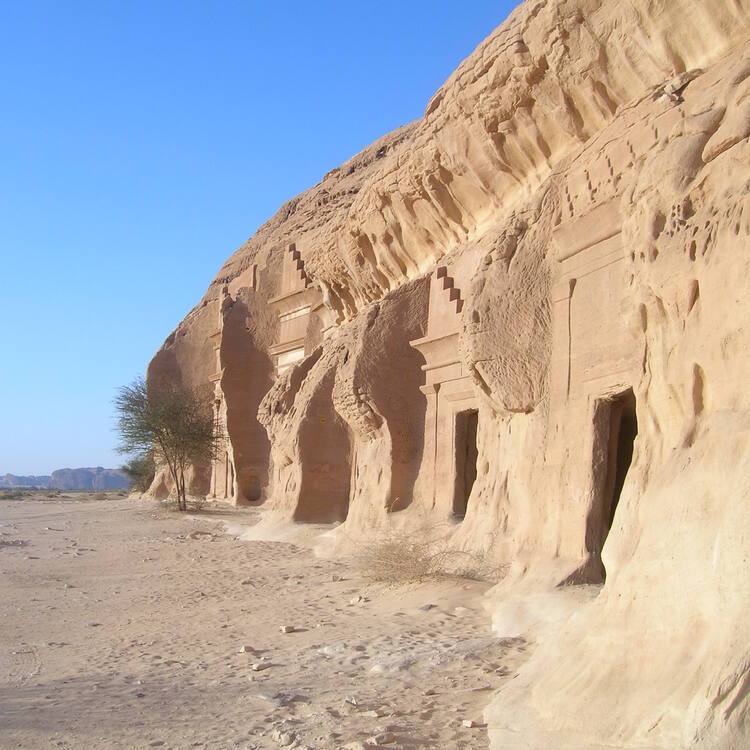
Outstanding Universal Value
The archaeological site of Al-Hijr is a major site of the Nabataean civilisation, in the south of its zone of influence. Its integrity is remarkable and it is well conserved. It includes a major ensemble of tombs and monuments, whose architecture and decorations are directly cut into the sandstone.
It bears witness to the encounter between a variety of decorative and architectural influences (Assyrian, Egyptian, Phoenician, Hellenistic), and the epigraphic presence of several ancient languages (Lihyanite, Thamudic, Nabataean, Greek, Latin).
It bears witness to the development of Nabataean agricultural techniques using a large number of artificial wells in rocky ground. The wells are still in use.
The ancient city of Hegra/Al-Hijr bears witness to the international caravan trade during late Antiquity.
Criterion (ii): The site of Al-Hijr is located at a meeting point between various civilisations of late Antiquity, on a trade route between the Arabian Peninsula, the Mediterranean world and Asia. It bears outstanding witness to important cultural exchanges in architecture, decoration, language use and the caravan trade. Although the Nabataean city was abandoned during the pre-Islamic period, the route continued to play its international role for caravans and then for the pilgrimage to Mecca, up to its modernisation by the construction of the railway at the start of the 20th century.
Criterion (iii): The site of Al-Hijr bears unique testimony to the Nabataean civilisation, between the 2nd and 3rd centuries BC and the pre-Islamic period, and particularly in the 1st century AD. It is an outstanding illustration of the architectural style specific to the Nabataeans, consisting of monuments directly cut into the rock, and with facades bearing a large number of decorative motifs. The site includes a set of wells, most of which were sunk into the rock, demonstrating the Nabataeans' mastery of hydraulic techniques for agricultural purposes.
The testimony borne by Al-Hijr to the Nabataean civilisation is of outstanding integrity and authenticity, because of its early abandonment and the benefit over a very long period of highly favourable climatic conditions.
The State Party has begun to set up an extremely comprehensive Local Management Unit, and this process is now under way. The announced management plan should enable satisfactory protection of the property. With this in mind, the plan should organise systematic monitoring of the conservation of the site, and prepare a project for the presentation of the Outstanding Universal Value of the property for the benefit both of visitors and of the population of the region.
- Google Arts & Culture: Story
- Royal Commission for AlUla (RCU)
Pilgrim Knowledge
Umrah for those who need it
Pilgrim Fund
Saving For Pilgrimage

Islamic Landmarks.com
Historical Islamic Sites

My Dua List
Easiest way to collect dua requests
Step by step Umrah
Detailed Hajj Guide
Tailored Guide
Sites, shops and more
Madain Saleh – Hegra / Al Hijr – History, Facts, Importance – Everything You Need To Know
Table of Contents
The name “ Madain Saleh ” is derived from the Quranic reference to the People of Thamud, also known as Nabateans, an ancient Arabian tribe associated with the heritage site in the Madinah province.
It is said that the People of Thamud were punished for their disbelief, and their settlement carved out of mountains – Al Hijr was transformed into a city of rocks.
Let’s dive deep into the story of Al-Ula:
What is Madain Saleh / Hegra / Al Hijr?
Madain Saleh was once a city in Saudi Arabia ruled by the Nabateans, just like Petra. Today, it is an archaeological site that boasts well-preserved monumental tombs.
It thrived during the same period, from the 1st century BCE to 74 CE. The Nabateans were skilled traders, and they established a network of routes connecting their capital city, Petra, with their southern outpost, Madain Saleh.
The city of tombs served as a crucial trade stop along the incense route for transporting valuable spices and perfumes from southern Arabia to the Mediterranean world.
Al Ula AKA Madain Saleh a UNESCO World Heritage Site
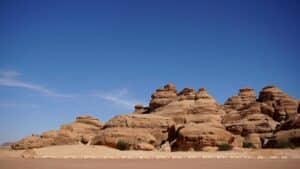
The tombs of Madain Saleh in Saudi Arabia are a UNESCO World Heritage Site. Located in Saudi Arabia, they represent the Nabataean civilization in Jordan’s Petra.
If you look at a map, you will see it standing on the Arabian Peninsula’s trade route.
Al Hijr is also called an archaeological site by the name “The Capital of Monuments.” It has various inscriptions and cave drawings in old languages, reading as scripts.
There are 111 water wells and tombs at the site that depict the Nabataeans’ architectural accomplishments and hydraulic expertise.
What is the Story of Madain Saleh
The beautiful views and tombs of the Madain Saleh site attracted the People of Thamud and convinced them it was the perfect place to build their home. That’s how the Al Hijr settlement came to be.
Amongst them was Prophet Saleh, who had built a respectful image. He was a wealthy man, and the People of Thamud considered him a wise man with virtue. They were ready to appoint him as their tribe’s leader.
It was at this time that Allah (SWT) made Saleh a Prophet. When Saleh saw Nabataeans worshipping idols, Prophet Saleh (AS) said:
“O my people, worship Allah; you have no deity other than Him. He has produced you from the earth and settled you in it. So, ask forgiveness of Him and then repent to Him. Indeed, my Lord is near and responsive.” [Quran, 11:61]
He continued to bring people to the right path and worship Allah (SWT), but they said:
“O Saleh, you were among us a man of promise before this. Do you forbid us to worship what our fathers worshipped? And indeed, we are in disquieting doubt about that to which you invite us.” [Quran, 11:62]
Despite his warnings, the majority of the Nabataeans rebuked Saleh and even spread rumors that he was possessed.
More and more people started to follow Prophet Saleh (AS). The People of Thamud feared that this might lead to a revolt and their idols would be thrown out, so they decided to confront Saleh with a plan. They asked him to show a miracle to prove that he was Allah’s (SWT) messenger.
The leaders of Thamud gathered with prohet Saleh (AS) and pointed at a rock, demanding that he bring a she-camel from underneath it. Saleh was committed to Islam and wanted the People of Thamud to follow him, so he pleaded with Allah (SWT) to bring the she-camel to life.
The day came when Allah (SWT) granted Saleh’s wish, and the People of Thamud witnessed the arrival of the she-camel. As the rock split, a gigantic, red, 10-month-pregnant she-camel emerged, surprising the People of Thamud.

Then and there, many Nabataeans followed Saleh and declared their faith. Those who remained untouched even after witnessing the miracle said this was magic.
As more people converted to Islam, the leaders of Thamud feared that prophet Saleh (AS) would lead their people away from the path their forefathers followed. So, they conspired against the miracle.
“O my people, this is the she-camel of Allah – [she is] to you a sign. So, let her feed upon Allah’s earth and do not touch her with harm, or you will be taken by an impending punishment.” [Quran, 11:64]
As the disbelievers watched the she-camel drink from their common well and graze on the land, their hatred intensified. Nine of them got together and decided to kill the she-camel.
As the she-camel approached the well to quench her thirst, one of the men shot her in the long, hindering her escape. Others sprang forward and ended her life with a sword.
The disbelievers cheered and, to the believers’ horror, ate the meat of the she-camel. When prohet Saleh (AS) heard of the killing, he hurried to salvage the situation, but it was too late. Witnessing the slaughtered she-camel, he said:
“Enjoy yourselves in your homes for three days. That is a promise that will not be denied.” [Quran, 11:65]
When the disbelievers mocked Prophet Saleh (AS), he said:
“O my people, why are you impatient for evil before good? Why do you not seek forgiveness of Allāh that you may receive mercy?” [Quran, 27:46]
Allah’s (SWT) wrath was coming.
“And they planned a plan, and We planned a plan, while they perceived not” [Quran, 27:50]
Approximately three days after prophet Saleh’s (AS) warning, severe earthquakes shook the ground of the Madain Saleh site, and thunderbolts struck the rock structure and tombs, destroying everything.
A cry sounded in the air, and all the disbelievers died at the same time. After the destruction of the People of Thamud, prophet Saleh (AS) migrated to Palestine and lived there until he returned to Allah (SWT).
Prophet Salih (AS)
Prophet Salih (AS) is a significant figure in the Quran. He was one of the prophets sent by Allah (SWT) to guide the people of the city of Thamud, who lived in Al Ula.
Prophet Saleh’s (AS) story carries valuable lessons about the consequences of disbelief and the importance of obeying divine commands.
He achieved Prophethood when he led the People of Thamud to the path of righteousness.
Who Were the People of Thamud
The people of Thamud were an ancient Arabian tribe believed to have lived in the Al Hijr region of present-day Saudi Arabia. Their history is shrouded in mystery, but they are well-documented in various historical and religious texts, including the Quran.
They came after Ad, another tribe that Allah (SWT) destroyed for their disbelief.
The She-Camel
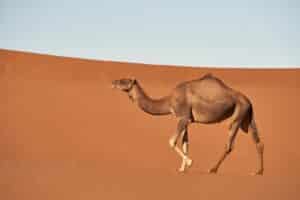
The she-camel that the People of Thamud wanted Prophet Saleh (AS) to conjure from underneath the rock was an extremely tall, attractive, very woolly, and pregnant animal. The camel was able to produce milk for all the people of Madain Saleh.
When Saleh pleaded with Allah (SWT) to make the miracle happen, a red camel emerged with all the characteristics the People of Thamud had demanded in the camel.
The Earthquake
The story of the people of Thamud reaches its end with divine retribution in the form of a catastrophic earthquake. After repeated warnings from Prophet Saleh (AS), the people of Thamud were given a final chance to repent and turn away from their sinful ways.
However, they persisted in their arrogance and denial, demanding proof of Saleh’s prophethood (AS) again.
In response to their obstinacy, Allah (SWT) unleashed a fearsome earthquake that shook the very foundations of the land. The Quran describes the event vividly:
“And when Our command came, We saved Salih and those who believed with him by a mercy from Us, and [saved them] from the disgrace of that day. Indeed, it is your Lord who is the Powerful, the Exalted in Might.”
[Quran, 11:66]
The earthquake was so devastating that it annihilated the People of Thamud and left them in ruins. Their once-mighty structures and tombs, which they had carved into the mountains with such pride, were reduced to rubble.
They and the Maden Saleh site became nothing more than a cautionary tale for future generations.
Verses from the Quran

“The people of Stone Valley (al-Hijr) also rejected Our Messengers. We gave them Our signs, but they turned their backs. They carved out dwellings in the mountains and lived in security. But the blast overwhelmed them early in the morning.” [Quran, 15:80-84] “The Destruction of the Dwellers of High Rocky Plain (Al-Hijr), Who Were Known as People called Thamud” [Quran, 29:38] “And the people of ’Ad and Thamud met a similar fate, which must be clear to you Meccans from their ruins. Satan made their evil deeds appealing to them, hindering them from the Right Way, although they were capable of reasoning.” [Quran, 29:38] “Do you construct on every elevation a sign amusing yourselves? And take for yourselves palaces and fortresses that you may abide eternally?” [Quran, 128-129]
Why Did Allah Destroy the People of Thamud?
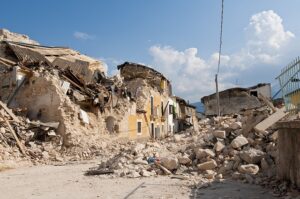
The people of Thamud had deviated from the teachings of the Prophet Noah (AS) and started practicing idolatry. They carved idols out of stone and worshipped them, associating partners with Allah (SWT). This was a grave sin in Islam, as it went against the oneness of Allah (Tawhid).
Because of their mastery in carving homes in the mountains, they became arrogant and proud of their accomplishments. They believed in their self-sufficiency and denied the blessings of Allah (SWT).
Their arrogance led them to reject the message of the Prophet Saleh (AS), who was sent to guide them back to righteousness.
Allah (SWT) didn’t like their oppressive behavior and mistreatment of the weak. They would exploit their fellow citizens and showed no mercy or compassion.
The People of Thamud rejected Allah’s messenger, prophet Saleh (AS), and even challenged him to provide a miracle as proof of his prophethood.
When Allah (SWT) granted Prophet Saleh (AS) the miraculous birth of a she-camel from a massive rock, they demanded that the she-camel perform specific feats.
When the she-camel did so, they still refused to believe and instead plotted to kill the miraculous animal.
Their stubbornness and refusal to repent ultimately sealed their fate.
What Did Prophet Muhammad (SAW) Say About Madain Saleh?
“And call to mind when He made you successors after ‘Ad and gave you power in the earth so that you took for yourselves palaces in its plains and hewed out dwellings in the mountains. Remember, then, the wondrous bounties of Allah, and do not go about creating mischief in the land.” [Quran, 7:74]
During his journey for the Battle of Tabuk, Prophet Muhammad (PBUH) and his companions passed by Al Ula. He pointed out Madain Saleh and its tombs to his companions and said it was ibrat.
He told them only to drink water from the well that Prophet Saleh’s (AS) she-came drank water from and forbade them to drink or eat anything else from the area.
Why is Madain Saleh Forbidden?
In the 1970s, the Council of Senior Ulama released an official fatwa that forbade visitation to the Madain Saleh site and the tombs.
It also prohibited the excavation and development of Hegra tombs because it was a place that had seen the wrath of Allah (SWT). This is one of the reasons behind the belief that Maiden Saleh is cursed
Is it Permissible to Visit Madain Saleh?
While Madain Saleh and its tombs are an archeological site and not entirely “forbidden,” there are certain restrictions on access to the heritage center.
Visitors can explore the site, but it is essential to follow specific guidelines and rules to preserve its historical integrity.
Summary – Madain Saleh
The people of Thamud initially trusted and accepted Prophet Saleh’s (AS) message. However, their jealousy and disobedience led them to reject his guidance and commit sinful acts.
The story of Thamud demonstrates the consequences of defying Allah’s (SWT) commands and not believing in his power.
It serves as a reminder that individuals and communities can face divine retribution if they persist in wrongdoing. This is why the Maden Saleh site is now turned to rubble.

0% of readers found this article helpful. Did you?
Report an issue
Through His Names
New course with Ustadh Shabbir Hassan
Your content goes here
“Pilgrimage to this House is an obligation by Allah upon whoever is able among the people.” — Qur’an 3:97
Want a guided tour of Jannatul Baq? Learn more here.
Alert: It is recommended that you take a drawstring bag for your shoes. Keep them close to you because they can get lost fairly easily.
Recommended Reads
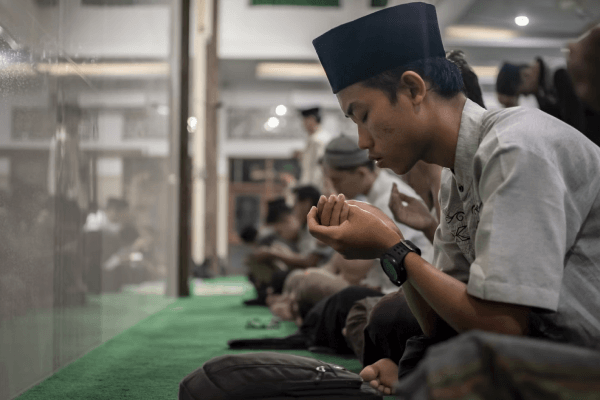
9 minute read
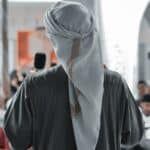
Battle of Buhran – Patrolling Invasion
7 minute read

5 Pillars of Islam – Shahada, Salah, Zakat, Sawm and Hajj
8 minute read
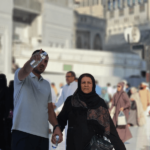
Can a Woman Go To Umrah Without Mahram In Islam? – Complete Guide
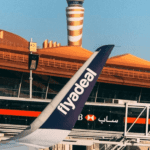
Ruling on Zamzam water from Saudi Arabia Airports l Which Saudi airports allow Zamzam water?
5 minute read
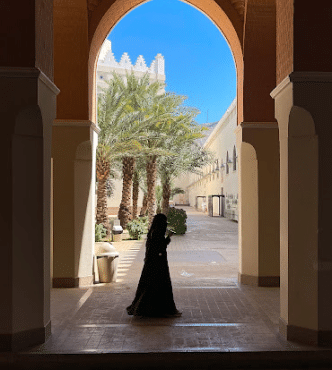
Can a women go to Hajj without a Mahram?
Recommended Videos

E7 I The Pardoner I Through His Names
· 5.9K views
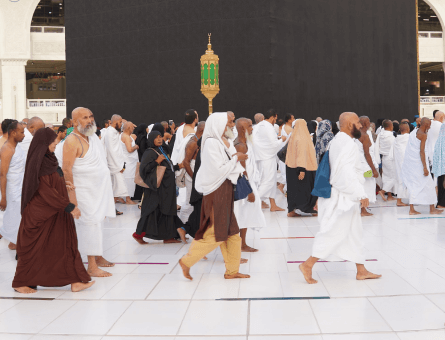
What is the importance of the Hateem and history with the Ka’abah?
· 3.9K views
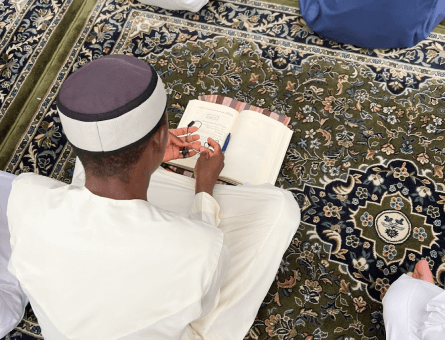
What Is the Reward for Umrah in Ramadan?
· 6.5K views

E9 I The Healer I Through His Names
· 6.9K views
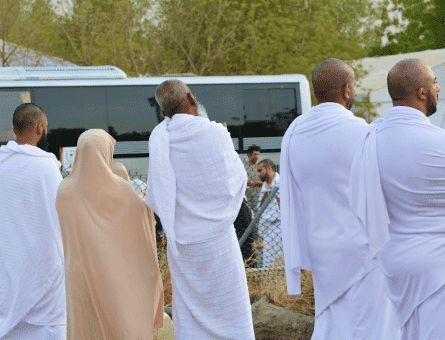
If I fall asleep in the haram, do I need to renew my wudhu?
· 1.8K views
Thanks for your contribution!
We’ve recorded your feedback. A team member will be reviewing this shortly.
Verified by mark
This article has been verified for authenticity by Madain Saleh – Hegra / Al Hijr – History, Facts, Importance – Everything You Need To Know.
“And call to mind when He made you successors after 'Ad and gave you power in the earth so that you took for yourselves palaces in its plains and hewed out dwellings in the mountains. Remember, then, the wondrous bounties of Allah, and do not go about creating mischief in the land.” [Quran, 7:74]
Summary - Madain Saleh
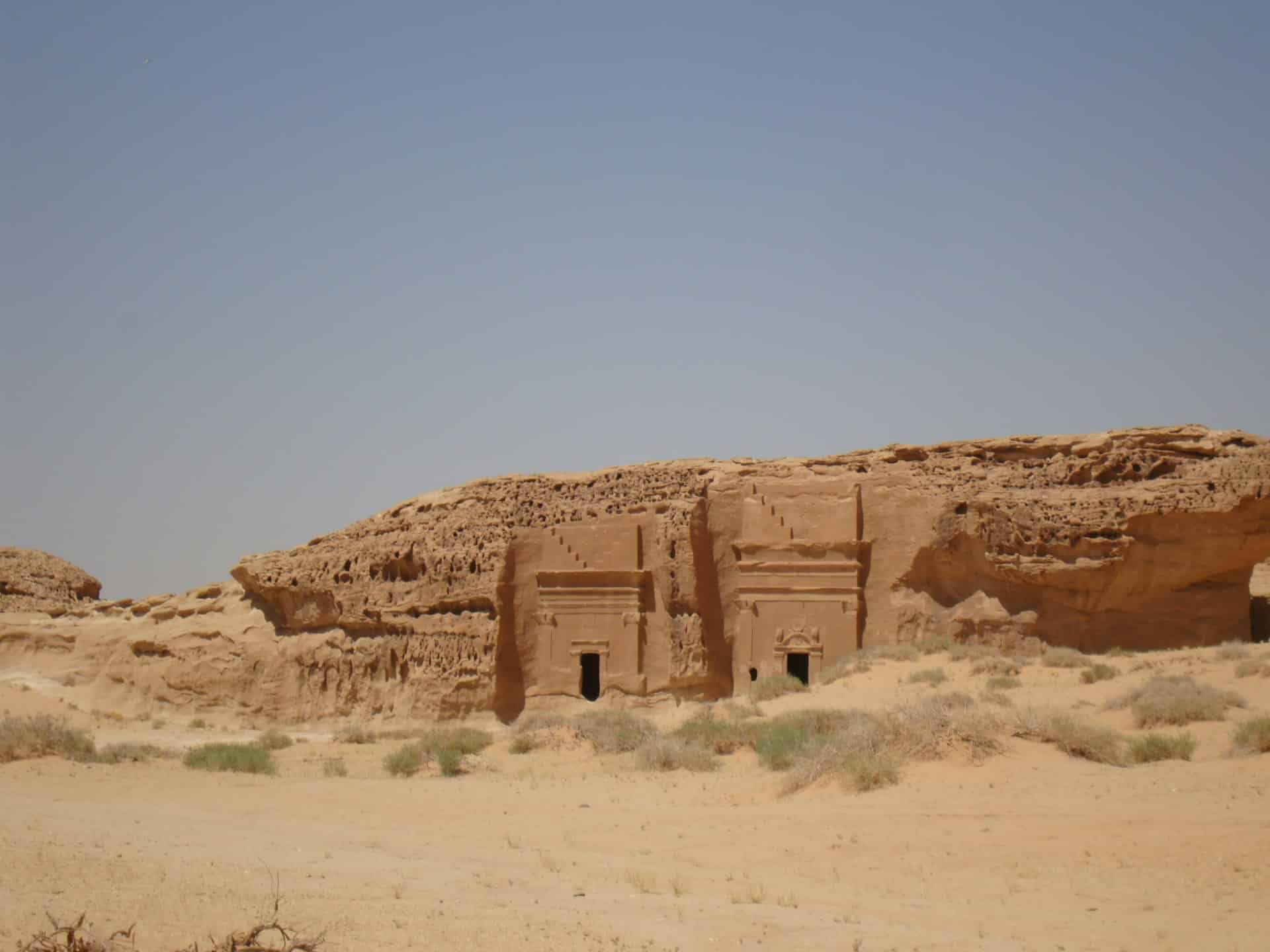
Arabian Rock Art Heritage
The Application of Advanced Imaging Technology to Saudi Arabian Rock Art
Mada’in Saleh

The Nabataeans began as pastoral nomads, raising their sheep, goats, and camels in the desert as so many other Arabian tribes have done through the millennia. They also practiced oasis agriculture, utilizing a set of wells dug into the rock. Their origin is uncertain, but there is a strong possibility that they came from the Hejaz region of northwest Saudi Arabia. The deities they worshipped were similar to those honored by ancient cultures in that area and the root consonants of their name – n, b, t, w – occur in the early Semitic of the Hejaz. From early in their history, they had connections with Mesopotamia and may have been the Nabatu Arabs mentioned by the Assyrians in the eighth century BCE. Alexander the Great’s officer Hieronymus of Cardia wrote of the Nabataeans as having an ascetic life with harsh laws. They were also known for their incredible familiarity with the desert and their ability to fade into it to evade enemy tribes. Their system of hidden cisterns dug deep in the interior provided water for their livestock and their people.
The real cause of the success of the Nabataeans, however, was control over much of the spice trade. Frankincense, myrrh, and other spices from southern Arabia were brought up to the north along trade routes to be purchased by the Greeks, Romans Egyptians, Phoenicians, and others around the Mediterranean and in the Near East. The Nabataeans built their empire as the middlemen. Hegra was a crossroads where the major north-south incense route intersected a road from the Red Sea to the Persian Gulf.
Before the Nabataeans chose Hegra as their most southerly outpost for caravans on the spice route, the settlement was occupied by their predecessors in the trade, the Dedanites and then the Lihyanites. The Qur’an refers to a Thamudic settlement even earlier. The Romans annexed the area controlled by the Nabataeans and incorporated it into its Arabian province in 106 CE.
The ruins of the town of Hegra lie on the plain some distance from their tombs. The buildings, still for the most part unexcavated, were made of unimpressive sun-dried mudbrick. What is known about Hegra comes primarily from the tombs, the many inscriptions carved into their façades, and references found elsewhere.
The tomb façades are finely carved and fairly uniform in their style. At the top of most is a pair of crowsteps rising up from a central point. One or two cornices are just below, resting on the delicate capitals of two pilasters. A portal in the center of the façade provides the entrance to the tomb. Inside are recesses carved into the walls where the bodies of the deceased were placed. The interiors remain roughly chiseled in stark contrast to the smoothly finished façades.
Qasr al Bint, “Palace of the Daughter or Maiden,” is the largest tomb façade at Hegra, with a height of 16 m. It lends its name to a group of adjacent tombs. The portal is raised above ground. Above the doorway is an inscription plaque saying that the tomb was carved by the sculptor Hoor ibn Ahi for Hani ibn Tafsy, his family and descendents, in the 40th year of the reign of the Nabataean King Aretas IV (al-Haritha), dating it to circa 31 CE.
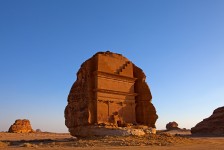
Qasr al-Farid, an unfinished tomb that stands alone.
The most photogenic and most iconic symbol of Mada’in Saleh is Qasr al-Farid, a single tomb carved into a small dome that stands alone in the open. The façade was never finished, so the heavily chiseled surface of the lower third documents how the tombs were fashioned from the top down.
The Jebel Ithlib is a monumental outcrop topped with a complex of spires in the northeastern part of the site. In the middle is a natural slit that measures 40 m (131 feet), called the Siq, after a similar corridor at Petra. At its entrance, to the right is a square chamber containing three stone benches that served as a triclinium for sacred feasts. Today, the chamber is known as al-Diwan (court). Its large entrance suggests that the feasts extended into the open space before it.
By walking through the Siq, one enters a larger, natural alcove known as the Jebel Ithlib sanctuary where a canal channeled water into a cistern. Its enormous cliff faces have small sacred niches and altars carved into their otherwise unhewn surfaces. Jebel Ithlib was thought to have been a holy place to worship the Nabataean deity Dúshara, “Lord of the Mountain”.
Mada’in Saleh has been s a UNESCO World Heritage Site since 2008.
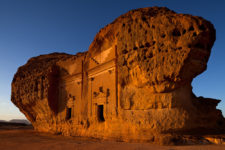
Al Diwan, Mada’in Saleh
In the middle of the Jebel Ithlib is a natural slit that measures 40 m (131 feet), called the Siq, after a similar corridor at Petra.

Madain Saleh

- 1 Understand
- 2.1 By plane
- 3 Get around
- 10 Stay safe
Madain Saleh (مدائن صالح , also Medain Saleh , Meda'in Saleh ) is a large archaeological site in Saudi Arabia .
Understand [ edit ]

Get in [ edit ]
A SR 100 permit is necessary for visiting Madain Saleh. Tour operators or hotels will usually arrange these on your behalf (apply at least one week in advance), or do it yourself at the National Museum in Riyadh.
By plane [ edit ]
The nearest airports are Prince Abdul Majeed bin Abdul Aziz Domestic Airport in Al-Ula (50 km) and Medina (300 km, and yes, the city is open to non-Muslims). Until 2004, visitors usually traveled via Hail (400 km), but a new road from Al Wajh now makes that route considerably faster.
By car [ edit ]
The nearest town of any size is Al-Ula (or Al-Oula ), 22 km away from Madain Saleh. Saptco runs direct buses to Al-Ula from major towns including Jeddah (8 hr) and Riyadh (13½ hours).
Get around [ edit ]

See [ edit ]

The main attraction are of course the rock-carved tombs . You should take most of a whole day to drive around the various rocks. Unfortunately the guides seem to be very light on historic knowledge, and some may make up things as they go along. Reading up on the Nabatean culture before you visit would make the stay more enjoyable, the graves do after all look pretty similar and you may get 'templed out' after seeing two dozen of them without background knowledge. There are no facilities inside the area, take food and plenty of water with you in the car. The area is also nice for hiking among the big rocks, however make sure your police escort allows you to do so. They may not follow you all the time but start a search when they notice you've gone "missing".
A restored Hijaz Railway station can be found on the northern side of the city. Facilities all set up and ready for tourists (as of 2000 anyway), but locked tight as a drum! Travel around inside as much as possible, there are many little interesting things to see. Use of steel sleepers stolen from the railway for all sorts of agricultural uses, and so on.
There is also the old town of Al-Ula just outside the city. The tight quarters of small mud buildings are mostly deteriorated, however in 2011 the Ministry for Antiques was renovating parts for tourists. Next to the town is a rock with something like an little fort on top that can be climbed for a nice overview. The old town will usually be part of the tour if you hire a guide for Madain Saleh.
Another destination is the mountain next to Al-Ula from where you can enjoy a panoramic view over the valley if the air is not too dusty. Often your guide will suggest this destination as well.
Lastly, where there are large rocks there is bound to be an " Elephant Rock ", and Al-Ula also has its own. Ask your guide for details, it's not far from the city.
Do [ edit ]
Buy [ edit ], eat [ edit ].
During your visit to the Madain Saleh area, you can eat good food in your hotel, (ARAC Al-Ula Hotel 4+ stars), it offers good and clean food, also if you want to try the local food you can visit to nice and clean restaurants in the city of Al-Ula. Your tour guide should guide you to the best places to eat.
Drink [ edit ]
Sleep [ edit ].
Staying overnight at Madain Saleh is not allowed, so most visitors use a hotel in Al-Ula.
You can, if so equipped, camp quite close to the gates of Madain Saleh quite readily. There are organised tours which set up outdoor camps in a very luxurious fashion near the entrance.
Stay safe [ edit ]
Al-Ula/Madain Saleh is as safe as the rest of Saudi Arabia. However, three French nationals were killed in the area in 2007, presumably by terrorists. If you register for visiting the historic sites, a police escort will likely be assigned to your group and follow you around the area. They may also insist on escorting you on your way back on the highway all the way to Medina.
Connect [ edit ]
Go next [ edit ].
- Has custom banner
- Has mapframe
- Has map markers
- North (Saudi Arabia)
- All destination articles
- Outline cities
- Outline articles
- City articles
- Has Geo parameter
- Pages with maps
Navigation menu
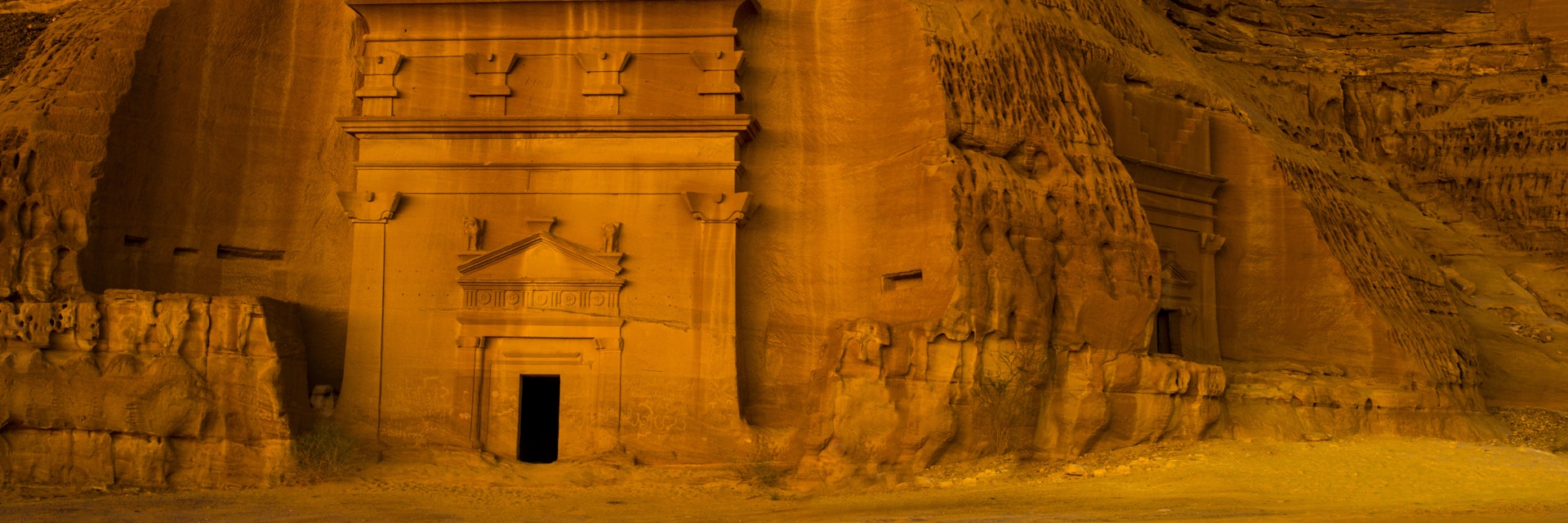
Getty Images
Madain Saleh
Top choice in Northern Saudi Arabia
Often dubbed the 'second Petra', Madain Saleh, for many, is on a par with – if not more impressive than – its famous cousin across the border in Jordan. Both were major trading cities along the ancient Nabataean trade routes, as confirmed by recent excavations that have revealed the foundations of houses and a market area for traders and caravans. However, it's the 131 enigmatic tombs, which combine elements of Graeco-Roman architecture with Nabataean and Babylonian imagery, that grab all the attention.
At the time of research the site was closed for refurbishment and due to reopen in October 2020, when the Hejaz Railway station within the site will become the new visitor centre for the signposted main entrance off Route 375. Given Saudi Arabia's track record of abruptly closing and opening major tourist sights, however, it is best to call the contact centre ahead of any attempted visit.
At the main entrance of the site is the Madain Saleh station of the Hejaz Railway , soon to become the visitors centre. Built in 1907, it consists of 16 buildings and includes a large workshop (with a restored WWI-era engine), shells of train carriages and a rebuilt Turkish fort that served as a resting place for pilgrims travelling to Mecca.
Qasr Al Saneh reveals many of the essential elements of Nabataean funerary architecture: a relatively unadorned facade, two five-step motifs at the top, a simple interior burial chamber with shelves for corpses, and inscriptions above the doorway. Built around AD 50, Qasr Al Saneh was in use for just 50 years before the Nabataean kings were overwhelmed by the Romans.
Al Khuraymat , about 750m north of Qasr Al Saneh, has some of the best-preserved tombs in Madain Saleh – around 20 tombs are carved into the rock face. Look out for elegant gynosphinxes (spirit guardians with women’s heads, lions’ bodies and wings) adorning the corners of pediments. There is some archaeological evidence of plasterwork on the facades and a suggestion that people feasted outside familial tombs – a Nabataean ‘Day of the Dead’. The Nabataeans were masters of hydrology and manipulated rain run-off and underground aquifers to thrive in the desert landscape. The great Nabataean Well was one of more than 60 wells currently known of in the city. The wall supports – added in the 20th century – were built from railway sleepers pilfered from the Hejaz Railway. The Al Mahajar tombs are especially photogenic and some of the oldest at Madain Saleh.
Al Diwan , carved into a hillside to shield it from the wind, is one of the few extant examples of nonfunerary architecture in Madain Saleh. The name ( diwan means 'living room') owes more to modern Arab culture than to the Nabataeans, who probably used the area for sacred feasts. Opposite the hollowed-out room, which contains three benches and a large entrance suggesting that the feasts extended outdoors, are niches cut into the rock where Nabataean deities were carved. Exposure to the elements has badly weathered these carvings.
Running south from Al Diwan is the Siq , a narrow passageway measuring about 40m wide between two rock faces lined with more small altars. At the far end is a striking natural amphitheatre . Climb along the southeastern slope up to a number of altars. From here, look west and soak in the breathtaking views.
Qasr Al Bint (Palace of the Daughter) consists of a wonderful row of facades that makes for dramatic viewing from across Madain Saleh. The east face has two particularly well-preserved tombs. If you step back and look up near the northern end of the west face, you’ll distinguish a tomb that was abandoned in the early stages of construction and would, if completed, have been the largest in Madain Saleh – only the step facade was cut. These tombs date to about AD 31.
Qasr Farid in the south is the largest tomb of Madain Saleh and perhaps the most stunning. It's carved from a free-standing rock monolith, in a location that gives it a rare beauty. Try to arrive for sunset, when the enigmatic tomb passes through shades of pink and gold until darkness falls: breathtaking.
Jebel Al Ahmar Area C i s in the southeastern portion of Madain Saleh and features three tombs with drawings dating to between AD 16 and AD 61. The tombs are burial chambers without special adornments.
off Route 375
Get In Touch
https://www.sauditourism.sa
Lonely Planet's must-see attractions

Al Ula Viewpoint
12.61 MILES
The views as you wind your way up to this gem of a spot offer glimpses of what's to come. At the top, the road plateaus through a windswept, lunar…

Al Ula Heritage Village
12.82 MILES
There are plans to make this a formal tourist venue in the near future, but for now you can enjoy freely wandering among the beautiful mud ruins where…

Jebel Khuraibah
11.36 MILES
The fortress and three peaks of Jebel Khuraibah once formed part of the capital of the ancient Kingdom of Lihyan. Rock-cut tombs squat at the foot of the…

Al Ula Fort
12.81 MILES
To protect the ancient village, inhabitants in the 6th century used red-sandstone blocks to build this castle on a promontory that gives a 360-degree view…

Elephant Rock
Arabia's only 'elephant' is a huge red rock three storeys in height. The enormous 'body' connects to a slimmer 'trunk' that bulges in just the right areas…

Al Ula Antiquities & Heritage Museum
13.94 MILES
This small museum is attractively designed, with some intriguing and informative displays on the history, culture, flora and fauna of the area, as well as…

Umm Al Daraj
11.87 MILES
A few kilometres north of old Al Ula, Umm Al Daraj (Mother of Steps) is worth a detour. Climbing the hill reveals three red-sandstone religious structures…

Mt Almejder
This 300m-high mountain east of Al Ula features stone settlements and caves with pre-Islamic inscriptions and drawings, but there was no access to it at…
Nearby Northern Saudi Arabia attractions
1 . Elephant Rock
2 . Jebel Khuraibah
3 . Umm Al Daraj
4 . Mt Almejder
5 . Al Ula Viewpoint
6 . Al Ula Fort
7 . Al Ula Heritage Village
8 . Al Ula Antiquities & Heritage Museum
Saudi Arabia’s Hidden City: Exploring Mada’in Saleh

Little is known about the ruined city of Mada’in Saleh and the archaeological puzzle at the heart of the ancient Nabataean civilisation. Yet this pre-Islamic site is one of Saudi Arabia’s greatest treasures, proclaimed as the Kingdom’s first UNESCO World Heritage site in 2008 and comparable to Jordan’s Petra, but without the crowds. The Nabataeans remain a mysteries people, but by exploring the ruins of their southern city glimpses of their ancient history appear.

Located in the Al Madinah region, halfway between Petra and Medina, Mada’in Saleh is a ruined city that once served as the second capital of the Nabataean Kingdom . Although the site is under police surveillance and is challenging to visit even today, with special arrangements more and more travellers are discovering this archaeological treasure, walking freely among the exceptional ruins cut directly into the surrounding sandstones. All that is known about Mada’in Saleh is gleaned from the inscriptions displayed on the site, which consists of over 100 decorated tombs and more than 1000 non-monumental graves, bearing both inscriptions and cave drawings. Although similar to Jordan’s Petra , the Nabataean city of Mada’in Saleh surpasses its better known neighbour. The multi-ethnic symbols and datable graves of the site, as well the the unique sandstone cave structures, enable a better understanding of the Nabataean tribe and Mada’in Saleh, an ancient city that once served as the most important stop on the caravan route between Southern Arabia and the Jordan Valley.

Thanks to the recent archaeological investigations Mada’in Saleh is slowly disclosing its hidden treasures, and the most acclaimed and iconic parts of the site today are Qasr al Bint and Qasr Al-Fareed . While, the former is the Palace of the Daughter, which, with its 16m height is the largest tomb at Mada’in Saleh, the latter stands independently as a huge tomb construction carved into the cliff. Though the tomb was never finished, the following dedication is visible, carved into the stone: ‘To Hayyan, the Son of Kuza and his descendants’. The Mada’in Saleh ruins are surrounded by hills yet lie on a deserted, volcanic plateau which, thanks to sustainable water sources and fertile soil, has always attracted settlers. The Nabataeans were able to use the natural features offered by the desert, exploiting them to raise Mada’in Saleh to be the crossroads not only for trade but also for the different cultures and civilizations for a millennium. This skill earned the Nabataeans the label ‘one of the most gifted people of history’ by Nelson Glueck , who was among the first to look deeper into the Nabataeans’ endeavours.
Like so many Arabian tribes, the Nabataeans were originally a nomadic, tent-dwelling pastorals and traders, who raised livestock and developed pioneering oasis agriculture, establishing wells and rainwater tanks. By the 1st century BC Mada’in Saleh already flourished as a city, recognised for its trade with spices, aromatic plants, myrrh and incenses, and until the expansion of the Roman Empire it stood as part of an independent, wealthy Kingdom. What caused the Kingdom’s gradual decline was the shift in urbanisation and commercialisation techniques, which unstoppably altered conventional trade roads and emphasised maritime trading through the Red Sea. In 106 BC the Nabataean Kingdom was annexed to the Roman Empire, which led to the assimilation and eventual cultural absorption of the Nabataeans. Despite Mada’in Saleh’s obvious historical importance, relatively few archaeological investigations were made in the area until the 21st century. Several sections of the site still remain unexcavated, but current archaeological thought maps the site into three main areas.

The first of these encountered by a visitor to the site is the ancient city itself, which was built in the first century BC. This is the least understood section of Mada’in Saleh , as the majority of the ruins are still covered by sand. Tentative excavations have revealed everyday objects such as ceramics and coins, as well as traces of a probable citadel, a city wall and a church. The second part of the site is Jabal Ithlib , which served as the main place of worship, most probably to Dúshana , the ‘Lord of the Mountains ’ . Located on the northeast of the site and surrounded by rocky peaks, Mada’in Saleh resembles Petra by the embraced and iconic Siq-glen, a 40 metre high carved rock ‘corridor’ giving out onto stunning views of the Diwan, or central court, one of Mada’in Saleh’s most visited parts. The final area, which hides the antique tombs, is undoubtedly the most important and most significant section of this archaeological site. This area is the home over 100 monumental tombs dating back to the era between 0-75 CE. Though it might appear as if the tombs are be identical, a closer look reveals that they differ in their details. Each tomb shows an immerse façade decorated by mythic figures: masks, eagles, lions and serpents. The epitaphs of the tombs display the moments from the life and death circumstances of the deceased, clearly indicating the social status of each buried person. In contrast to the ornamented doorways, the interior of the tombs is lacking in decoration. What happened in Mada’in Saleh over the centuries is rather obscure. References to the city throughout history are sporadic: Arab explorer Al-Mawdasi visited in the 10th century, Ibn Battuta wrote about the area in the 14th, and in the book of Travels in Arabia Deserta by Charles Doughy , a Victorian explorer. The real breakthrough came only in the 20th century, when the Hejaz railway line was reconstructed to link Damascus and Jerusalem . This infrastructural development provided better accessibility to the site, but it also damaged some of the archaeological elements. The excavations, however, were put on hold between the First World War and 1960 and since then, the greatest step was taken by the joint collaboration of France and the Kingdom of Saudi Arabia to study the site in a non-destructive manner. Between 2008 and 2012 these joint forces undertook the most extensive excavations yet, which led to Mada’in Saleh’s elevation to a UNESCO heritage site in 2008. Mada’in Saleh’s cultural and architectural integrity is remarkable thanks to the dry climate and paucity of investigations, which have ensured that the site is well conserved. Regardless of its natural beauty and cultural significance, historically the ruins have rarely been visited by Saudis themselves due to rumours of an ancient curse originating from the Koran; this has left the time-travel tourism experience to western tourists and archaeologists. Though pieces of the Nabataean puzzle are still undiscovered, the excavations at Mada’in Saleh are slowly uncovering the mysteries of the Nabataean kingdom. By Virág Gulyás

Become a Culture Tripper!
Sign up to our newsletter to save up to 500$ on our unique trips..
See privacy policy .

KEEN TO EXPLORE THE WORLD?
Connect with like-minded people on our premium trips curated by local insiders and with care for the world
Since you are here, we would like to share our vision for the future of travel - and the direction Culture Trip is moving in.
Culture Trip launched in 2011 with a simple yet passionate mission: to inspire people to go beyond their boundaries and experience what makes a place, its people and its culture special and meaningful — and this is still in our DNA today. We are proud that, for more than a decade, millions like you have trusted our award-winning recommendations by people who deeply understand what makes certain places and communities so special.
Increasingly we believe the world needs more meaningful, real-life connections between curious travellers keen to explore the world in a more responsible way. That is why we have intensively curated a collection of premium small-group trips as an invitation to meet and connect with new, like-minded people for once-in-a-lifetime experiences in three categories: Culture Trips, Rail Trips and Private Trips. Our Trips are suitable for both solo travelers, couples and friends who want to explore the world together.
Culture Trips are deeply immersive 5 to 16 days itineraries, that combine authentic local experiences, exciting activities and 4-5* accommodation to look forward to at the end of each day. Our Rail Trips are our most planet-friendly itineraries that invite you to take the scenic route, relax whilst getting under the skin of a destination. Our Private Trips are fully tailored itineraries, curated by our Travel Experts specifically for you, your friends or your family.
We know that many of you worry about the environmental impact of travel and are looking for ways of expanding horizons in ways that do minimal harm - and may even bring benefits. We are committed to go as far as possible in curating our trips with care for the planet. That is why all of our trips are flightless in destination, fully carbon offset - and we have ambitious plans to be net zero in the very near future.

The Ancient Saudi Arabian City Perfect for Modern Travellers

Racing Around the World With Extreme E Driver Jamie Chadwick

Places to Stay
The best spa hotels in saudi arabia.

The Best Hotels in Saudi Arabia for Every Traveller

See & Do
Reflections on an incredible mirrored building in the saudi arabian desert.

Racing Around the World's Most Extreme Locations

Health & Wellness
Feminists in saudi arabia use underground radio station to push for women’s rights.

Ithra: The Creative Hub Driving Saudi Arabia's Cultural Renaissance

Saudi Fashion Designers to Watch

Saudi Design Week: A Celebration of Heritage and Sustainability

Your Guide to Saudi Fashion Week

These Are the Best Apps for Muslims
Winter sale offers on our trips, incredible savings.

- Post ID: 123277
- Sponsored? No
- View Payload

- Get Involved
Madain Saleh (al-Hijr)
The Mada'en Saleh (مدائن صالح), also known as al-Hijr I (ٱلْحِجْر), is located amid a series of interlocking mountains and rocky cliffs and surrounded by a ring of sandy mountains. al-Hijr was mentioned in the Holy Qur'an , and described as the home of the Thamud . Located today in al-Ula governorate a subdivision of al-Madinah al-Munawarah Province of Saudi Arabia, the Mada’in Saleh (“the cities of Salih”) are the remains of the once wealthy and powerful Nabataean kingdom.
Contents Hide/Show
Why we're running ads? The Madain Project is a very unique resource of Abrahamic History & Archaeology; reaching more than half a million readers a month. Until February 2021 all the operational and management costs were being paid by the volunteers working on the project. But, the increase in the userbase and the overall costs of servers and other services and equipment that are needed to remain live forced us to look for other avenues of inflow.
We apologise about it. We apologise for the inconvenience that ads bring to your reading experience; we're working on a membership model for the Madain Project which will provide you with an absolute ads-free reading. Right now we need your help. Please Donate. As of now, we rely on donations from patrons like you to supplement the funding and keep the Madain Project website up and running. Your contribution will help us cover the costs of maintaining and improving our website, creating new educational content, and reaching even more enthusiasts around the world. Donate Now
Cite this article
How to copy: Click the citation text to copy it to the clipboard.
Note: Always review your references and make any necessary corrections before using. Pay attention to names, capitalization, and dates. If you need to mention authors, you can add " the Editors of the Madain Project ". The publication date given in the citations reflect the most recent update of the article and not the original publication date; you may wanna check the article's history to see how it has evolved over time. Use a citation tool .
Want to use our images?
The Madain Project owns the copyright to the Madain Project (en) including (i) the artwork and design of the www.madainproject.com website (Madain Project Website); and (ii) all electronic text and image files, audio and video clips on the Madain Project Website (MP Material) excluding material which is owned by other individuals or organizations as indicated.
Users who would like to make commercial use of Madain Project Material must contact us with a formal written request (i) identifying the MP Material to be used; and (ii) describing the proposed commercial use. Madain Project will review such requests and provide a written response. The Madain Project reserves the right to charge a fee for any approved commercial use of Madain Project Materials.
The Madain Project has an extensive archive of photographs, which is only partially featured on our website. If you cannot find the photographs you're looking for; just send us an email detailing the required site, structure or even illustration. The archives department will definitely assist you in finding the best possible image for your new project.
Madain Saleh is considered to be the most important settlement of the Nabataeans, second only to Petra . Its most significant cultural role dates back to the first two centuries BCE and first century CE, i.e., during the flourishing Nabataean state and before its fall at the hands of the Roman Emperor in 106 CE Al Hijr continued to be a source of cultural energy and intellectual interaction probably until the 4th century CE These are said to be the tombs of Qom e Thamud , as are considered cursed by the Muslims.
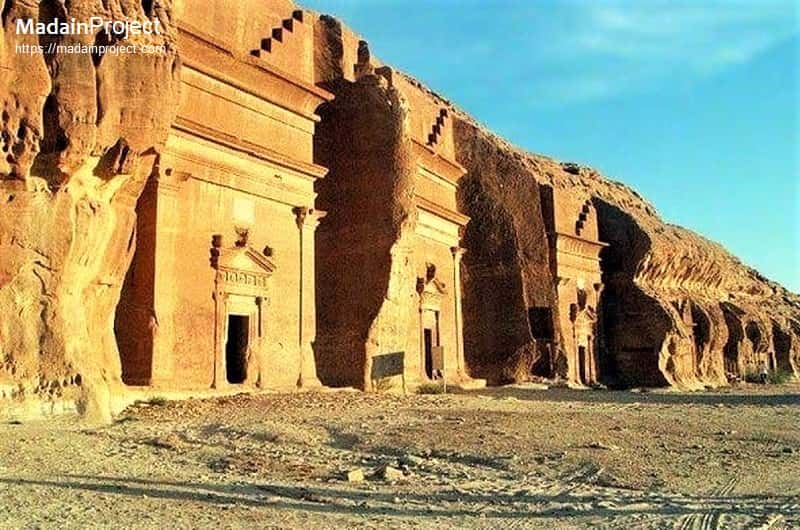
Notable Structures
circa 100 CE

Jabl al-Ahmar Jabl al-Ahmar (جبل الاحمر) also known as the Area C is an outcrop in the southeastern part of Mada’in Saleh that contains numerous tombs, dating to 16-61 CE. It is located in the southeastern portion of Madain Saleh and features three tombs with drawings dating to between CE 16 and CE 61. The tombs are burial chambers without special adornments. Consists of a single isolated outcrop containing 19 cut tombs, and no ornamentations were carved on the façades.

ad-Diwan The triclinium style ad-Diwan (ديوان), also spelled as al-Diwan, is a square chamber containing three stone benches that served as a triclinium for sacred feasts. Today, the chamber is known as al-Diwan (court). Its large entrance suggests that the feasts extended into the open space before it. The Diwan itself was a place reserved for religious gatherings and consisted of a rectangular room carved in the rock measuring 12.8 x 9.9 metres and 8 metres in height.
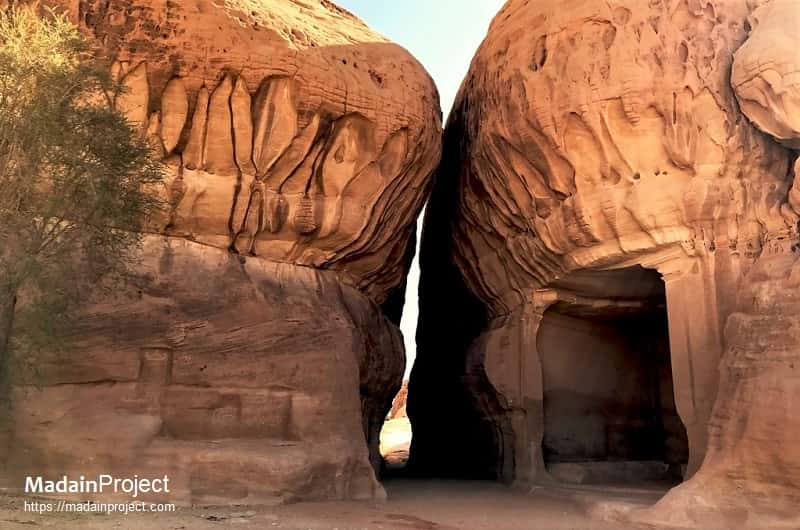
al-Siq The narrow passageway known as the al-Siq (السيق), reminiscent of the Siq in Petra , runs towards the south from al-Diwan, measures about 40m wide between two rock faces lined with more small altars. The jagged cliff walls of the siq, the natural passageway leading to Jabal Ithlib, had decorated votive niches to Nabatean gods carved into the rock and petroglyphs of camels and traders.

Qasr al-Bint The Qasr al Bint (قصر البنت), “Palace of the Daughter or Maiden,” is the largest tomb façade at Mada’in Saleh, with a height of 16 m. It lends its name to the group of adjacent tombs as well. The portal is raised above ground. Above the doorway an inscription plaque indicates that it dates to circa 31 CE. It consists of a wonderful row of facades that makes for dramatic viewing from across Madain Saleh. The east face has two particularly well-preserved tombs.

Qasr al-Farid The Qasr al-Farid (قصر الفريد), an unfinished tomb that stands alone. The facade was never finished, so the heavily chiseled surface of the lower third documents how the tombs were fashioned from the top down. It is the most photogenic and most iconic symbol of Mada’in Saleh, a single tomb carved into a small dome that stands alone in the open. The façade was never finished, so the heavily chiseled surface of the lower third documents how the tombs were fashioned from the top down.

Qasr al-Sanea The Qasr al-Sanea (قصر الصانع), was one of the first tombs to be carved in the al-Hijr area. It served as a prelude to the other Nabataean architectural style tombs. It is one of the best preserved tombs in Madain Saleh. It represents an introduction to the key elements of the style of the Nabatean’s tombs. It has a great facade, with five stepped crow-steps, and the inscriptions at the top of the door and the niches inside the structure into which the dead bodies were placed.

Unfinished Tomb
Ottoman Caravanserai

Between 1744 and 1757, a fort was built at al-Hijr (Madain Saleh) on the orders of the Ottoman governor of Damascus, As'ad Pasha al-Azm. A cistern supplied by a large well within the fort was also built, and the site served as a one-day stop for Hajj pilgrims where they could purchase goods such as dates, lemons and oranges. It was part of a series of fortifications built to protect the pilgrimage route to Mecca.
- People of Thamud
- Ubar: Iram of the Pillars
- Hammond, Philip C. The Nabataeans--Their History, Culture and Archaeology. Gothenburg, P. Åström (S. vägen 61), 1973.
- " Al-Hijr Archaeological Site (Madâin Sâlih) ". UNESCO. Retrieved 2014-04-07.
- Abu-Nasr, Donna (2009-08-30). " Digging up the Saudi past: Some would rather not ". Associated Press. Retrieved 2014-04-07.
- " HISTORY: Expansion of the Nabataeans ". Historical Madain Salih. Retrieved 2014-04-07.
- The New Encyclopædia Britannica: Macropædia Volume 13. USA: Encyclopædia Britannica, Inc. 1995. p. 840. ISBN 0-85229-605-3.
- " The Online Corpus of the Inscriptions of Ancient North Arabia ". krc.orient.ox.ac.uk. Retrieved 2016-07-15.
- The Historical Record of Ibn Khaldon, Volume: 2, Page: 641
- Taylor, Jane. Petra and the Lost Kingdom of the Nabataeans. Cambridge, MA: Harvard University Press, 2002.
- " Move Under Way to Restore Madain Salih Railway Station ". Arab News. 2006-06-22. Retrieved 2014-04-07.
- Encyclopædia Britannica, Under the Category of: History of Arabia, the Section of: Dedān and Al-Ḥijr.
- Sahih al-Bukhari, Narrated: ʿAbdullah ibn ʿUmar, Hadiths: 2116 & 3379.
- Baker, Randall (1979). King Hussein And The Kingdom of Hejaz. p. 18. ISBN 0-900891-48-3.
- Hoyland, Robert G. (2001). Arabia and the Arabs: From the Bronze Age to the Coming of Islam . Routledge. p. 69. ISBN 0415195349.
- " HISTORY: Explanation of the Verses ". Historical Madain Salih. Retrieved 2014-04-07.
- M. Th. Houtsma et al., eds., E.J. Brill's first encyclopaedia of Islam, 1913-1936.
- Hizon, Danny. " Madain Salih: Arabia's Hidden Treasure – Saudi Arabia ". Retrieved 2009-09-17.
- Kitab Al-Aghani, Abu Al-Faraj Al-Asfahani, Volume: 4, Page: 74
- The Detailed History of Arabs before Islam, Prof. Jawwad Ali, Volume: 15, Page: 301
- Al-Talhi, Dhaifallah. (2000). Mada'in Salih, a Nabataean town in north west Arabia: analysis and interpretation of the excavation 1986-1990.
- " Madain Salih – Cities inhabited by the People of Thamud ". Retrieved 2009-09-17.
- Ibn Kathir (2003). Al-Bidâya wa-l-Nihâya ("The Beginning and the End") Vol.1. Beirut: Dar al-Kutub al-Ilmiyya. p. 159.
- Harrison, Timothy P.. "Ḥijr." Encyclopaedia of the Qurʾān. General Editor: Jane Dammen McAuliffe, Georgetown University, Washington DC. Brill Online, 2016.
- Bowerstock, G. W. Roman Arabia. Cambridge, MA: Harvard University Press, 1983.
- Healey, John F. The Nabataean Tomb Inscriptions of Mada'in Salih. Oxford: Oxford University Press, 1993.
Let's bring some history to your inbox
Signup for our monthly newsletter / online magazine. No spam, we promise.
Privacy Policy
We need your help!
We are a small non-profit organization of volunteers, academics, history enthusiasts and IT professionals publishing the world's largest Abrahamic history encyclopedia. We only need £16,095/- to stay live in the year 2024 CE. We, the volunteers, contribute most of the funding ourselves and some comes from running the ads.

The Madain Project is an online archive of Abrahamic History and Archaeology.
Abrahamic History & Archaeology is the study of history and archaeology with respect to the three Abrahamic Faiths without considering the religious and theological aspects. The goal of Abrahamic History is to understand how and why the religious doctrines and behaviours have evlovled and changed over time. Searching for patterns in the evolution of significant cultural events such as the development of farming, the emergence of cities, or the collapse of major civilizations for clues of why and how these have influenced the three major Abrahamic religions.
About - Help - Privacy Policy - Contact Madain Project: Encyclopedia of Abrahamic History & Archaeology. Copyright 2017 - 2024.
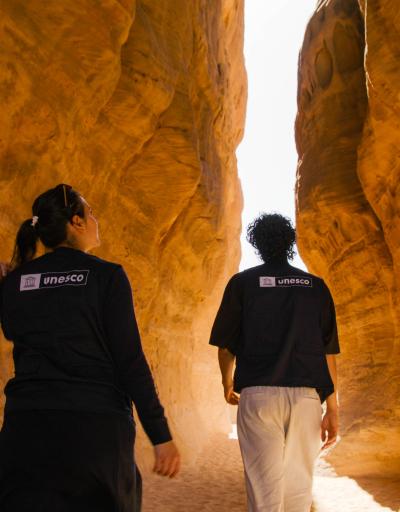
- About the project
- Documentary heritage
Hegra (Mada'in Saleh)
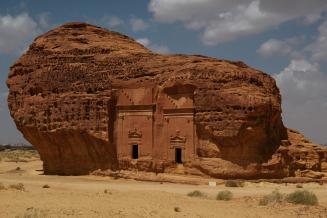
Related items
- Information and communication

Madain Saleh: Saudi Arabia’s 2,000-year-old UNESCO Heritage Site and sister city of Petra
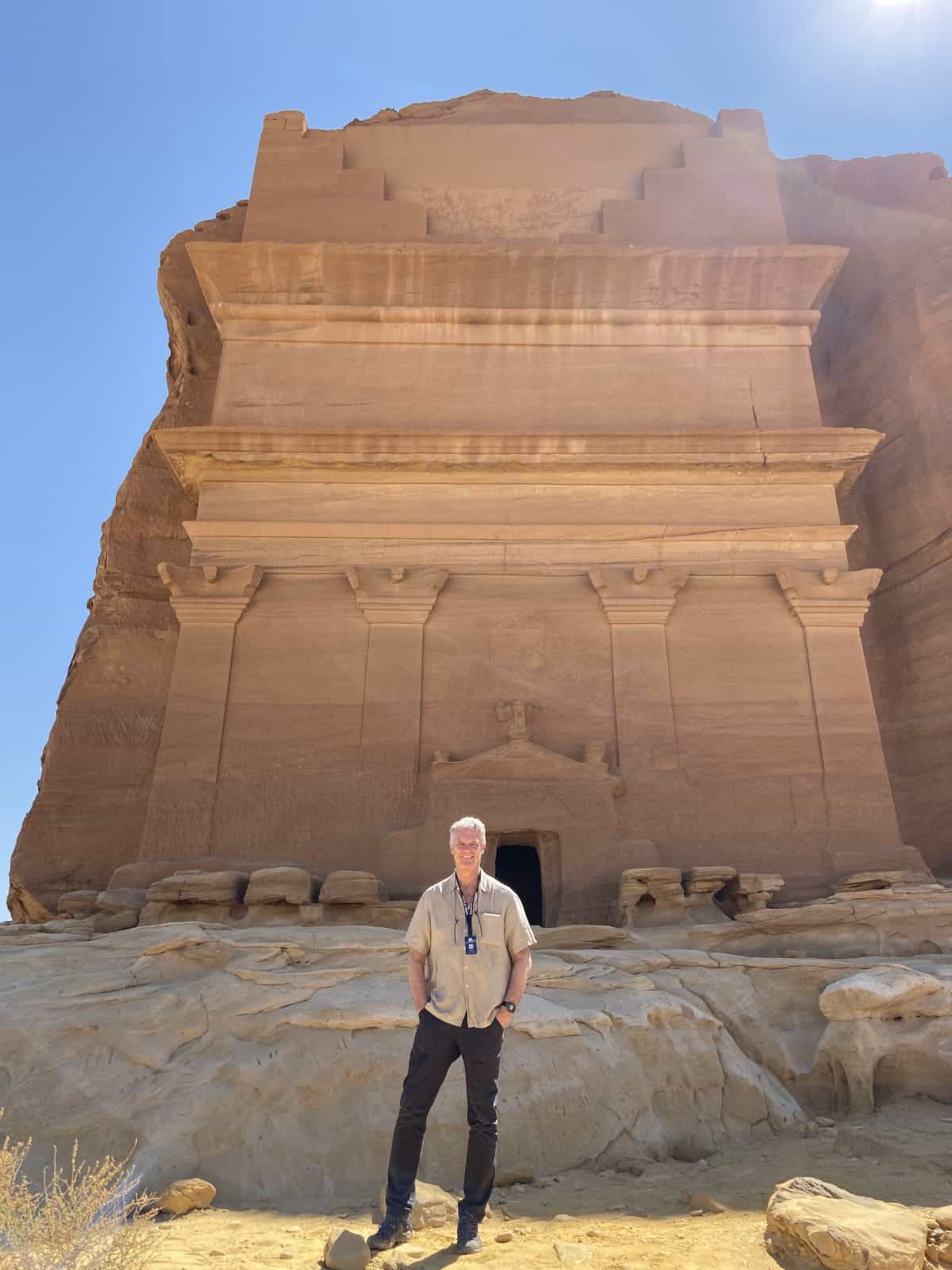
Tough to reach but Madain Saleh is worth some days in the desert
(This is the last of a three-blog series on my travels through Saudi Arabia.)
AL-ULA, Saudi Arabia — If you look at my tent from the right angle, my home for the next three days could pass for a Bedouin nomad’s. It is big, square and white as a sheikh’s robe. It’s a scimitar throw from a grove of palm trees, all glistening in the sun with sheer mountains of red rocks rising in the high desert beyond.
But where is my camel? Nowhere. Parked next to my tent is a Chevrolet Spark. It’s the car I rented to explore one of the few famous tourist sites in a country in the infancy of tourism.
I have decamped at Rural tents Naseem Alouzaib, a collection of comfortable tents 12 miles north of Al-Ula. A town of about 32,000, Al-Ula is Arabic for “In the middle of nowhere.” To me, an intrepid traveler running out of places off the beaten path, this adds to the intrigue. Al-Ula is in northwest Saudi Arabia, 25 miles northwest of Medina, next to Mecca Arabia’s holiest city; 145 miles east of the Red Sea; 410 miles north of Jeddah, Arabia’s cosmopolitan jewel; and 630 miles west of Riyadh, the capital.
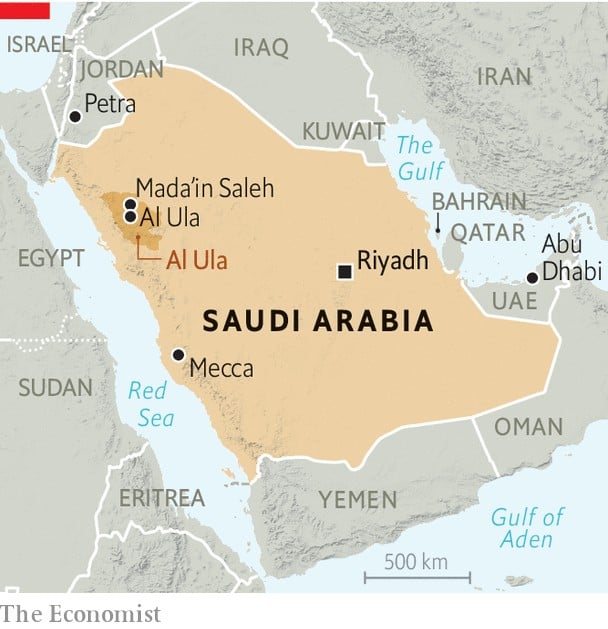
Al-Ula is the jump off point to Madain Saleh , the second city in the Nabataean Kingdom from 2,000 years ago and Saudi Arabia’s first UNESCO World Heritage Site from 2008. It’s the sister city of Petra, Nabataea’s better-known capital 310 miles northwest in Jordan. Petra has attracted people since 7,000 B.C. Madain Saleh has attracted them mainly for about nine months or about the time the Saudi Arabian government finally started issuing tourist visas.
While I researched Saudi Arabia, numerous sources said there is no reason to come if you don’t see Madain Saleh. It’s like visiting Egypt and not seeing the Pyramids.
Al-Ula is one of the few towns in the middle of a desert but at 2,800 feet it has all the raw beauty of Saudi Arabia’s Empty Quarter in the south without the skin-searing heat. And today, in February, it’s downright cold.
For 10 days in Saudi Arabia I lugged around a black leather jacket, looping it over my shoulder as I went from airport to taxi, taxi to hotel, hotel to airport in highs of about 80. Finally I have it on, huddling in my tent as the sun sets and the temperature drops like I cold rainstorm. The Bedouins roughed it more than I. My tent has two twin beds surrounding a big electric heater. I’m writing this under a thick comforter with another in a plastic case at the foot of the bed.
After the urban sprawl of Riyadh and the seaside chic of Jeddah, Al-Ula seems like the back of beyond. The people are few. The roads are empty. But 2,000 years ago, this area was one of the most important in the Middle East.
The Nabataeans helped fuel the trade routes between the southern Persian Gulf and North Africa. They had one of the most sophisticated water systems in history and an educated, open-minded population famous for their artistry and elaborate tombs, all still on display today. Madain Saleh, considered the “Capital of Monuments” among Saudi Arabia’s 4,000 archeological sites, remains one of the great urbanization stories in man’s history.
That is why I am here. That and to sleep in a tent in the middle of the Arabian desert .
How to get there
Getting from Jeddah to Al-Ula exposes some of the rough edges of Arabian tourism. There are only three direct flights a week from Jeddah. If you don’t want to arrive on one of those two days — as I do not — I leave Jeddah at the ungodly hour of 2:20 a.m., land in Riyadh at 4 a.m., try to stay awake for three hours then take a 7 a.m. flight west to Al-Ula at 8:45 a.m. That’s 6 hours, 25 minutes to fly 400 miles.
Arriving at Al-Ula’s small, sparkling clean airport, the car rental company’s promise of a representative with my name on a board never materializes. Besides bringing back nasty flashbacks of getting stood up in airports by various women, it left me with no car in an area with no mass transit. In the middle of the Arabian desert, a woman was the last thing on my mind.
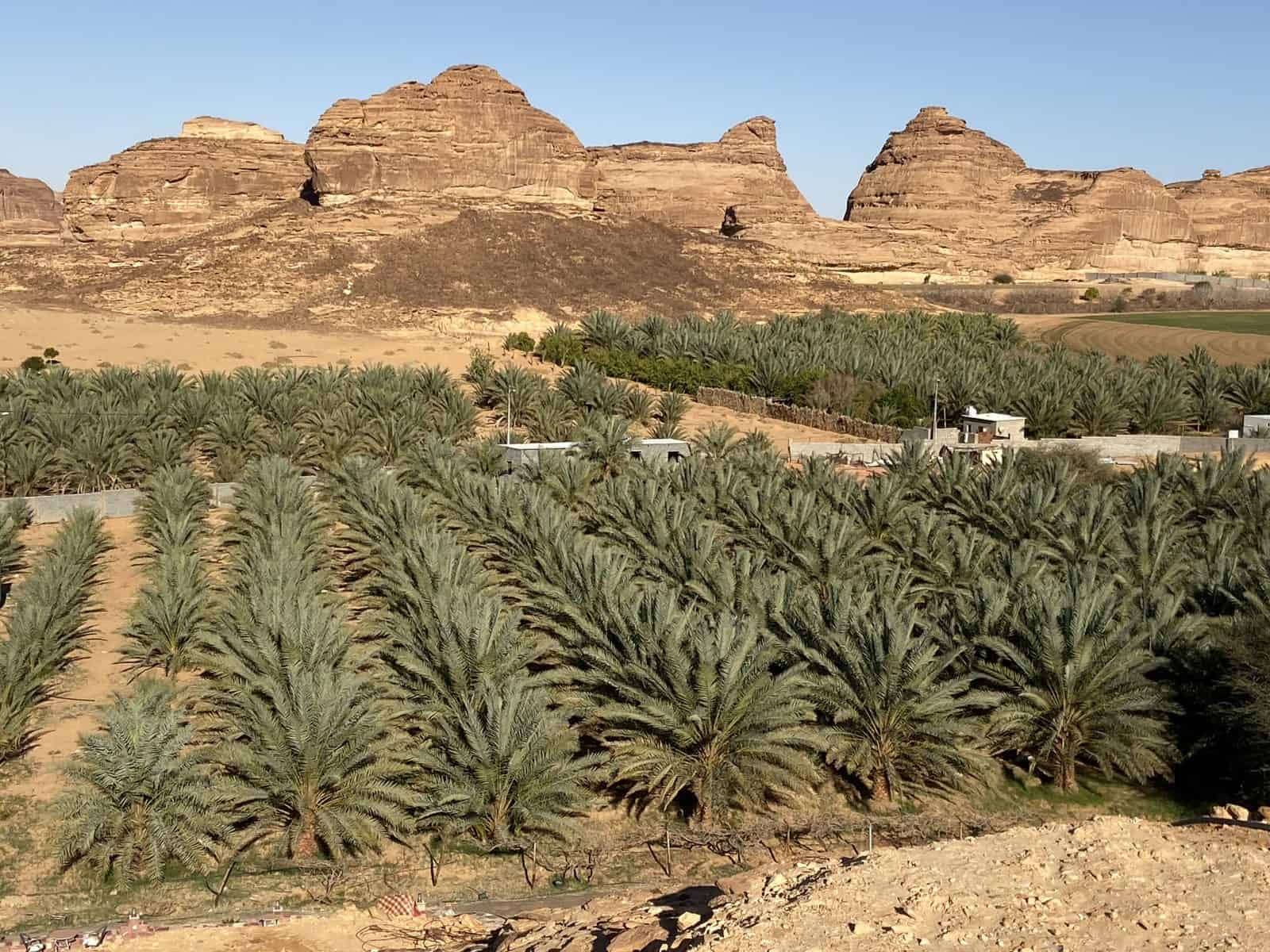
A couple of crisp text messages to a Riyadh travel agent and the rental company produce nothing. After an hour watching a line not move in front of the lone car rental desk, which isn’t my company, the rental company finally reaches me with a voice message.
“He’s at the counter,” he says.
After another hour, I finally reach the desk and the man adds to my impression of these wonderfully friendly Saudi people. He profusely apologizes.
“I’m so sorry for the wait,” he says, holding his hands out in exasperation. “This computer is so slow.”
He gives the car to me for two days even though I’ll return it about three hours after the second-day deadline. He says he’ll pro rate it, something I never experienced in the U.S. Saudi Tourism 1, U.S. Tourism 0.
Beautiful drive
A few factors make driving in Saudi Arabia wonderful: 1, the gas, obviously in a country with the highest oil reserves in the world, is cheaper than water. I paid 75 cents a gallon. For three-quarters of a tank to get me through three days, I paid only 10 euros; 2, the roads are beautiful. They’re like freeways in Switzerland. Everything is freshly paved. It looks like they started tourist visas at the same time they painted over the roads. I don’t see a single bump, rock or piece of garbage on the side; 3, there’s hardly any traffic. Up here, in Northern Arabia, there are more Bedouin nomads than people. I don’t remember seeing more than 10 cars.
Along the way is like driving over the moon. Big craggy mountains of red, brown, gold and beige are on both sides of me. Vast valleys of sand lay between. The sun is out. The sky is as blue as the South Pacific. It’s like being on another planet with the cleanest air in the galaxy.
After about an hour, my GPS leads me off the highway, down a dirt road, down another small paved road then along more dirt. This is off roading Arabian style and I speed up to make sure I don’t get stuck in the sand. I finally weave my way down a paved country road and through the Rural tents’ fence where a small, young man in a crude headscarf directs me to my parking spot. It’s in a gravel lot next to four big white tents. He pulls the big cloth door aside and after one hour sleep all night and driving for another hour, my lodging could pass for a harem. But exhaustion and hunger devours any other human need.
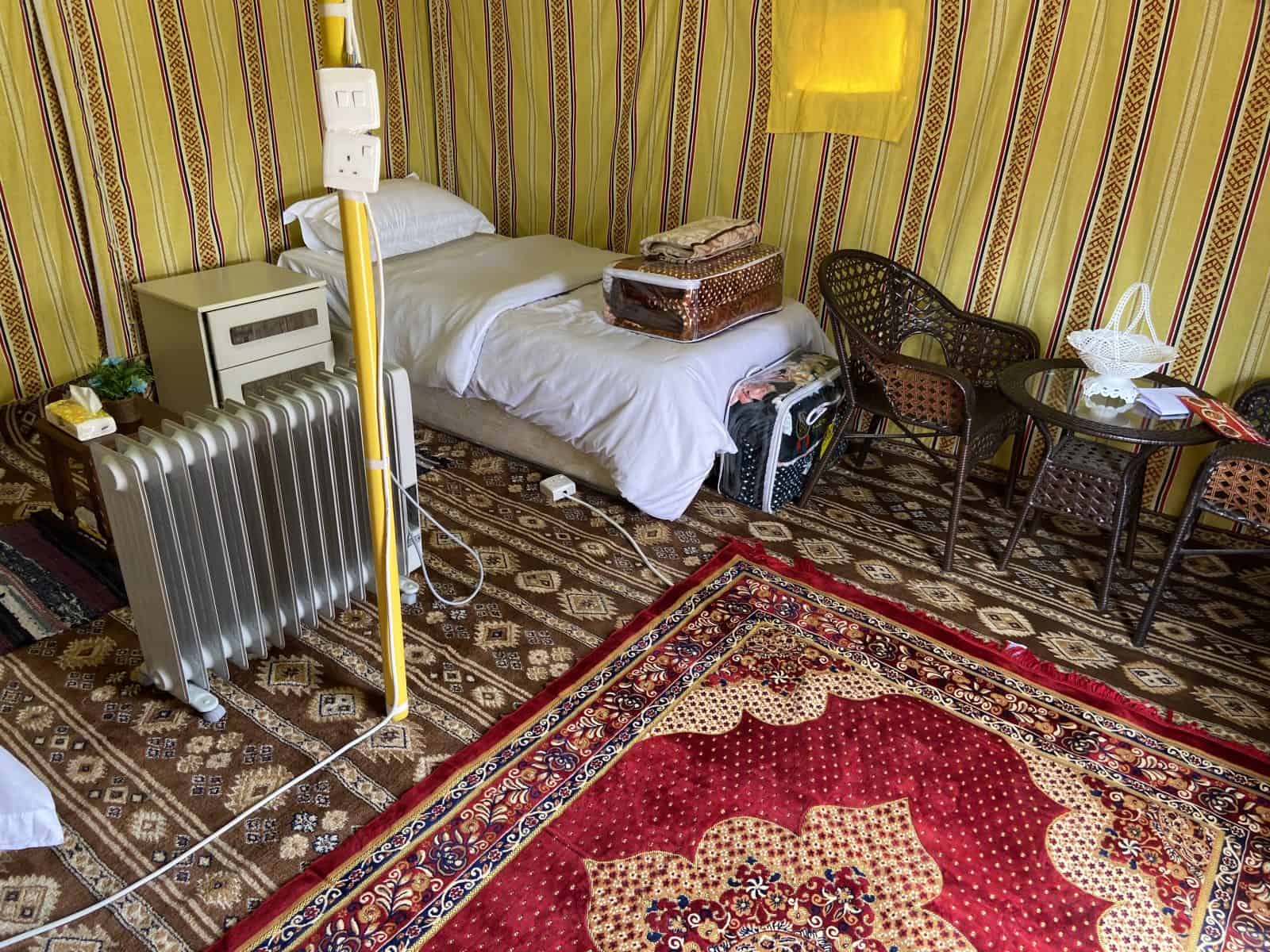
I ask about food.
“No eat here,” he says with a smile. “Only sleep.”
He hands me a plastic menu with pictures of various shish kabobs and Arabic lettering. He says they deliver. Fine. I eat a Clif Bar for lunch and sleep for what I think will be a thousand Arabian nights.
A night on the town
I wake up to some American English chatter outside. I go out to a sunny but chilly afternoon and see two young men talking to the guy in the headscarf. We exchange pleasantries and I recognize them as two others at the airport nearly nodding off waiting for rental cars that morning. Justin, 40, works in California’s tech industry and Minh, who moved with his family from Vietnam to California when he was 4, is a counselor at University of California-Davis. Both live in Sacramento and resigned their jobs to travel the world. They’ve gone from Europe across Russia down through Mongolia, into Southeast Asia then to the Middle East. Five years ago they traveled for 14 months. Since before they were born, I’ve traveled to 107 countries. They’ve already been to 99.
The host gives them the address of the restaurant that delivers and they ask if I’d join them. Being tech wizes, they had all kinds of charger adapters they loaned me and had the best GPS on the market. In the middle of Northern Saudi Arabia, that’s as needed as extra water. But the problem with GPS is not every establishment exists on the radar, especially in the middle of an Arabian desert. This restaurant, called Sultana, is barely listed in the neighborhood. We see a red dot without a name in the area and we take off down dark, dirt roads with occasional patches of pavement. We come to what should be the restaurant. It’s someone’s home.
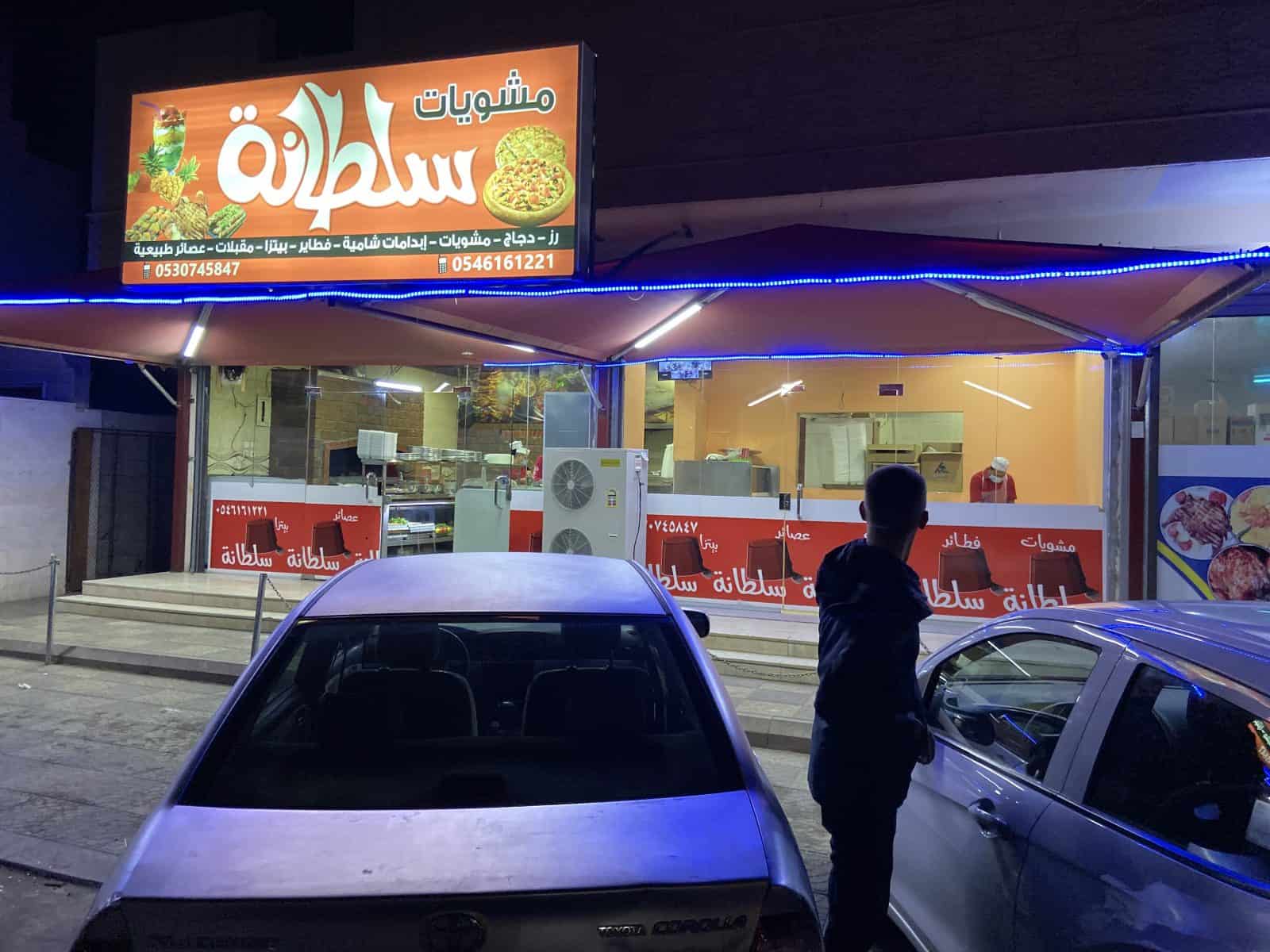
A tall, young, heavy-set man in a gray thobe comes out and introduces himself as Michel. Minh shows him the GPS. He agrees to take us. We pull up to this small, rough-and-tumble place with a wood oven where four guys in facemasks grill different meats and the short manager takes our orders behind the counter. This couldn’t be more local if we shared the table with goats.
We order the mixed grill: a huge plate the size of a symbol covered in rice then topped with sizable links of lamb, chicken and beef. It comes with sides of flatbread and hummus. I’m not that hungry but the meat is so tender I eat for 30 minutes.
Despite Michel not speaking a word of English, we have a lovely talk. Minh and Justin use Google Translator’s voice app to translate messages. Michel reads them, gives a delayed laugh, then says something in Arabic. We read and then laugh, always delayed.
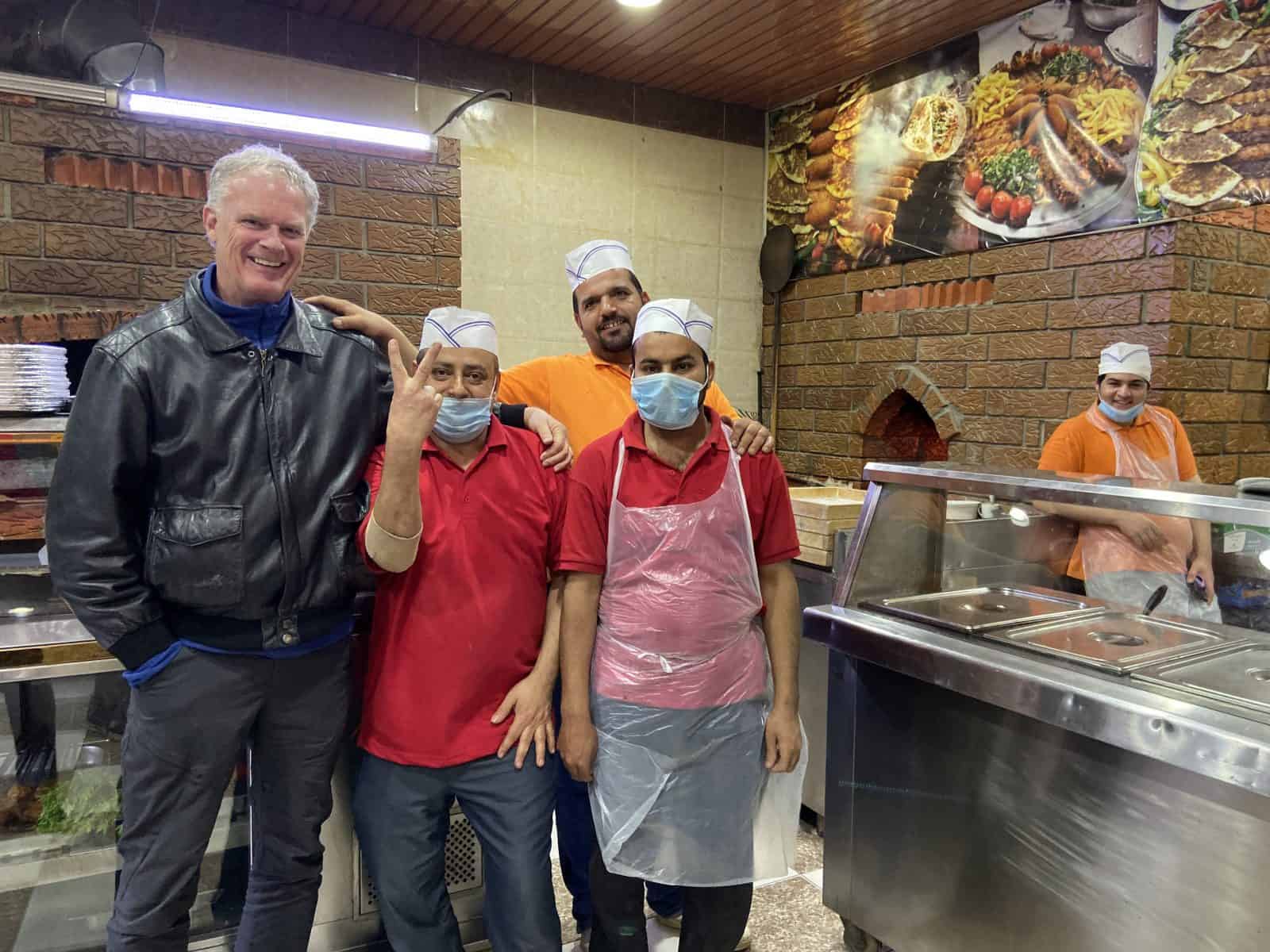
Michel is 24 and not working. He lives with his mother. He had spent that day at a commission looking for a job, somewhat shocking since developments in Al-Ula have left it with a negative-2 percent unemployment rate as recently as December. The pandemic has crashed the oil market and the Saudi government has cut back on social subsidies but before the virus hit I see no homeless and few beggars.
For years Saudis lived in luxurious isolation. Still, unlike most Americans, Saudis seem very interested in outsiders. Everywhere I go people ask me about life in the U.S. and my life in Rome. Michel asks us what we think of Saudi Arabia and our travels. He’s interested enough to invite us back to his place for tea. He leads us through the tiny roads and dusty trails and we stop at the same place where we got lost. It’s his house.
We follow him to an open-air lounge. It has a giant red, elaborately decorated carpet with cushions. We take off our shoes but I don’t take off my coat or stocking cap. The temperature is in the low 40s.
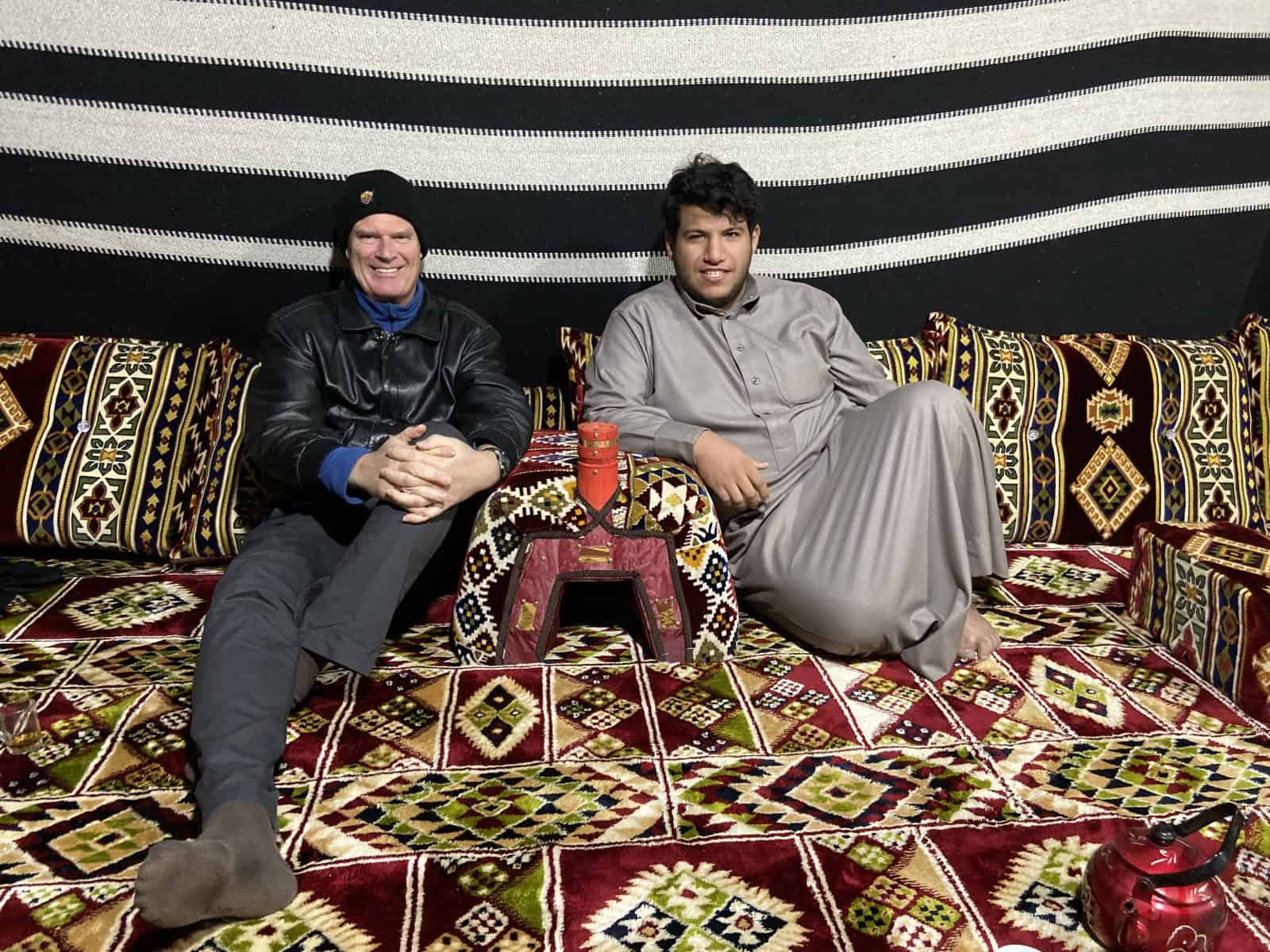
He gives us a cup of Arabic coffee, which tastes almost as bitter as the country’s non-alcoholic beer, and Arabic tea which is sweet, hot and smooth. He passes around a tray of dates of which I’m beginning to grow quite fond. It seems raisins taste much better when they’re on steroids.
We talk via Google Translate and joke about how his mom may get upset at him bringing home three strangers. Soon his uncle comes through the fence. He’s right out of central casting. His big pot belly stretches his gray thobe and his white keffiyeh and salt-and-pepper beard make him look like one of Ali Baba’s 40 thieves. Michel said he likes playing soccer and has lived in this village his whole life. His uncle has walked this desert for more than 60 years.
I secretly hope lifestyles like Michel’s and his uncle’s remain. Under Crown Prince Mohammed Bin Salman, as I wrote three weeks ago, Saudi Arabia is changing as fast as any country in the world. His quest to diversify the economy away from oil has resulted in looser visa restrictions, more freedom for women, new roads and hotels and refurbished attractions. It’s all part of his Vision 2030, his quest to get 100 million visitors by 2030. If this coronavirus ever dies (Saudi Arabia has had 136,000 cases and 1,000 deaths compared to 2.2 million and 119,000 in the U.S., respectively) and Saudi Arabia gets its oil industry back on track, maybe Michel won’t have to spend a day at a commission looking for a job that isn’t there.
Maybe he’ll find one at the place I came here to see.
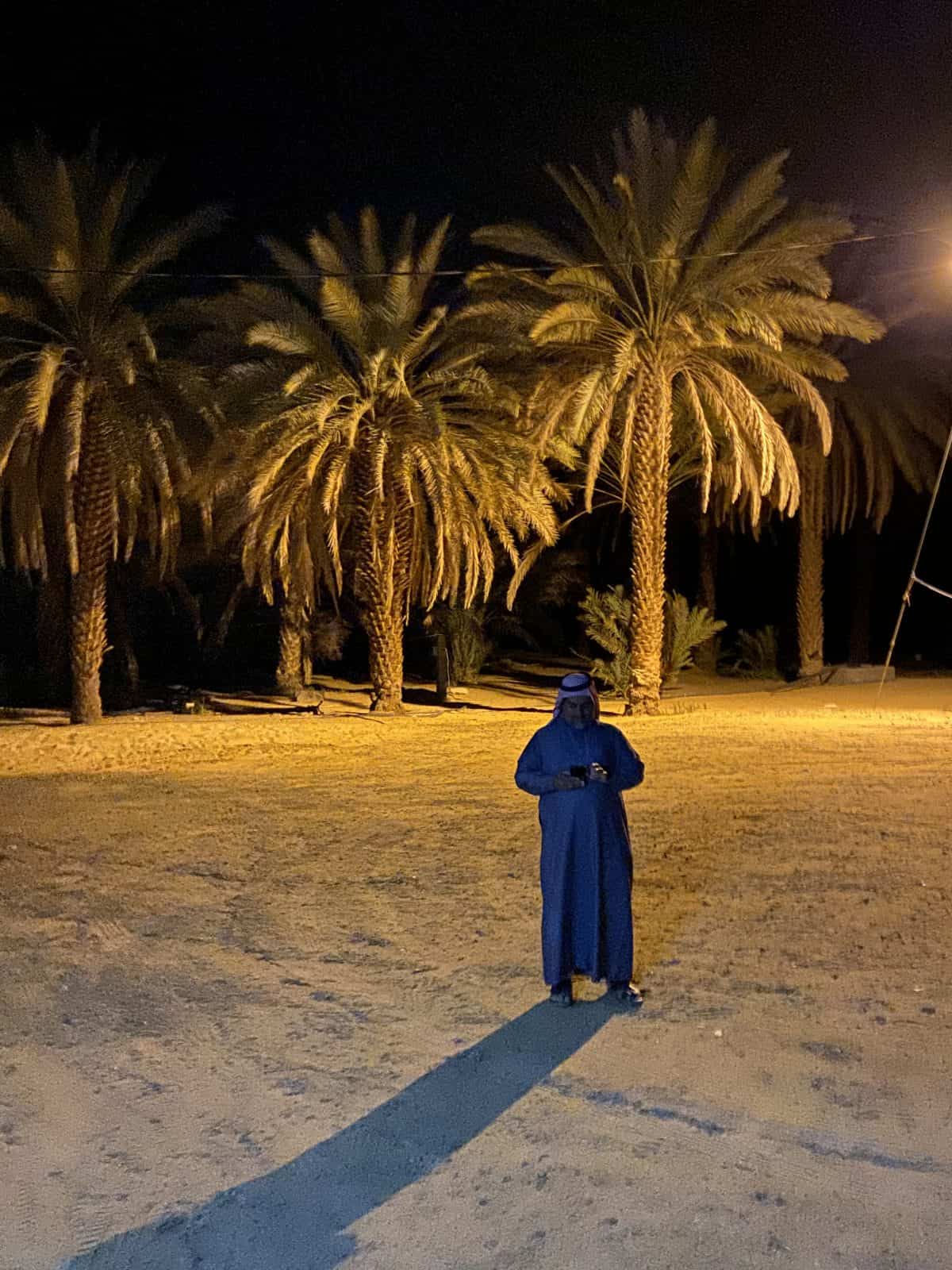

The Madain Saleh site
After 11 days I finally find a tourist center in Saudi Arabia. Madain Saleh is hardly a tourist trap. Tourist traps get more than 11 tourists on a tour bus to see the remarkable remnants of a 2,000-year-old civilization, freshly refurbished this year. About 1,300 years before Marco Polo, there were the Nabataeans. Until conquered by Trajan and the Romans in 106 A.D., the Nabataeans ran the trade route in the Middle East. They were wealthy, ingenious with water and built some of the most elaborate tombs in history. Writer and photographer Jane Taylor, who wrote, “Petra and the Lost Kingdom of the Nabataeans,” called them “one of the most gifted peoples of the ancient world.”
With Saudi still in its tourism infancy, Madain Saleh’s setup is a little strange. To buy my ticket I must drive to a place oddly called Winter Park. It’s a giant parking lot in a valley framed by massive, craggy, red mountains. It’s like in the bed of an enormous Grand Canyon. It’s a rock climber’s and photographer’s paradise and the weather is perfect: sunny, clear and in the 60s.
It’s in an open field littered with popup fast food places such as Dunkin Donuts, Burger King, Dairy Queen and Arabia’s most famous fast-food joint, Al Baik. I go to a steep A-frame ticket counter and a pretty black woman in a long kaftan sells me a ticket for 255 riyals, about 65 euros. I walk onto the nearby bus and see only two other people, a Hungarian couple camping on beaches around Arabia. Soon eight more join us: a well-traveled Finn and his Spanish friend motorbiking all over the world, a Jordanian, and five guys from the same Vueling flight crew. All of us are well-traveled. All of us are respectful. Finally I’m with my own kind.
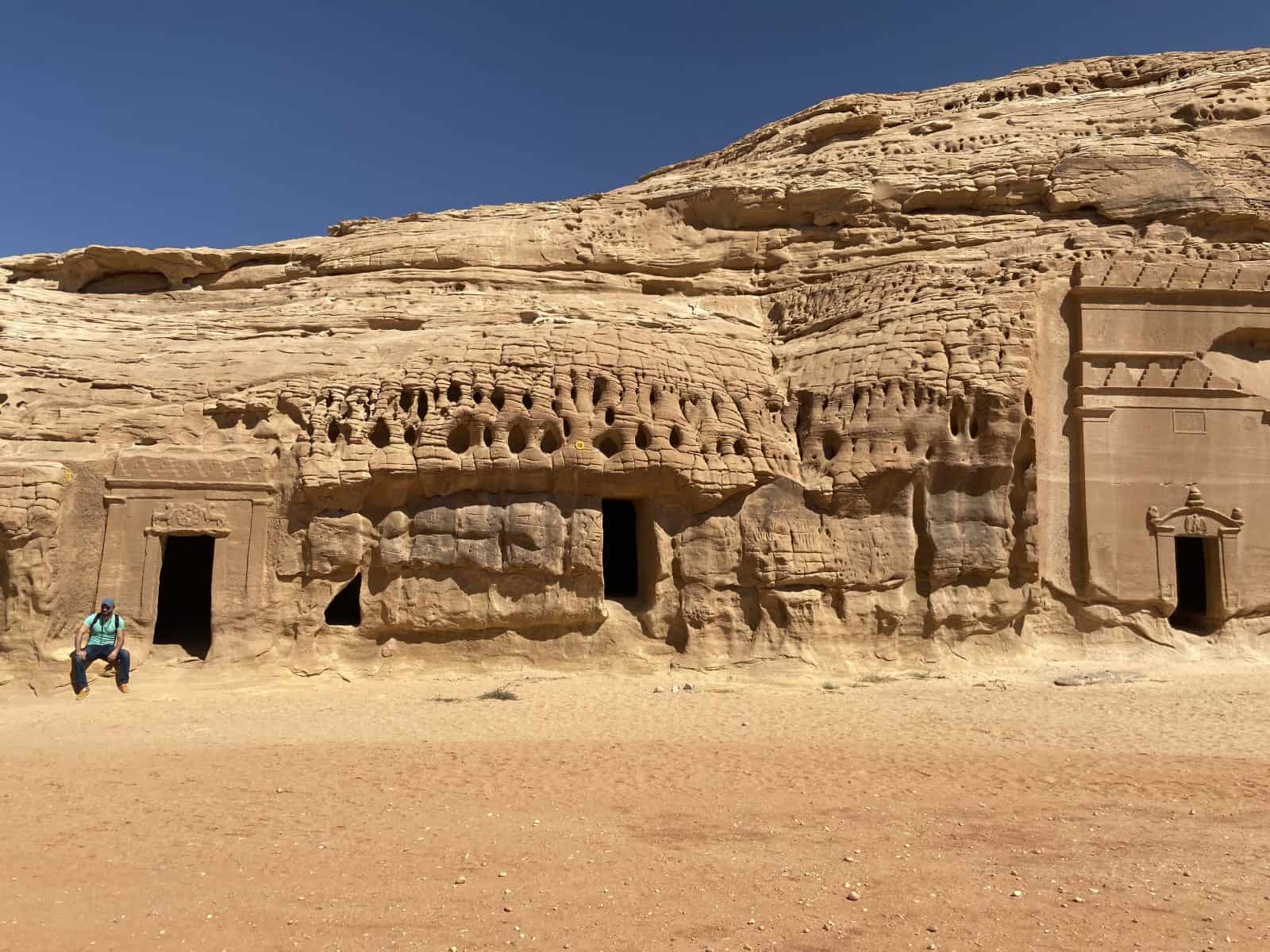
A 30-minute bus ride takes us to an old train station where the original locomotive holds fake boxcars, replicas of the ones that ran from Damascus to Medina in 1900. Before, it took pilgrims 40 days to travel the 1,300 kilometers on camels to reach Medina. The train took five. When World War I hit, Saudi Arabia supported Germany and the railroad was destroyed. Now it’s a photo op.
Our guide is Arden, a diminutive Al-Ula native who, illustrating Saudi Arabia’s start in tourism, has been a tour guide for only three months. But he is damn good, speaks excellent English and has an answer to every question.
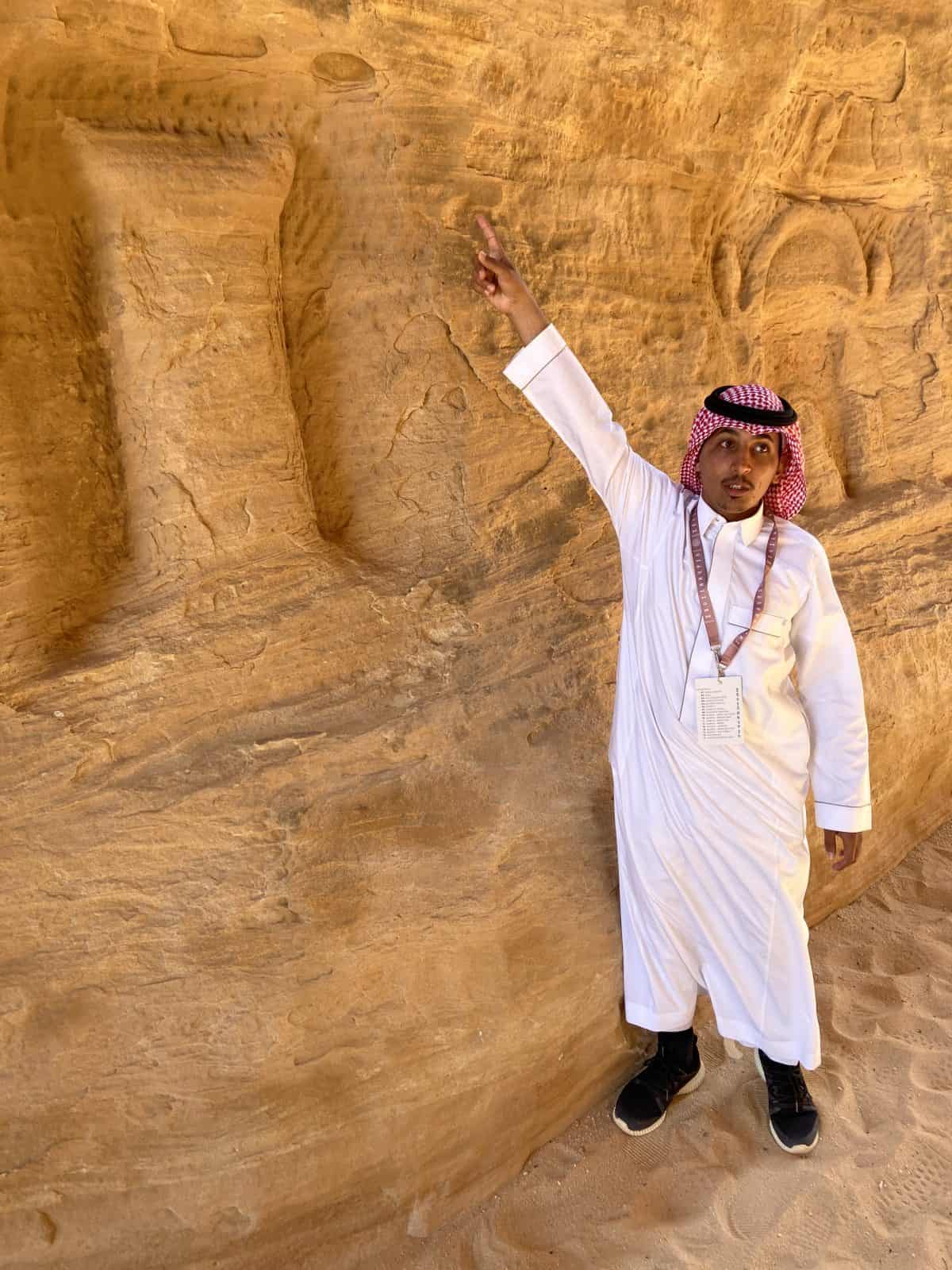
Another short bus ride takes us to a setting that in itself makes Madain Saleh worthy of the UNESCO Heritage Site. This is the mountainous desert. The Hijaz mountains of red and beige and brown and gold rise on both sides of us. Madain Saleh, called Hegra before the Muslims changed it, is a site covering eight square miles littered with towering tombs carved out of pure rock.
The Nabataeans built 131 tombs and each one seemed to try and outdo the last one. As trade merchants, they were incredibly wealthy — and smart. About 450 million years ago, an ocean covered this whole area. When the oceans receded, water was deposited under the sand. The Nabataeans carved wide grooves in the side of mountains to collect rainwater in numerous underground wells they built in the sand, hidden from intruders. The wells were made of water-proof stucco and nearly 100 feet long.
They did three things to build their civilization into one of the grandest during the time of Christ:
- Planted oranges and dates and watered their orchards for food with an elaborate water-gathering system.
- Governed the important trade route that took frankincense, myrrh and incense, used in perfumes and various ceremonies, from what is now Yemen and Oman, up north into Africa.
- Built 131 elaborate tombs, the artistry of which is remarkable to this day.

About 10,000 people lived in Madain Saleh, compared to 25,000 in Petra, and Arden explains that society was very open. Other religions were encouraged and welcomed. Women had equal status.
One Spaniard quips, “What happened?”
Arden even laughs.
The preservation is remarkable. The carvings can be seen without a powerful camera lens. The walls look sturdy enough to last until the end of time. One big reason is superstition. The Thamudis, an ancient Arabic people, settled this area in the 8th century B.C. According to Islamic texts, Allah punished them for idol worshipping and battered the area with an earthquake and lightning strikes. Forever more, Saudis have considered the area cursed. The place was never ransacked.
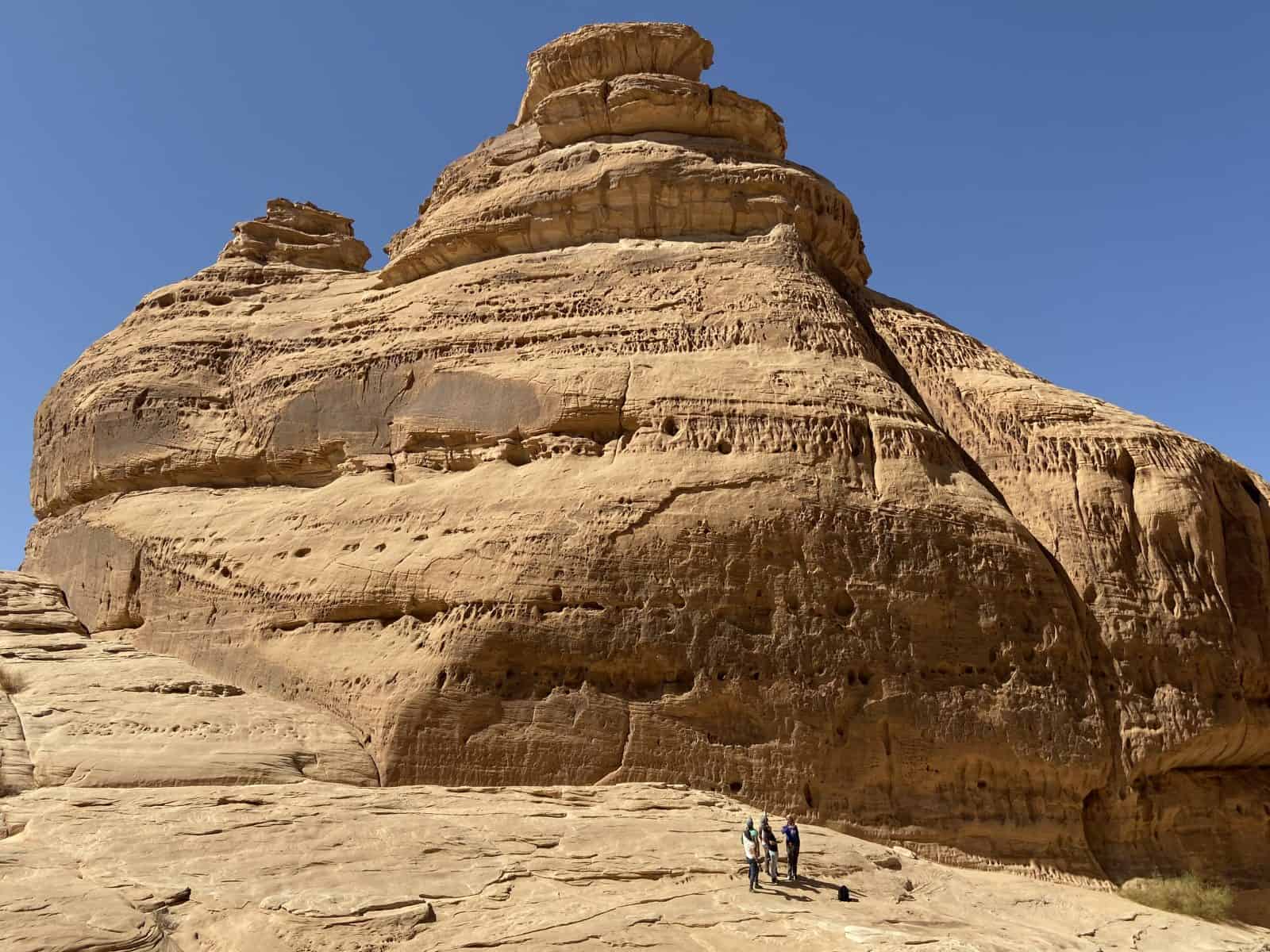
However, the area nearby was eventually lightly resettled. People lived here until 1975 when the government, sensing they could turn this into a tourist attraction, gave them money to relocate. The cleared space allowed for more excavations and some tombs were discovered as recently as nine years ago although mass tourism has yet to take hold.
The construction of the tombs was ingenious. They started at the top of a giant rock. Using a big chisel, they hammered out the tomb shape. They used a smaller chisel to cut out the main designs. They used a little chisel for details, using Greek and Roman designs. What resulted was each tomb had the eagle god Bushalah atop a triangle. Inside the triangle was a snake to protect the tomb. Below it was a string of lotus flowers. The more elaborate the design the wealthier the deceased.
Some of Madain Saleh’s tombs are 50 feet high. Inside were deep, long, rectangular openings with shelves to hold the corpses. At a site called Al Khuraymat, 20 tombs are carved into sheer rock. I see images of lions and wings and spirit guardians with women’s heads. My guidebook says evidence of plasterwork indicates people dined outside family tombs, sort of a Nabataean Day of the Dead. The last tombs featured seven carved side by side about 20 feet apart. We all climb a small sand dune to shoot it from above and just climbing the steep incline of 30 feet made me wonder how these Bedouin nomads live like this every day.

From lookout point
The next day is my last in Saudi Arabia. I take some Spaniards’ advice and drive up to a lookout point. It’s 20 minutes up a windy road along the side of a craggy brown mountain. I pass nary a soul. As it finally levels off, I park in an area with four 50-foot radio towers. A short walk to the mountain’s edge takes me to one of six umbrellas over benches with spectacular views of the valley below. I can see Al-Ula’s small cluster of buildings, the only town I see as the mountains and desert stretch to the horizon.
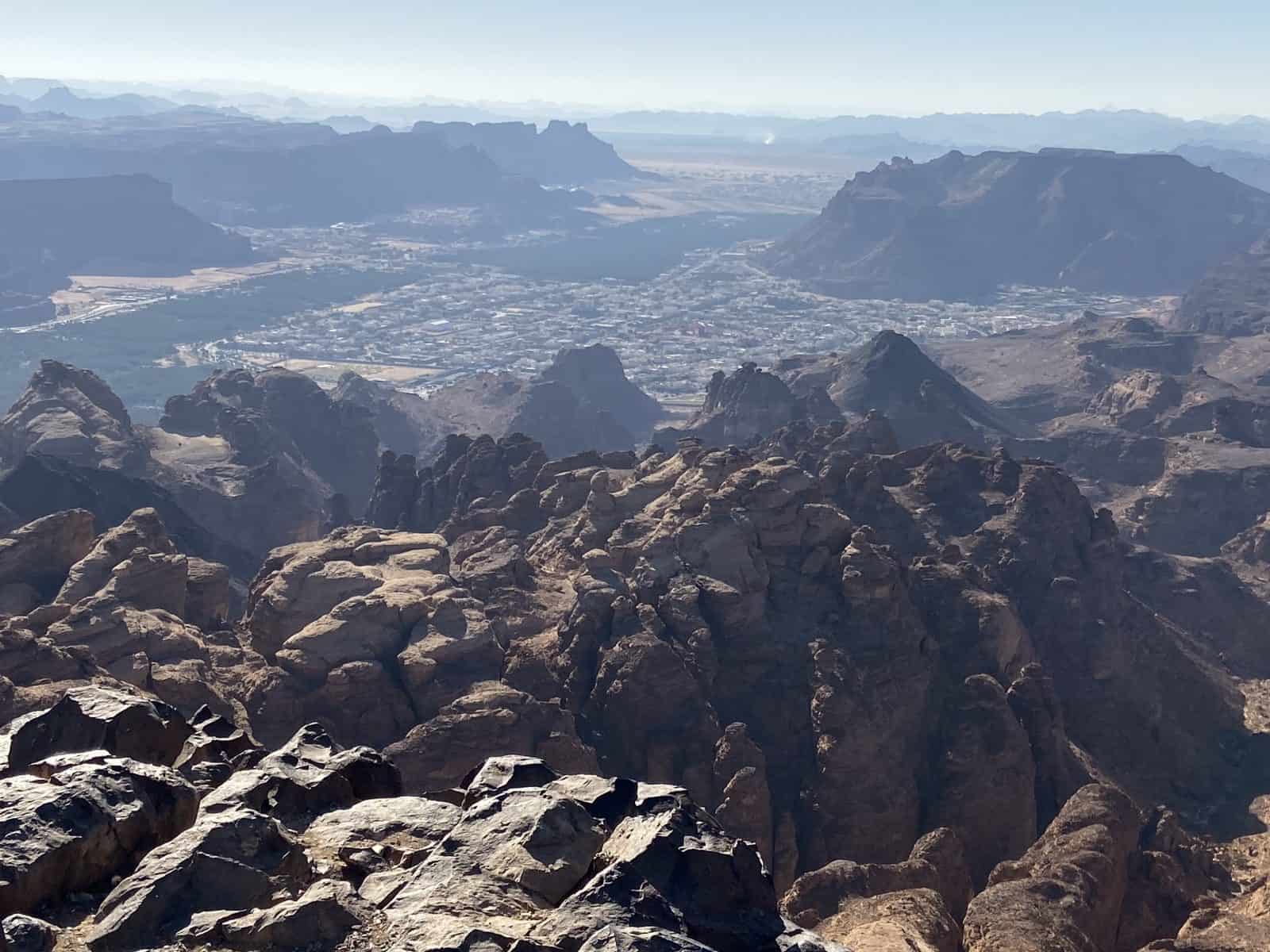
Standing there huddled against a cold wind, I think about Saudi Arabia’s potential. I’m blessed to be here before the mobs arrive. The country has much work to do. It must build 500,000 more hotel rooms. It must make public transportation available to a site such as Madain Saleh. Human rights violations must be kept in the past and not in today’s headlines.
The current pandemic stopped the country’s progress for a few months. But after nearly two weeks I sense this is a special place. I feel nearly alone in discovering a country with such beauty, cleanliness and culture. The people are so open, I can see how they want to change their country’s image. How far the crown prince is willing to see Saudi Arabia progress in the eyes of the world will be key in attracting visitors. I expect much push back from scoffing friends who read these blogs.
Then again, most of my friends can’t go two days without alcohol, let alone two weeks.
If I met with tourism officials, here is what I would tell them, a list of positives and negatives from a country just beginning to blossom on the world travel radar.
Saudi Arabia positives
- People. Most hospitable I’ve ever met. I got invited into two homes, people helped when they could even if they didn’t speak English and no one denigrated my country or lack of religion.
- Food. Who knew? Saudi Arabia has some of the best restaurants I’ve experienced. Not only was the taste of fresh, lean meats and massive portions of rice great, but the quality was consistent and prices low. I could get tired of the cuisine but for 11 days it’s perfect.
- Smells. These are the sweetest-smelling people I’ve ever met. The women wear heavy perfume and the men pour on the cologne. It’s part of their culture. They have a spice called Ohm which is real expensive. Two ounces are about 30 euros.
- Beaches. Jeddah’s Corniche is beautiful but the White Sands Beach is right out of the Caribbean. And no crowds.
- Roads. All newly paved and there is little traffic outside Riyadh at rush hour. It’s an easy, unintimidating place to rent a car.
Saudi Arabia negatives
- Cab drivers. They don’t have a clue. They’re almost all immigrants who have no idea where anything is, even the national museum and trademark Masmak Fortress in Riyadh. They made me an Uber subscriber.
- No nightlife. I’ve gone 11 days without a drink. I don’t miss it at all. What I do miss are the gathering places that are drinking establishments. I found it hard to meet people here. I got lucky with my networking.
- Internet. It’s spotty at best. Many places don’t have it. It made Maps.me a necessity and it’s not reliable.
- Lack of free speech. When I talked to locals, I had a filter. I can now tell when people lie about their freedom to criticize.
- Coffee. It’s terrible. It’s like watered-down tea. I don’t know what I miss more, a glass of Italian wine or my espresso machine.
Madain Saleh: If you want to go …
Getting there: Choices are limited. In October, for example, there are three direct 1-hour, 45-minute flights from Riyadh to Al-Ula a week, starting at about $210. There are three direct 1-hour, 10-minute flights from Jeddah a week, starting at $226. Bus takes 8 ½ hours and is $65-$85.
How to get around: A rental car is a must. Al Wefaq Rent A Car www.alwefaq.co/en, 966-920-00-2909, open until 11 p.m. For two-plus days I paid 327 riyals (about $87).
Visas: Visas required for 49 countries, including the United States, and can be acquired online at visa.mofa.gov.sa/visaservices/searchvisa. I paid $124.
Time to go: Unlike the rest of Saudi Arabia, Madain Saleh is pleasant all year round. Average highs range from 56 in January to 85 in July.
Where to stay: Rural tents Naseem Alouzaib, Altheeb Area. Has double-occupancy tents for about $110 40 miles from the airport and seven miles from Madain Saleh. Small swimming pool available weather permitting.
Where to eat: Sultana. About a 10-minute drive from Rural tents, it’s the only place that delivers but go for sit-down service. Setting is authentic. Food is massive, delicious and cheap. Ask at hotel for directions.
For more information: Alshitaiwi Travel & Tourism, www.alshitaiwitours.com , 966-11-812-6-789.
Excellent! History lives in your writing…and geography too. Thanks to share your experience!
Thank you for this very detailed blog post! My family and I would like to visit this place soon and your post is very helpful. Do you think we can rent a sedan or must we drive a 4-wheeler?
Cedan is ok
Thank you for sharing. I did this tour/trip with my teenage son via Bus while living in Riyadh….in 1996. The freedoms and liberal travel and visitor visas to Saudi were not in existence then. I often talk about Nabataeans and Madain Saleh to this day. We lived 3 years in Saudi and this one of the most dangerous yet most gratifying bus and educational trips ever. The Highways were not all paved and because of the car bombing in November of 1995 in Riyadh. There was random check points every 30-40 kilometers. 14 expatriates were ordered off bus and searched and interrogated while the bus was also searched. Each stop and search was about an hour. What was suppose to be a 12 hour bus trip each way turned into a 24+ hour bus trip because of threats. We slept in Hunter orange tents for 3 nights with armed Saudi Guards. We loved the tombs and feel so blessed and grateful to see such history. It warms my heart that the Saudis have now opened up tourism to allow others to experience this journey.
There are now hundreds and thousands of branded and unbranded coffee outlets in Riyadh alone. You can have very good coffee of the any brand you are used to.
I was in Jordan and have seen almost everything worth seeing, time permitting. Your description of Saudi Arabia sound attractive. I hope to see The Saudi Nabataeans sites before the mass invasion.
I doubt you have to worry about a mass evasion. Saudi Arabia has such a PR disaster on its hands, I don’t see it becoming touristed out anytime soon.
Leave a Reply Cancel reply
Your email address will not be published. Required fields are marked *

- Arabia, the Gulf, and the GCC Blog
From the National Council on U.S.-Arab Relations
Madain saleh: an archeological marvel in the saudi arabian desert.

Paige Peterson is the Executive Vice President of the Huntsman Cancer Foundation in Salt Lake City, Utah, and a board member of the National Council on U.S.-Arab Relations in Washington, D.C. This photo essay illustrates her visit to Madain Saleh, one of Saudi Arabia’s “hidden treasures.”
When he was the Kingdom of Saudi Arabia’s Ambassador to the United States, Foreign Minister Adel Al-Jubeir gave me an extended visa. He had two good reasons for doing that. One was professional. I am the Executive Vice President of the Huntsman Cancer Foundation, where one of my missions has been to build alliances with Saudi Arabia’s excellent cancer researchers. The other was personal. As a writer and photographer, I was endlessly curious about Saudi Arabia’s people — and its landscape.
It’s a cliché to say that a picture can be worth a thousand words. These pictures were worth more than that for me — they are the story of a rare and extraordinary adventure. It’s a privilege to share it here.

The Kingdom of Saudi Arabia is located on the continent of Asia. It shares land borders with 8 countries: Kuwait, Iraq, Yemen, Qatar, Oman, the United Arab Emirates, and Jordan. Saudi Arabia’s geography is dominated by the Rub’ al Khali desert, the second largest desert in the world with only the Sahara being larger. The Kingdom’s population is over 28,000,000.
Saudi Arabia is the 13th largest nation in terms of land area. The United States is about 5 times bigger than the Kingdom. Saudi Arabia is four times the size of France, western Europe’s largest country.
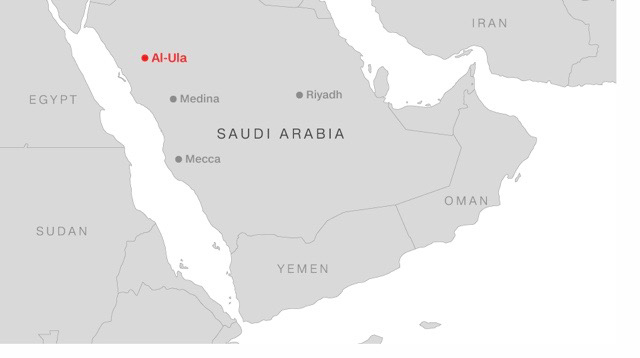
Two bodies of water border Saudi Arabia, the Arabian Sea to the East and the Red Sea to the West.
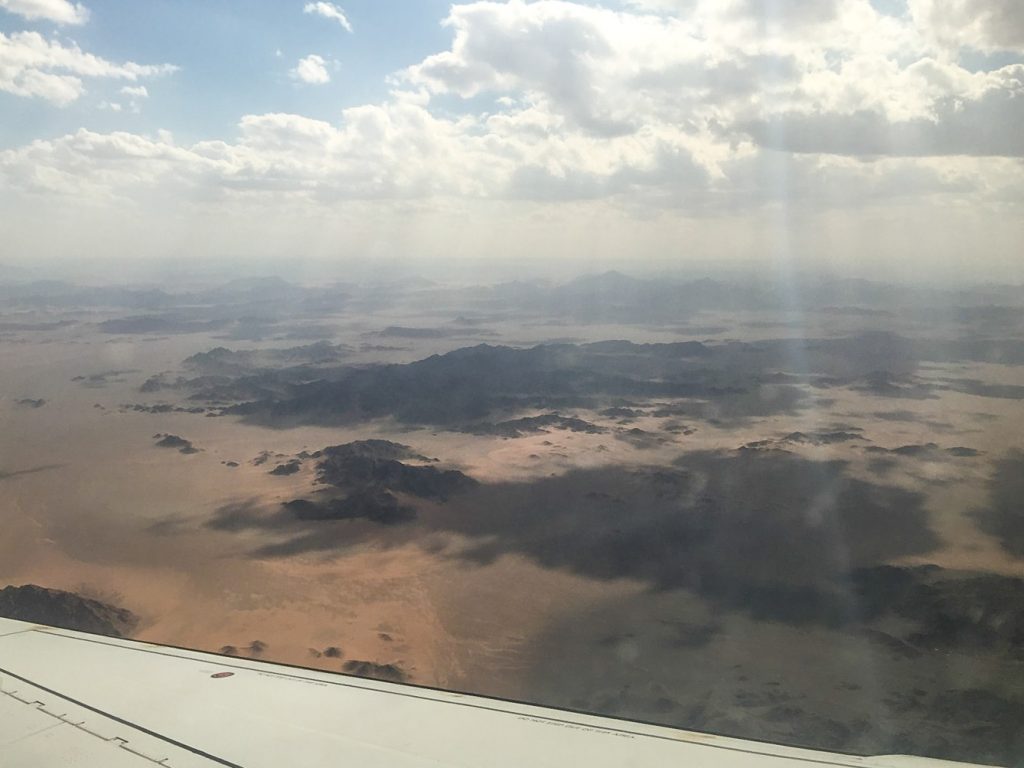
The flight to Al-Ula was one hour and fifteen minutes from Jeddah.
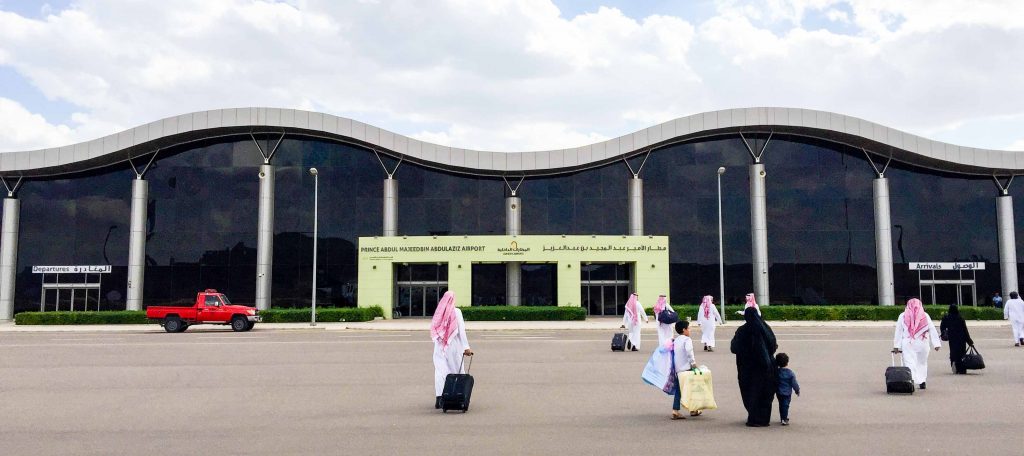
Prince Abdul Majeed bin Abdulaziz Airport.
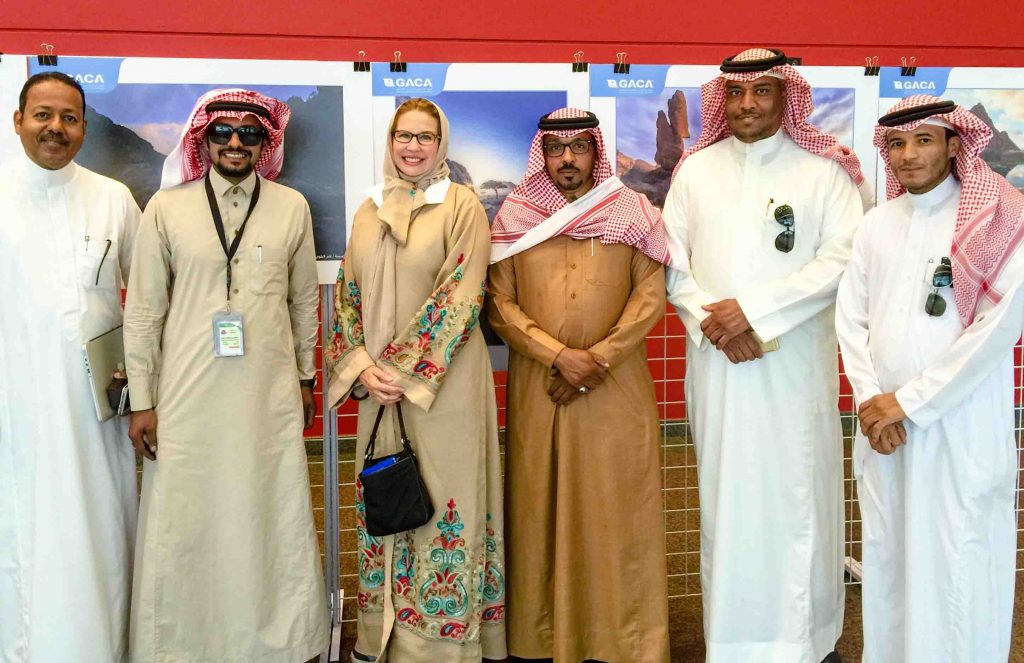
Upon arrival, we were greeted by local nature photographers who had an exhibition of their work at the airport. Notice the distinctive ways men can wear their ghutra (headscarf).
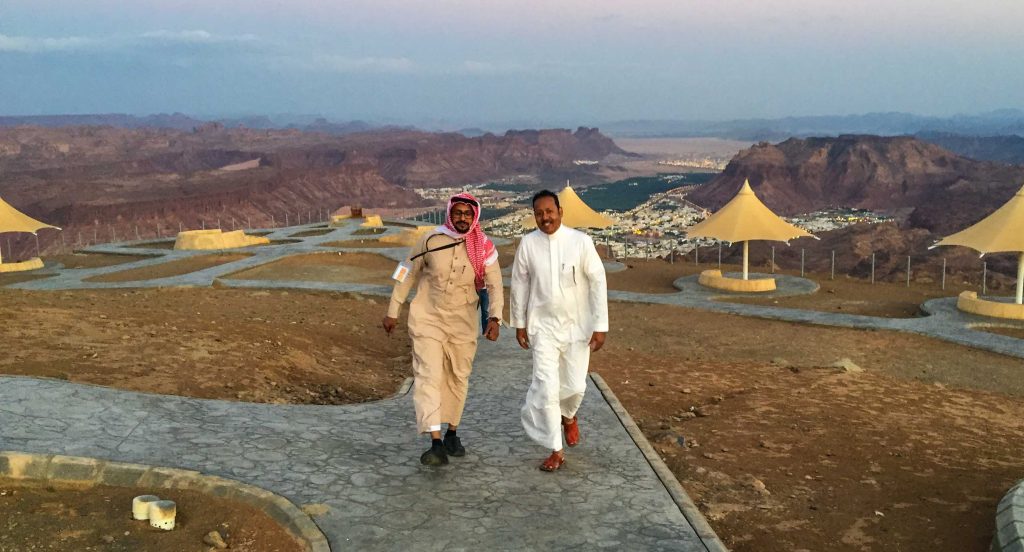
My tour guides, Abdulalkarim Al-Thubiany of Al-Ula and Samir Komosani, who traveled with me from Jeddah. Samir is the general manager of Platin Travel and the Kingdom’s first licensed tour guide.
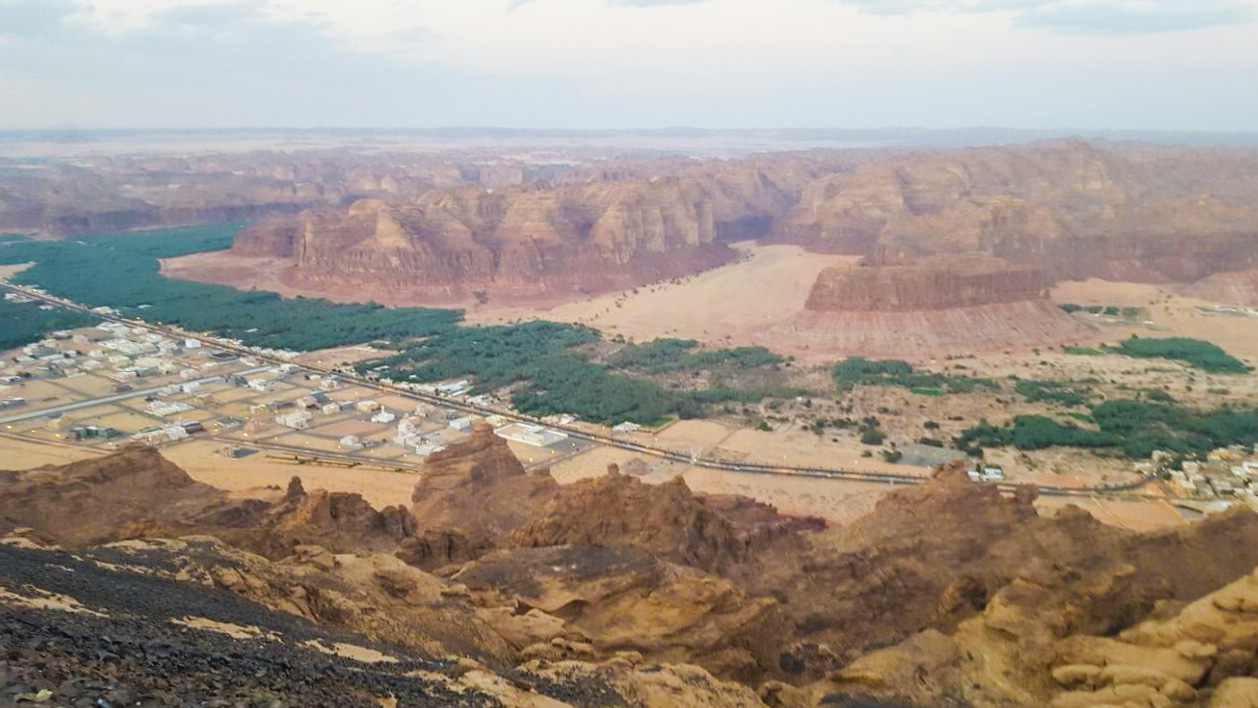
Looking down onto the city of Al-Ula from a vista point. The Kingdom brings to mind images of undulating sand dunes and herds of camels. But traveling to the north-west corner of Saudi Arabia, we arrived in a lush date-palm oasis, surrounded by tall cliffs. Al-Ula county covers nearly 9,000 square miles. It is about the same size as New Jersey.
A long cut in the cliffs, reminiscent of the Grand Canyon in Arizona, provided a passageway for ancient caravan traders. Its palm forest provided them food, shelter, and a place to rest their camels. Today, some of the 150,000 date palms are said to be more than 100 years old.
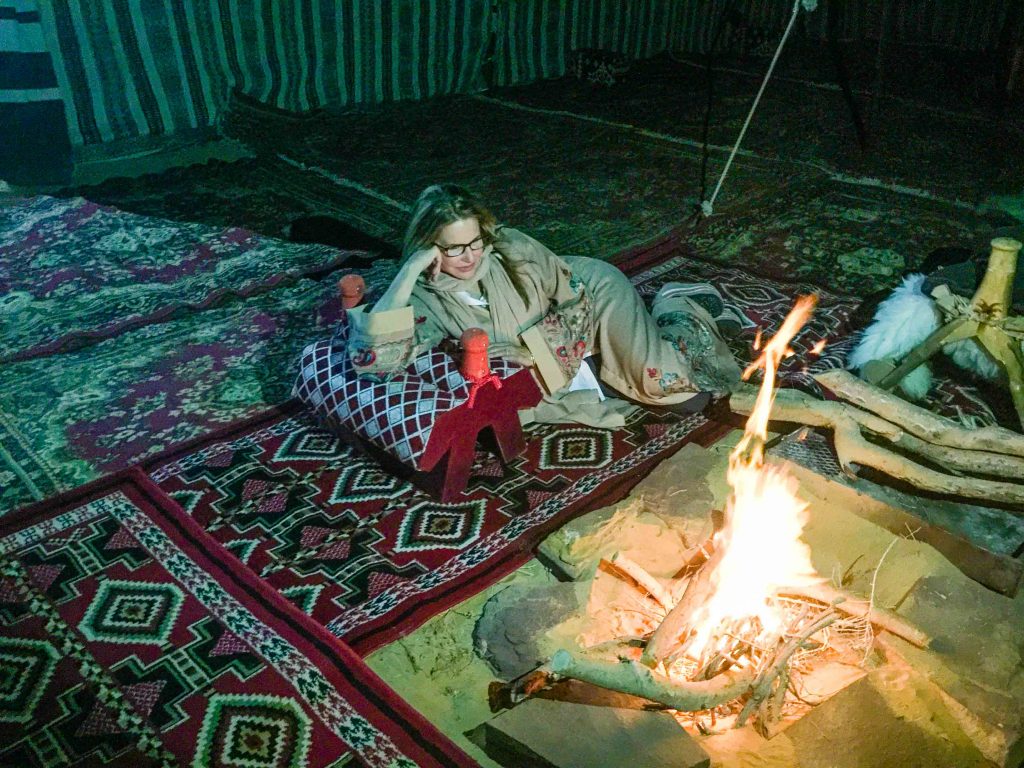
The layered rugs were varied and visually delightful. The camel saddle made for a comfortable evening.

On the left, an iconic Arabic coffee pot. Common European words derived from Arabic include coffee, cotton, sofa, mattress, admiral, canal, cannon, jacket, sugar, soda, candy, lime, lemon, rice, spinach, sheriff, traffic, and zero.
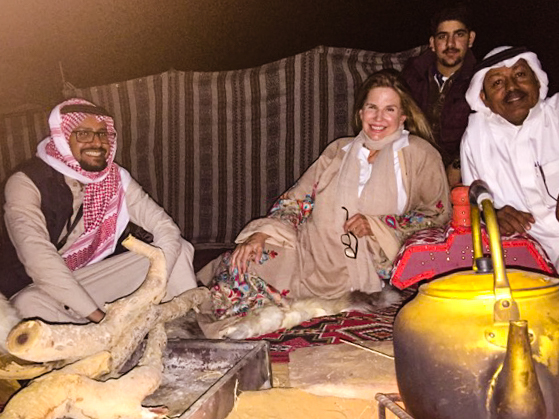
Our crew in the desert.

Abdulkarim brought his cherished falcon. UNESCO declared falconry a living cultural heritage.
Falcons can see the movement of their prey from a distance of more than a mile. The resolution of the falcon’s retina is eight times higher than that of man. The purpose of a hood is to calm the bird. These birds are so visually oriented that they are not fearful of what they cannot see. Hoods protect the bird and allow ease of control of situations that otherwise could be startling to the bird.
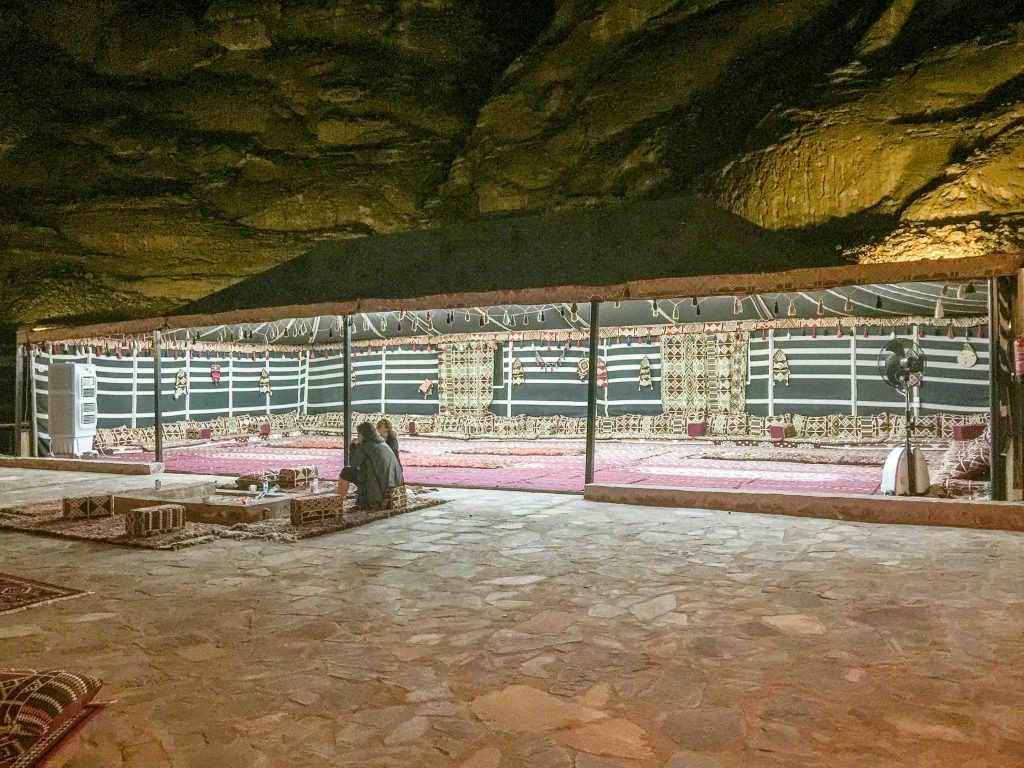
We drove to Sahary Al Ola Camp where we would stay for a couple of nights.
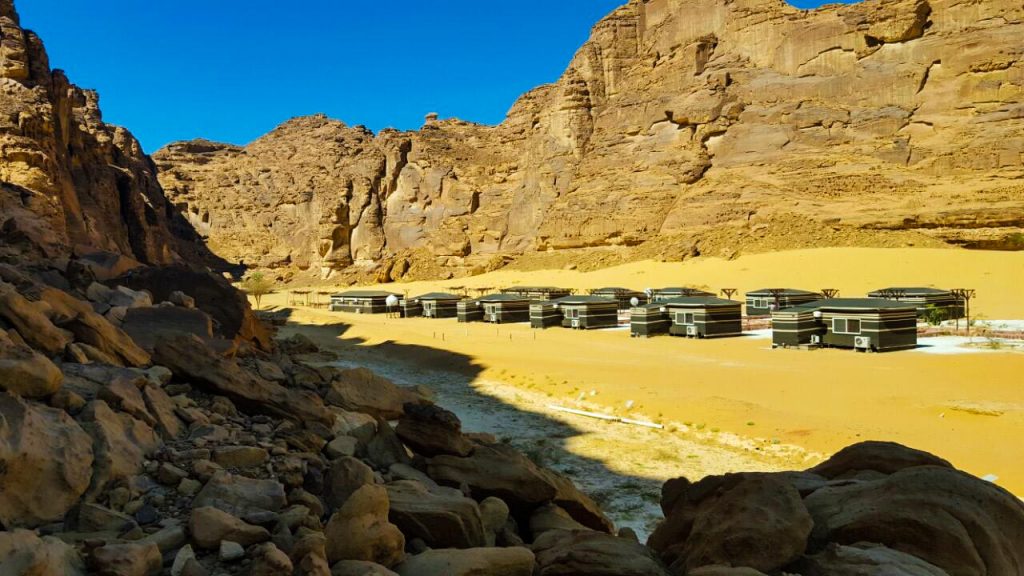
Bedouins have traditionally lived in large black tents called byoot shaar (houses of hair) because they were woven from black goat’s hair. They were ingeniously designed to be adjusted to catch or block desert winds, depending on what was needed at the moment. Our dwellings here were not traditional tents but rather modern portable houses covered with a fabric made to look like the handwoven strips used in the old black tents.
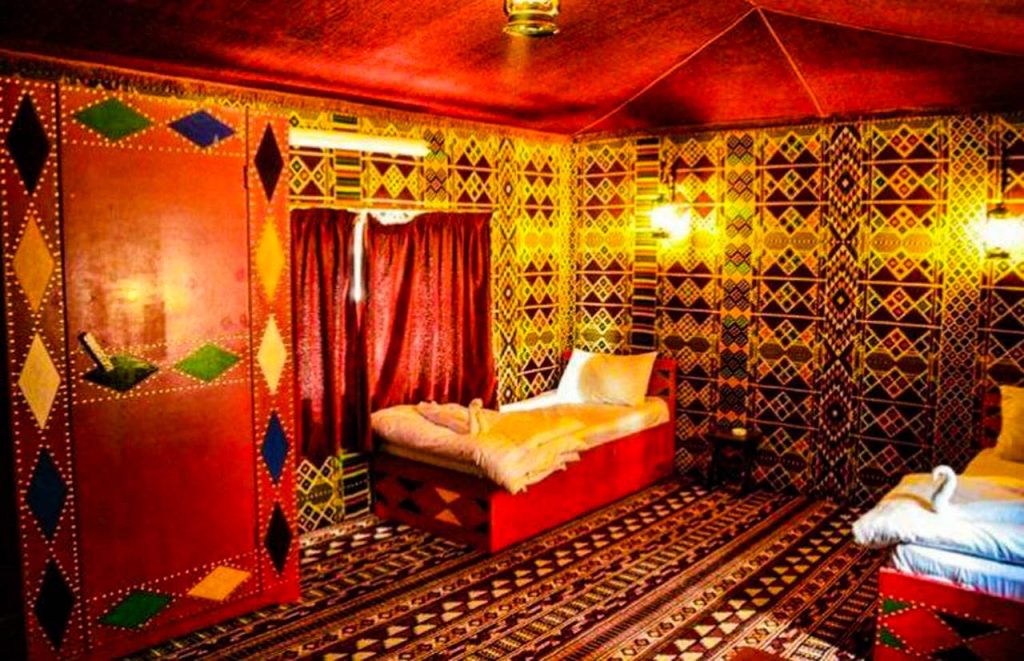
My room. The juxtaposition of the desert landscape and the vibrant interior of my lodging was stunning.
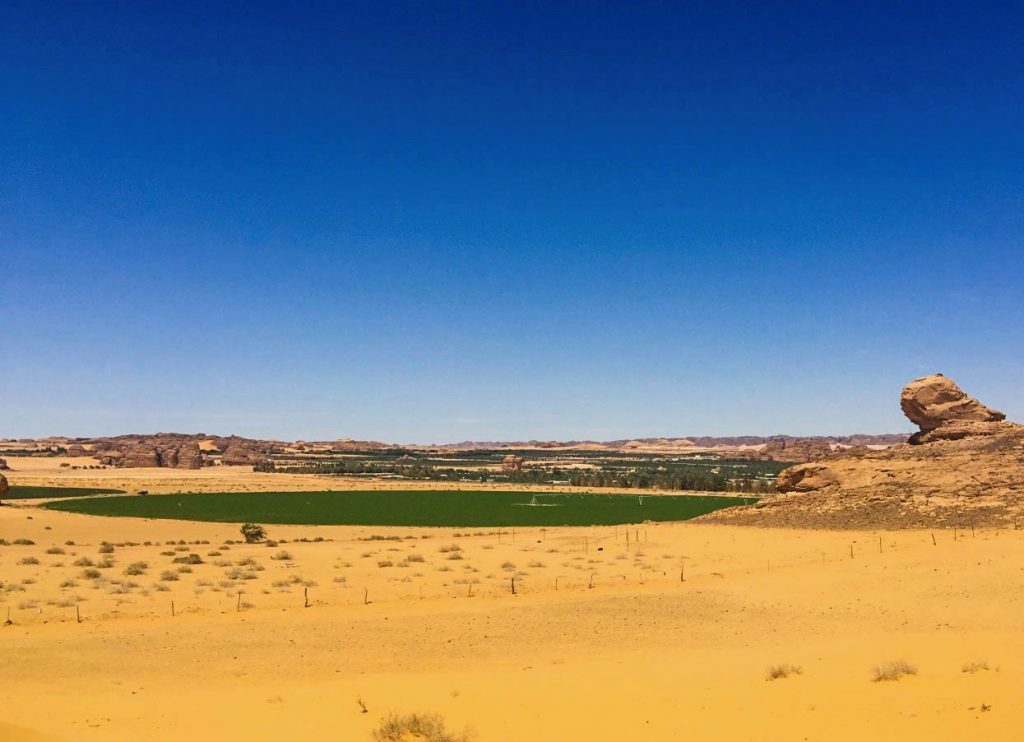
As we exited our desert camp, we passed through miles of irrigated agriculture. There is not a river nor a stream in the Kingdom. The only consistent sources of inland water are oases. Oases are fertile areas of otherwise unfertile land. There are natural springs from which these fields are being irrigated.
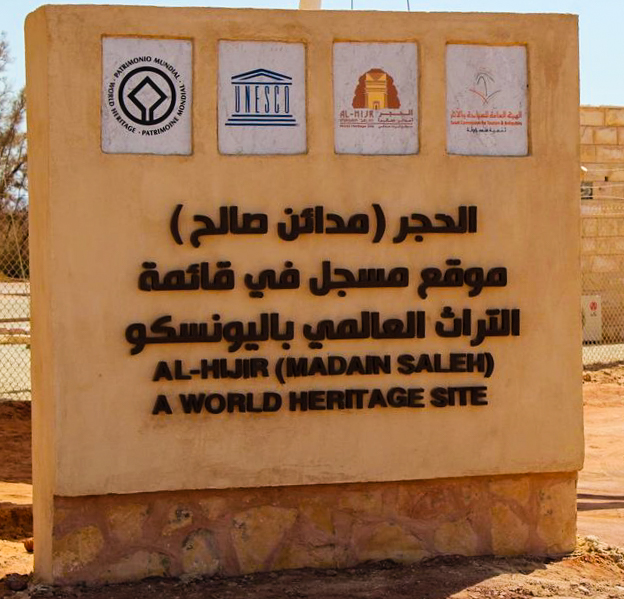
In 2008, the Al-Hijr Archaeological Site (Madain Saleh) became the first Saudi Arabian property to be inscribed on the UNESCO World Heritage List. Little noticed for centuries, serious efforts to explore the site’s archaeological significance only began in the past couple decades. As Saudi Arabia changes and attempts to transform its economy, Madain Saleh has been increasingly noted for its historical significance as well as its tourism potential.
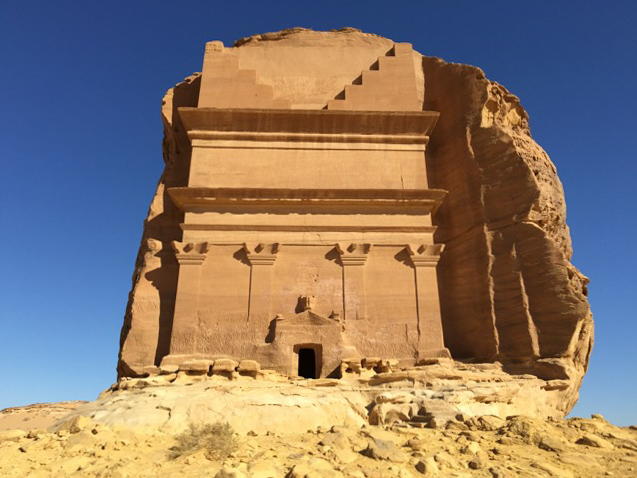
Madain Saleh was built by the Nabataeans, the same civilization that created the much better-known settlement of Petra in Jordan. It is the largest open museum in the world.
In an arid landscape of large rock formations and cliffs, hundreds of tombs are carved into the rock faces, creating beautiful architectural vistas as far as the eye can see. The tombs are over 2,000 years old. The most iconic symbol of Madain Saleh is Qasr al-Farid, a single tomb carved into a small dome that stands alone in the open.
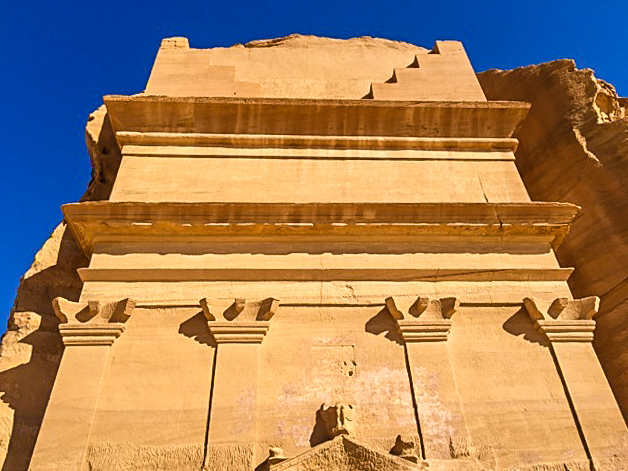
Madain Saleh is Saudi Arabia’s pre-eminent pre-Islamic archaeological site dating to the Nabataean kingdom in the first century. It was the southernmost settlement of the Nabataean people, whose capital was in Petra, Jordan. Muslims did not come here because they believed the site was cursed when the Nabataean’s refused to renounce their gods in favor of Islam. It’s the very absence of foot traffic, as well as Saudi Arabia’s dry desert climate, that has kept Madain Saleh so well intact. While Petra’s facades are slowly disintegrating, these tombs are stunningly well preserved.
Qasr Al-Farid is unique because it was not completed and not used as a tomb as there are no traces of burial sites inside it. Qasr al-Farid is four stories high with four columns. Most only have two. As such monuments were meant to be an indication of the wealth and the social status of the people who commissioned them, bigger definitely meant better.
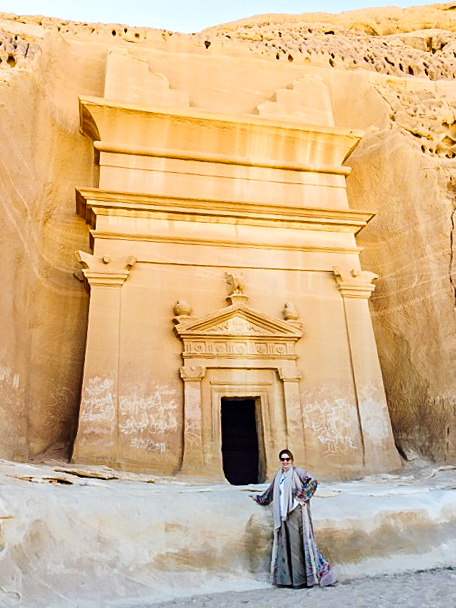
There are 131 Nabataean tombs cut into massive rocks spread over more than 8 miles.
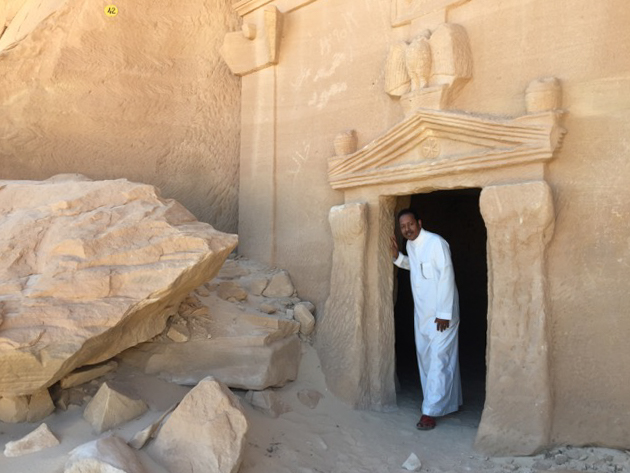
Samir walking around the lavish tombs.
Nabataeans controlled trade routes to Rome. They were Arab nomads. They were a tough lot. Their primary defense was melting into the desert, and waiting for their enemies to die of thirst and starvation.
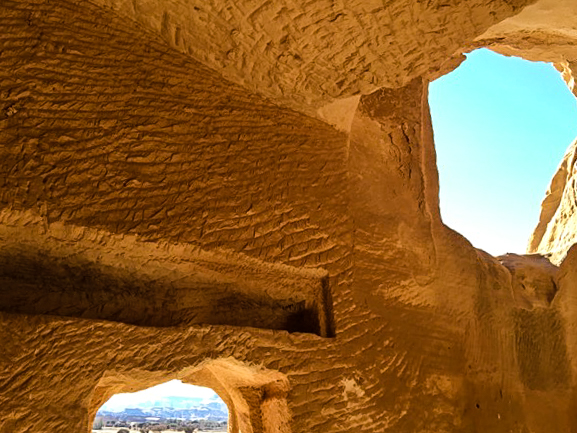
Imagine traders and camels approaching Madain Saleh, bringing baskets full of frankincense from Yemen and Oman. These resinous nuggets, extracted from the Boswellia sacra tree, are as valuable as they are rare. They would have been destined for the wealthiest Romans, Greeks, Egyptians, and Israelites.

Joyful young men climbed to the top of the rock.
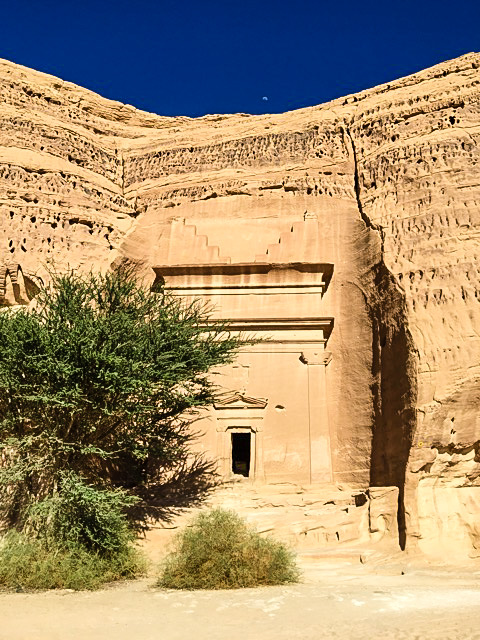
Token trees and bushes break through the sand to find life that create a most welcome bit of shade.
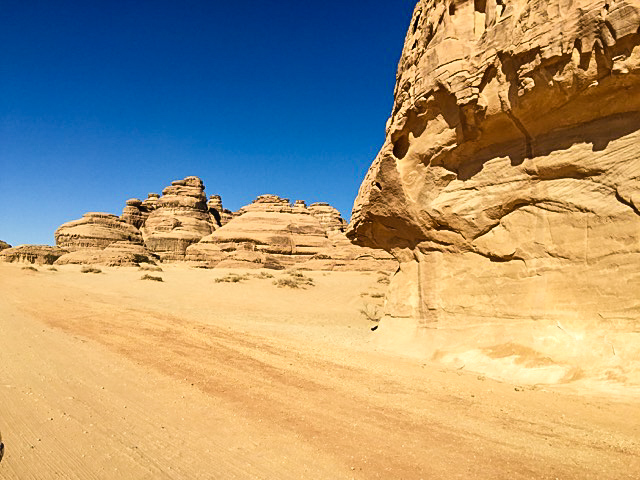
Nothing green here.
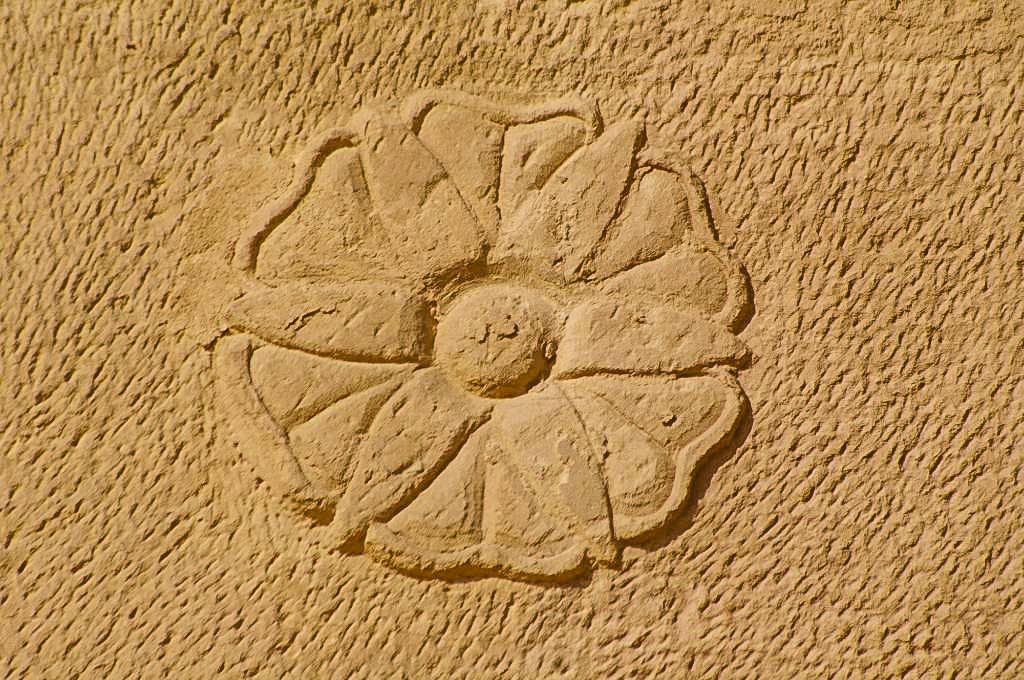
Hand carved beautiful detail.
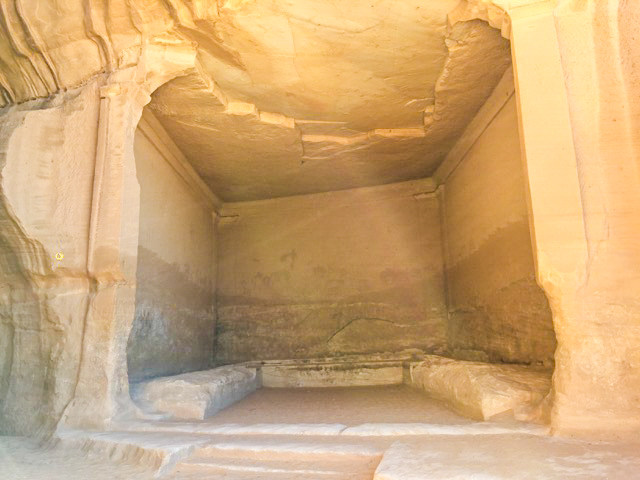
This square chamber containing three stone benches served as a triclinium for sacred feasts. Today, the chamber is known as al-Diwan.
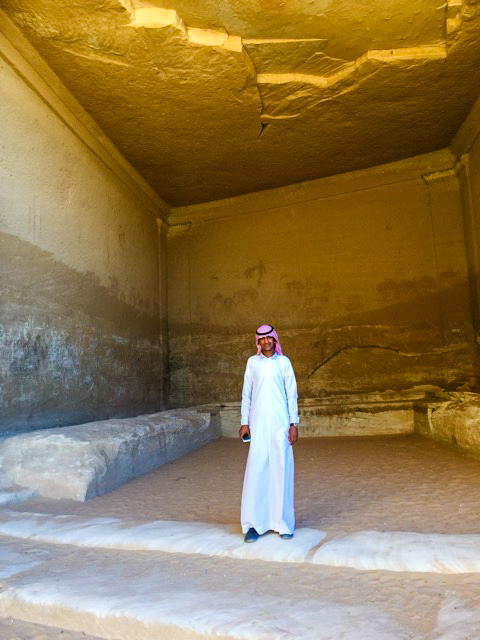
This young unarmed policeman standing in al-Diwan is wearing the traditional white robe called a thobe . The headscarf is called a ghutra , which is kept on his head with a black piece of cord called an igal .
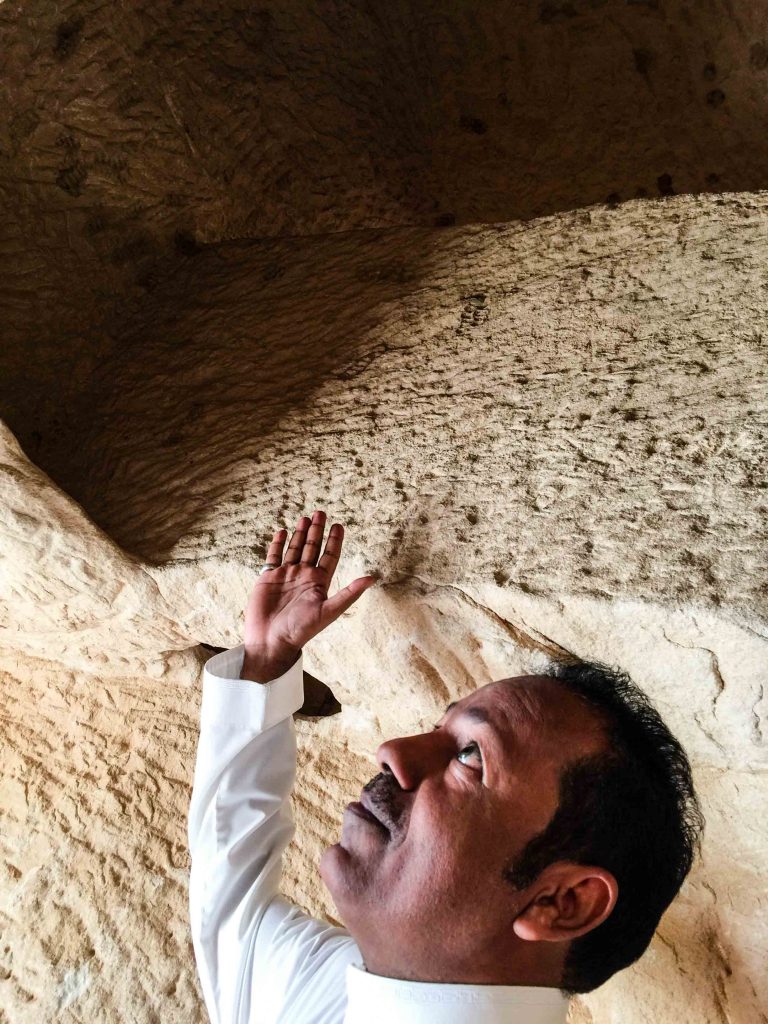
Samir gazing at the workmanship of a tomb.
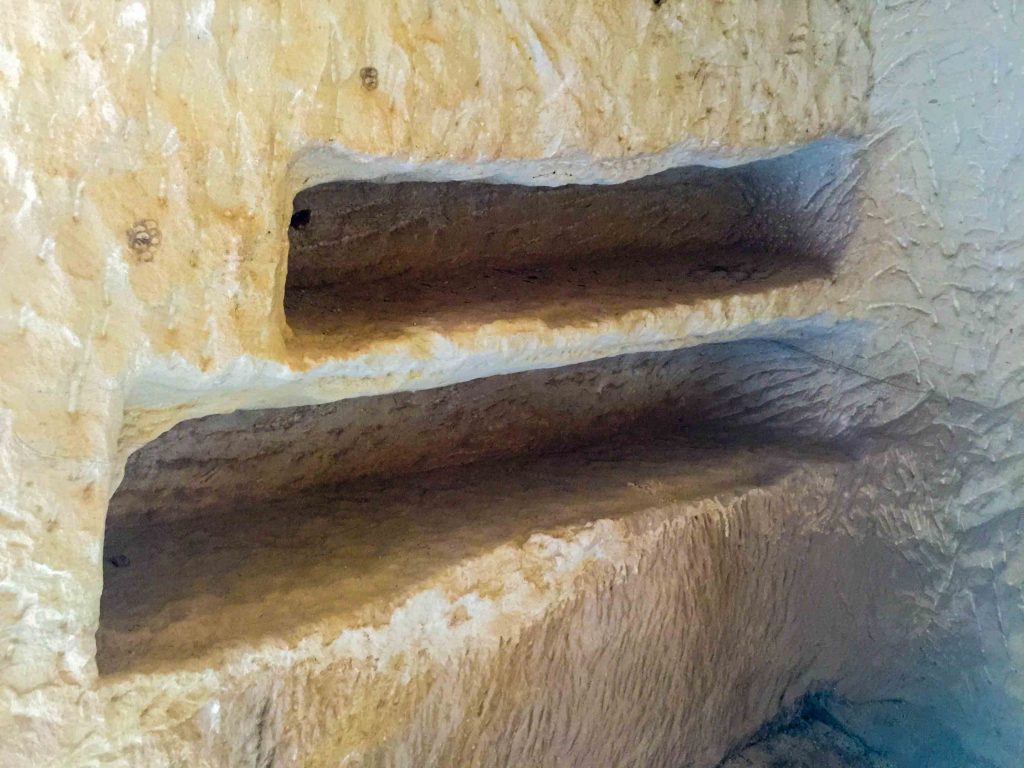
Where bodies were laid. Individuals were buried without clothes or shoes, with only a collar of fresh dates around their neck. Their bodies were wrapped in three layers of fabric impregnated with resin, the closest to the body being tinted in red.
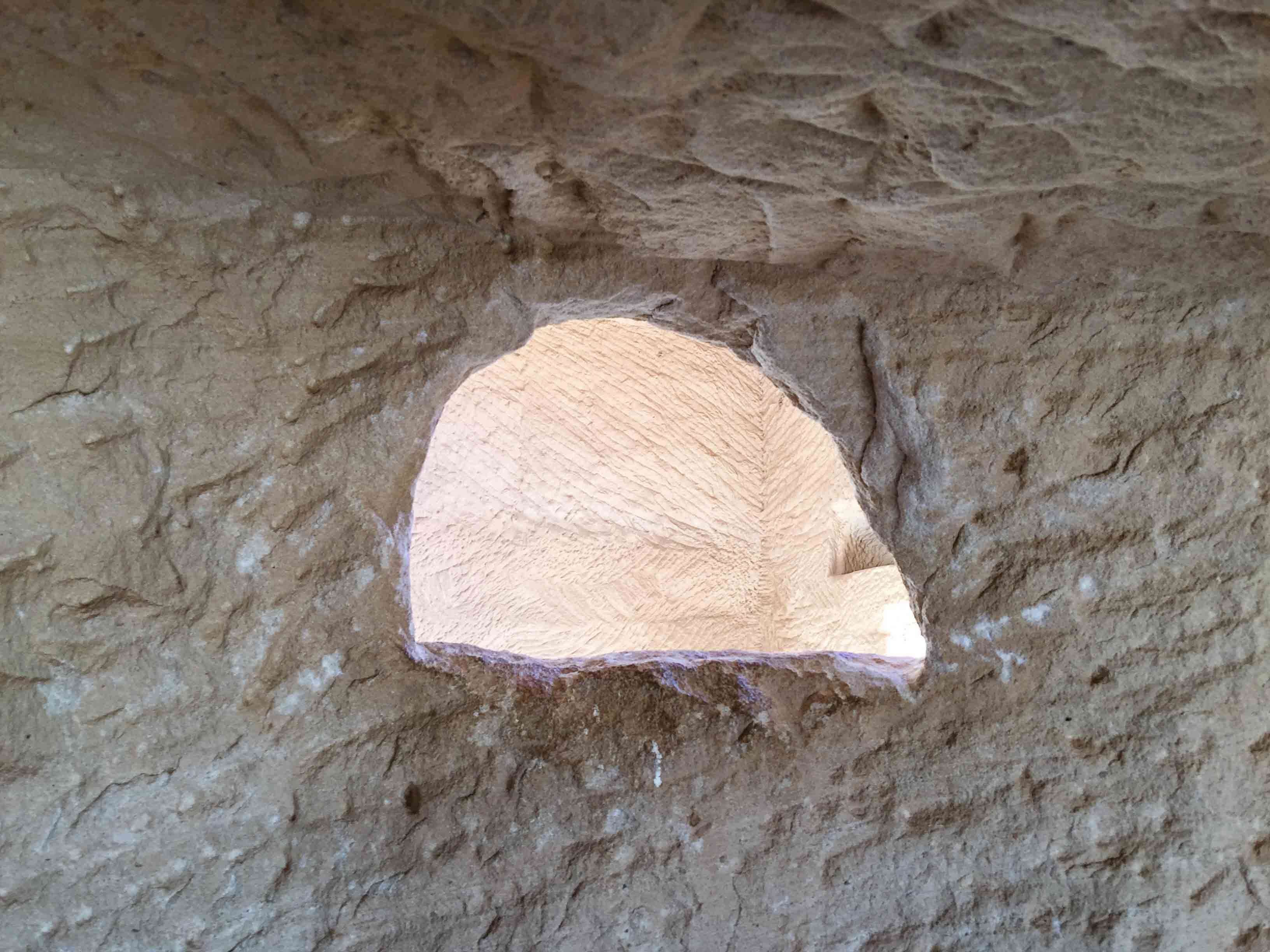
Families in the shade of a lone tree.
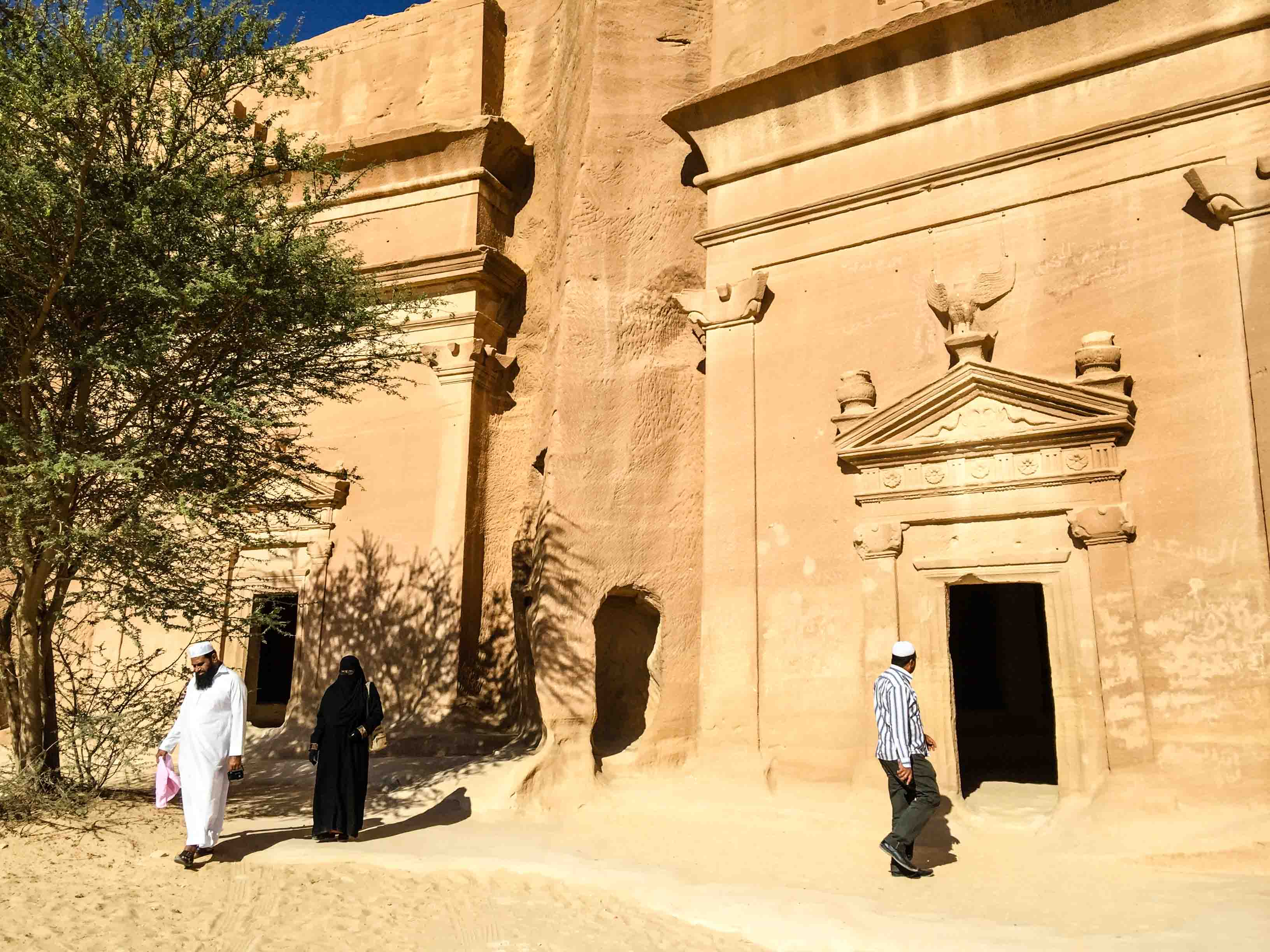
Madain Saleh entered a period of decline after it fell to the Romans in 104 CE. Overland trade routes melted away to newer, maritime routes through the Red Sea. The defeated Nabataeans moved away completely, leaving their enigmatic carvings, chambers, and tunnels as the only signs they were ever there.
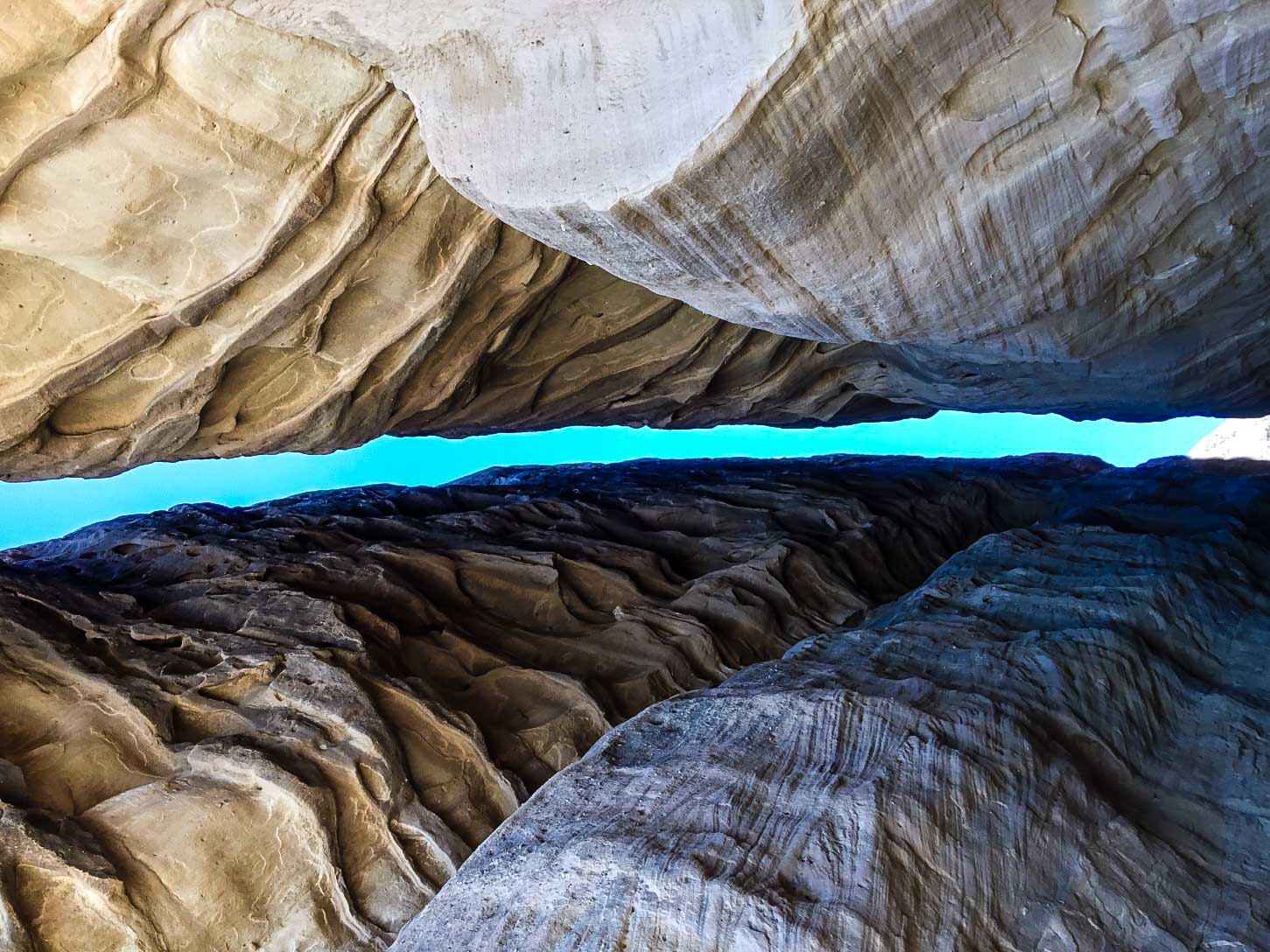
In the middle of the Jebel Ithlib is a natural slit that measures 131 feet called the Siq, a dim narrow gorge, after a similar corridor in Petra.
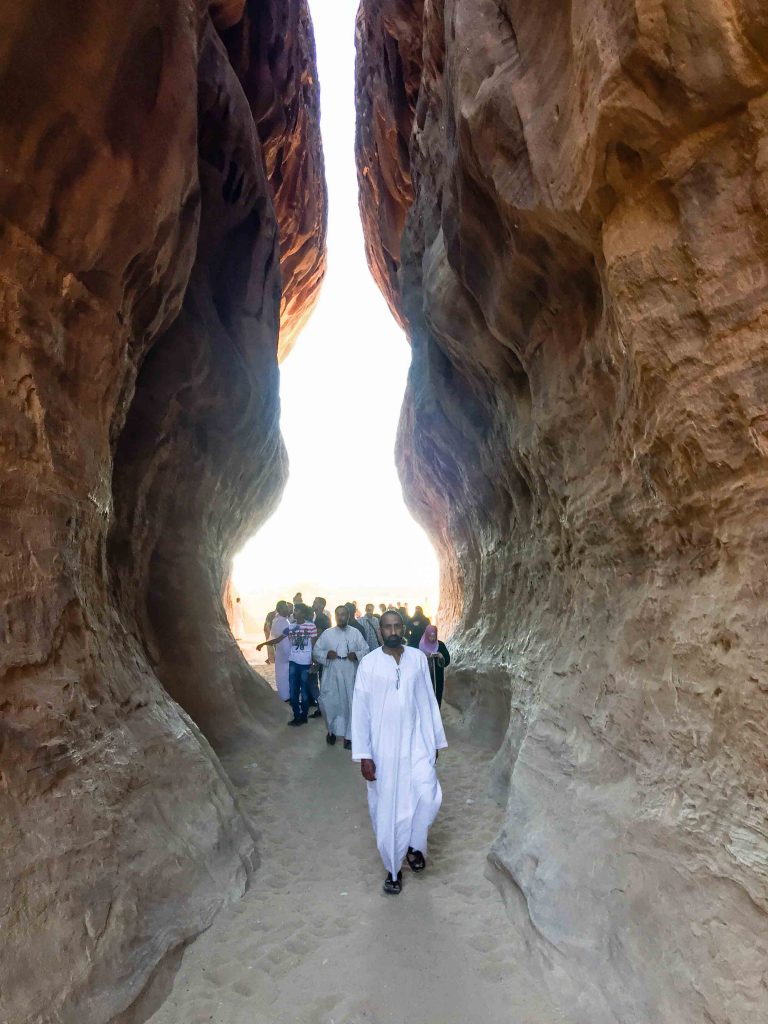
Walking through the Siq.
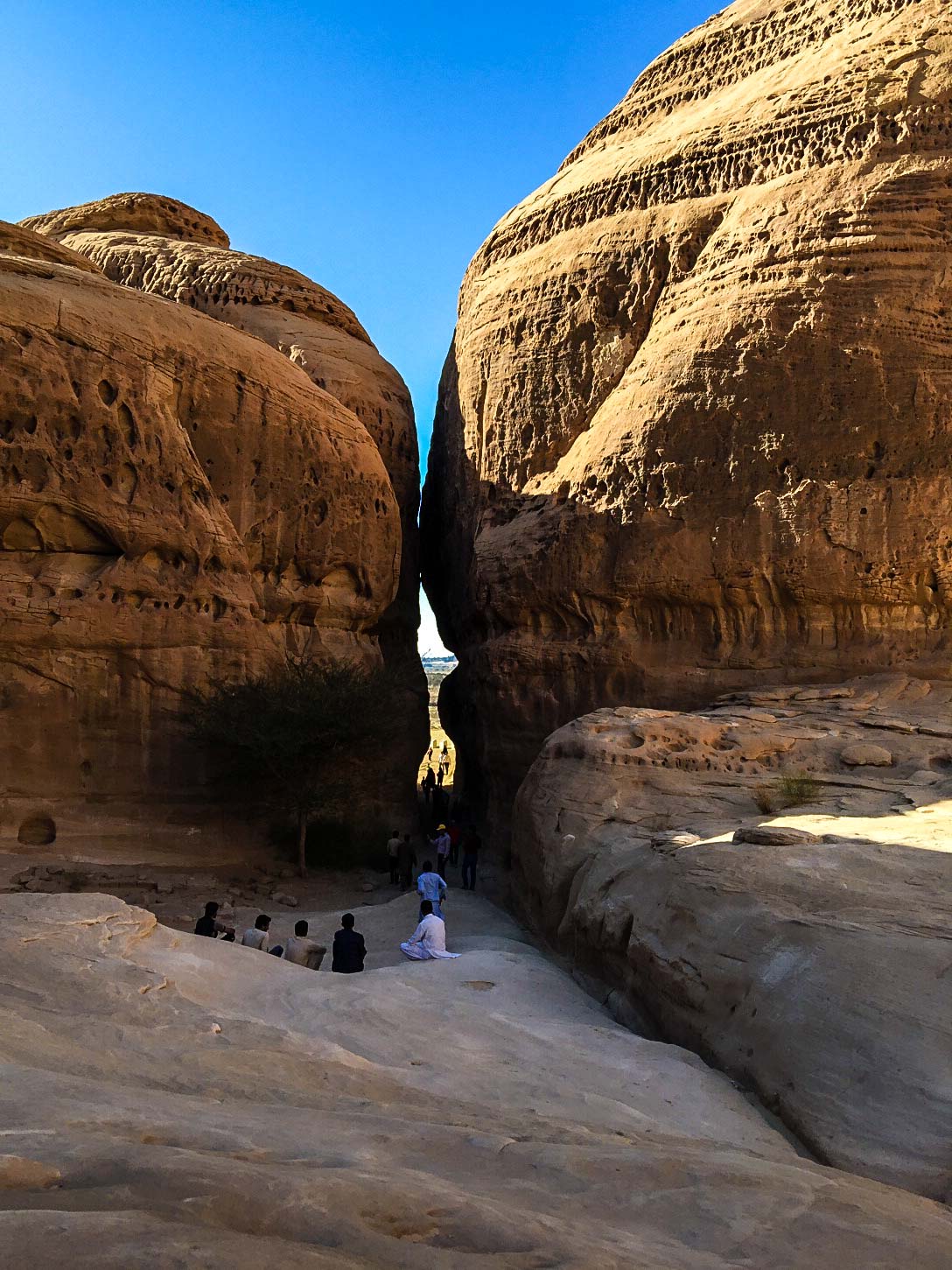
On a geological time-scale, the Arabian Peninsula is young, having broken away from the main African continent about five or six million years ago creating the Red Sea that divides Saudi Arabia from the African continent. It is no surprise, therefore, that this desert has much in common with the Sahara desert. Its sands have the same orange coloration due to the presence of iron oxides.
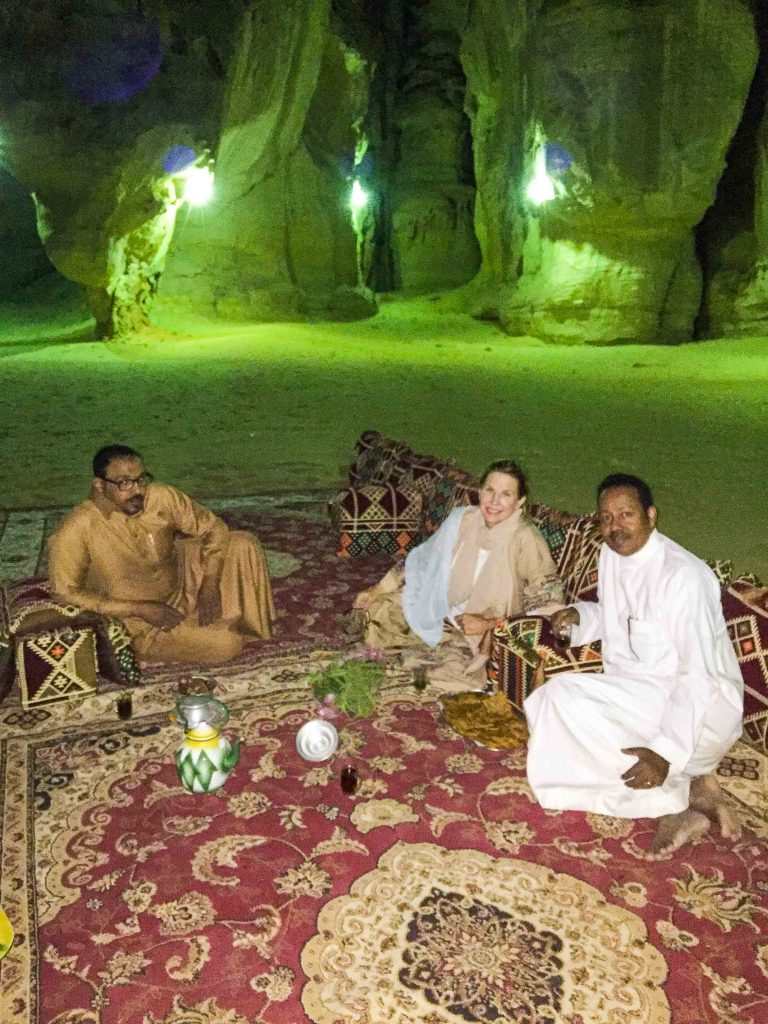
That evening…
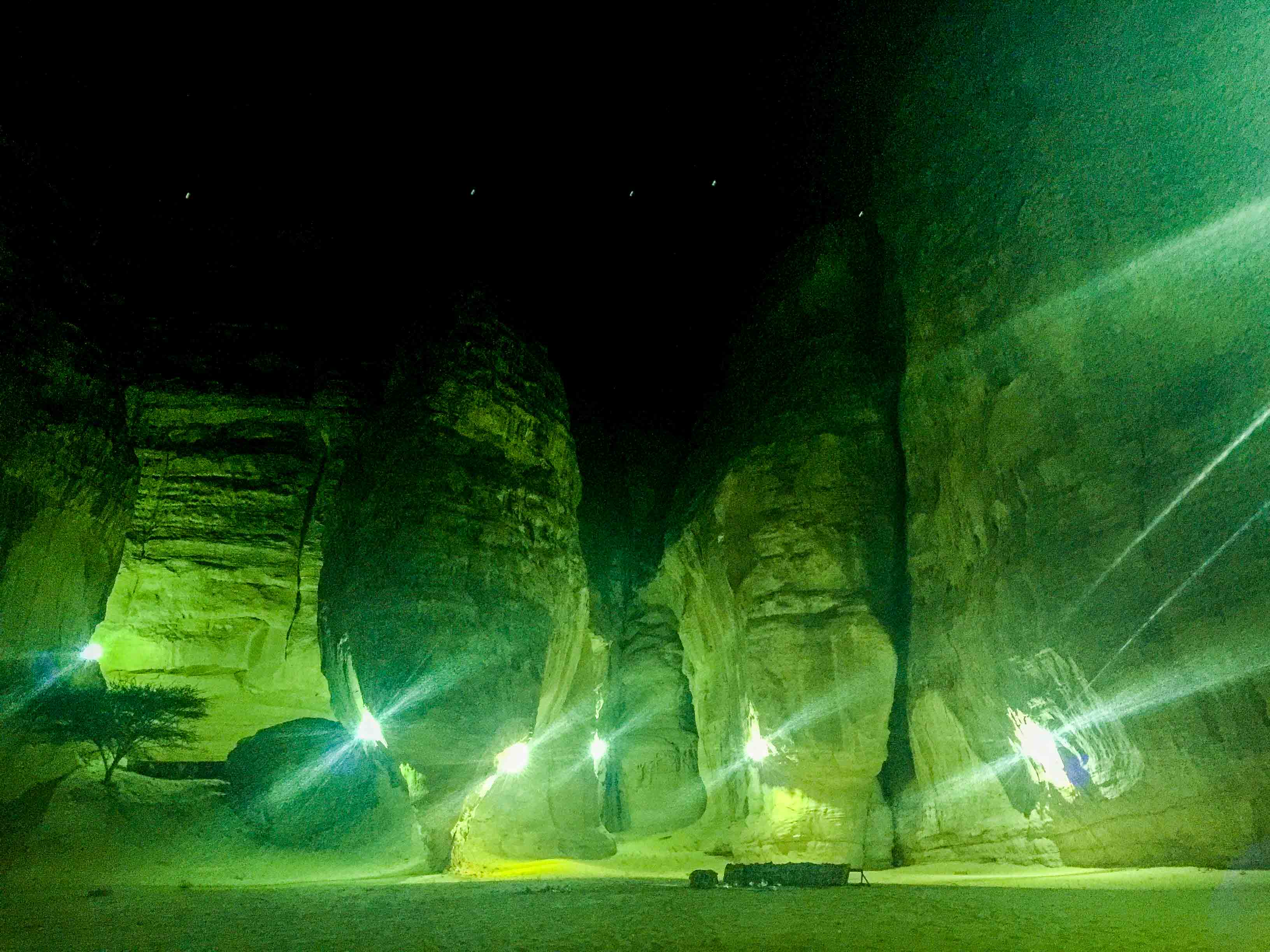
Bird tracks in the desert sand.
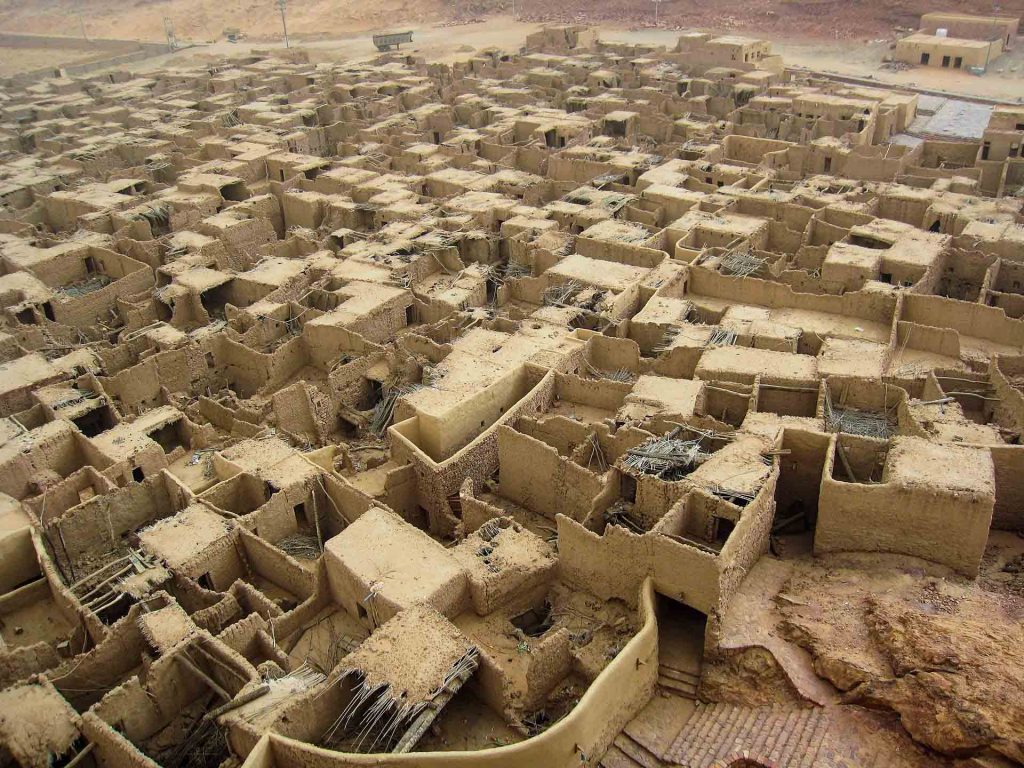
The walled city of Al-Ula was founded in the 6th century BCE near an oasis in the desert valley with fertile soil and plenty of water. It was located along “Incense Road,” the network of routes that facilitated the trading of spices, silk and other luxury items through Arabia, Egypt, and India. The town was reconstructed in the 13th century. When the cramped space and poor infrastructure didn’t meet 20th century standards, it was abandoned by residents for a new town nearby. The last family left in 1983, making it a ghost town.
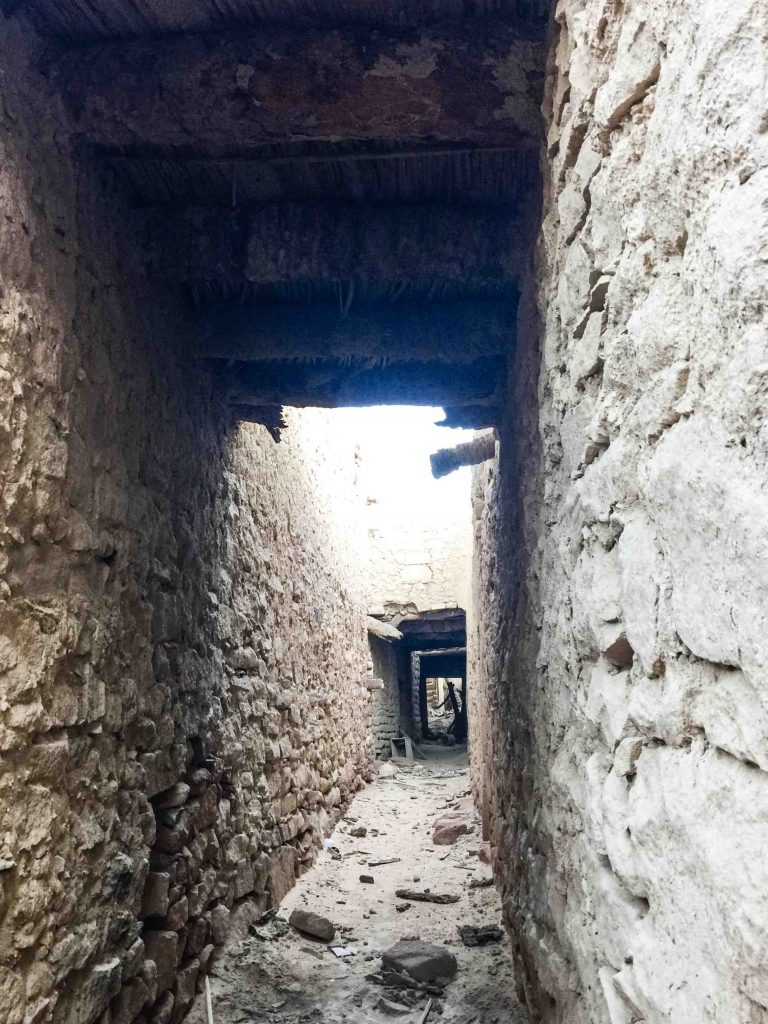
Houses in the old town were built around a hill away from valleys and floods. The lower floors of the houses were built out of stones carried from the ancient site of Al-Khuraybah, while the upper floors were built out of mud brick. The town was laid out to facilitate defense; houses were built adjacent to one another thereby forming a wall around the city.
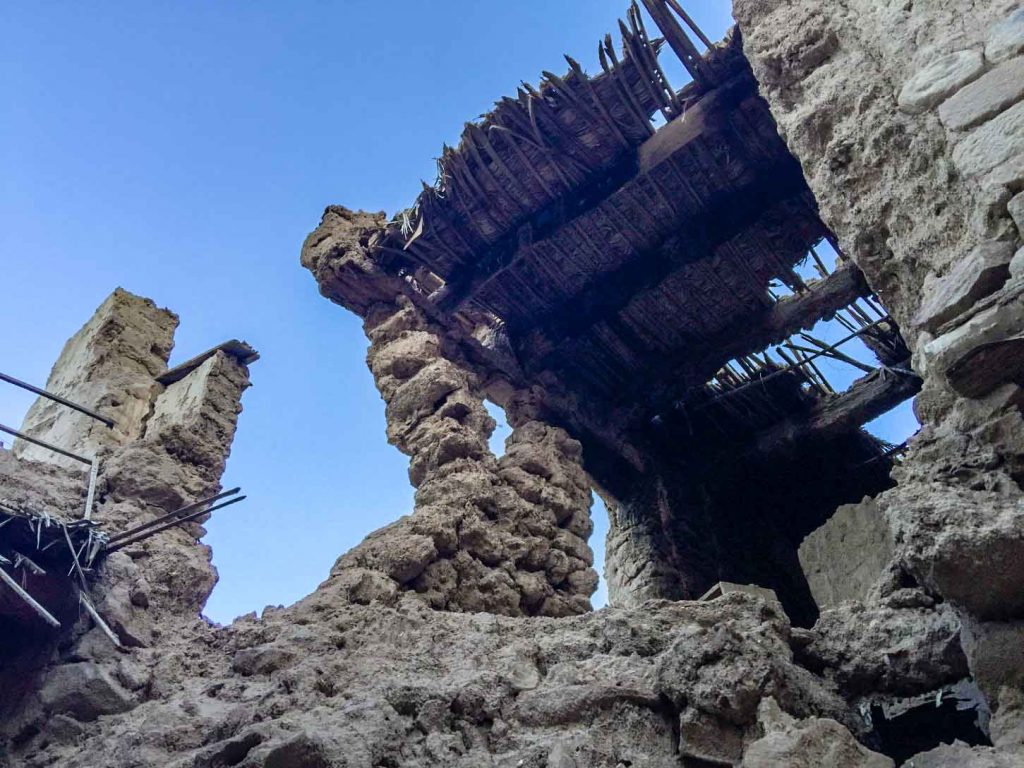
There were 1032 houses in the town separated by narrow lanes.
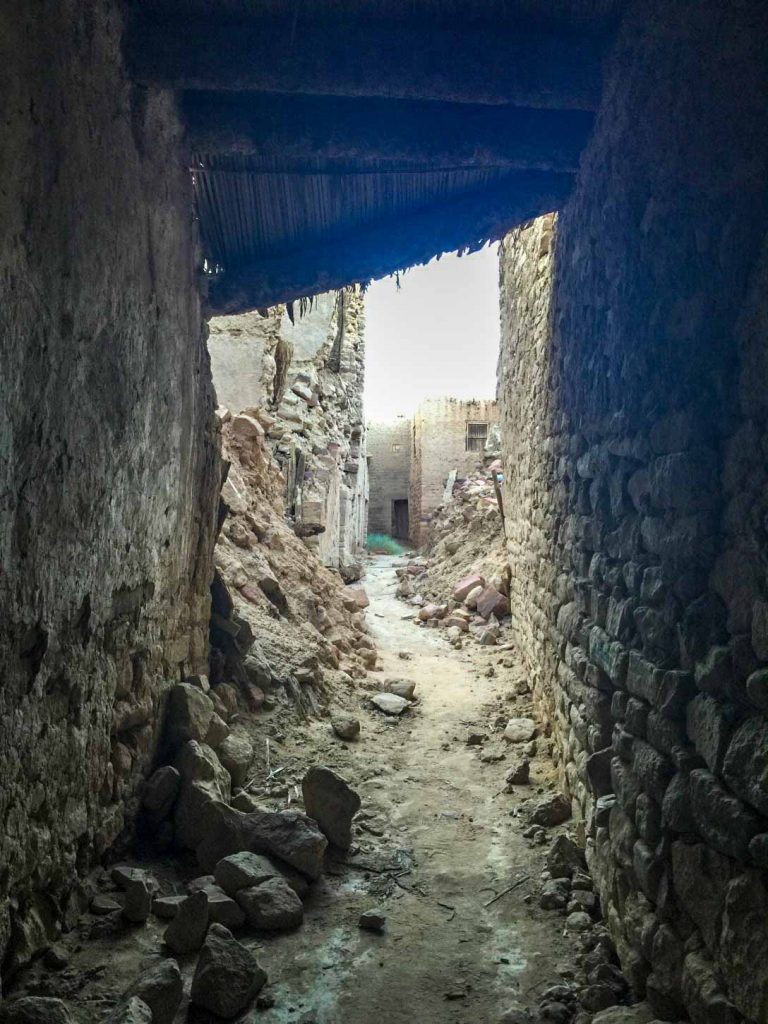
The town’s 14 gates were opened in the morning and closed in the evening; the local name of these gates was Aswar. Houses contained two floors. The first floor was used for gatherings, receptions, and storage. The second for living space.
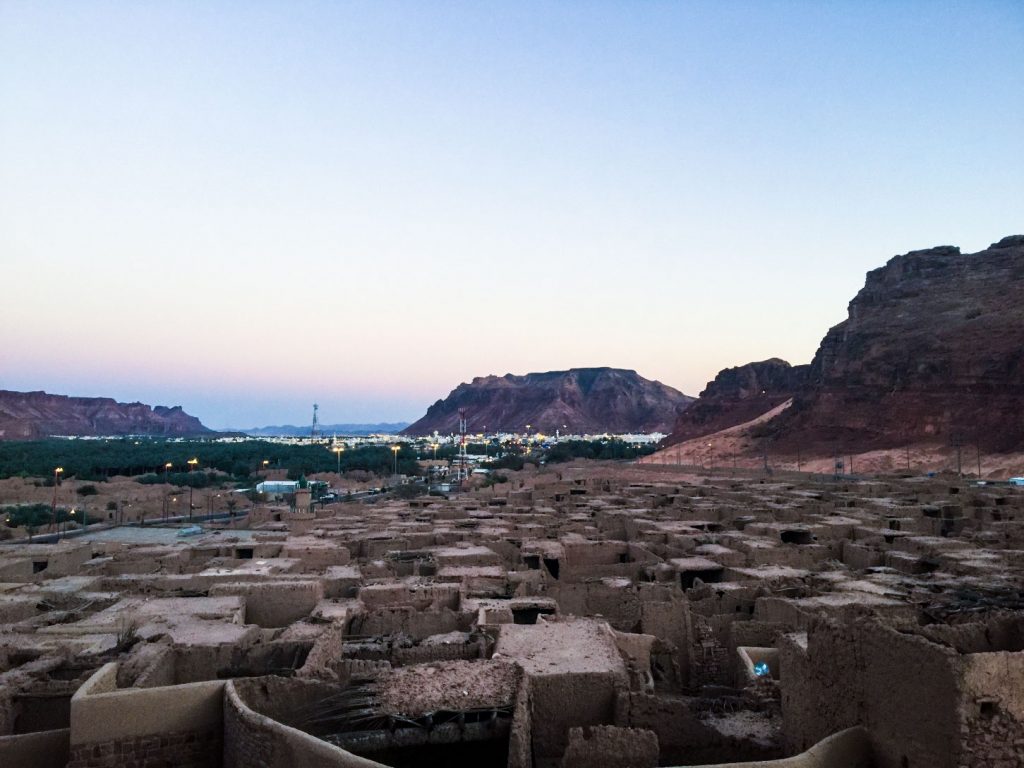
In 628 CE, the town of Al-Ula was described as a town that lies in the middle of the valley among numerous date palms. The report said it was a small town with a fort on top of a mountain. It was said to have springs of water which were used for irrigation.
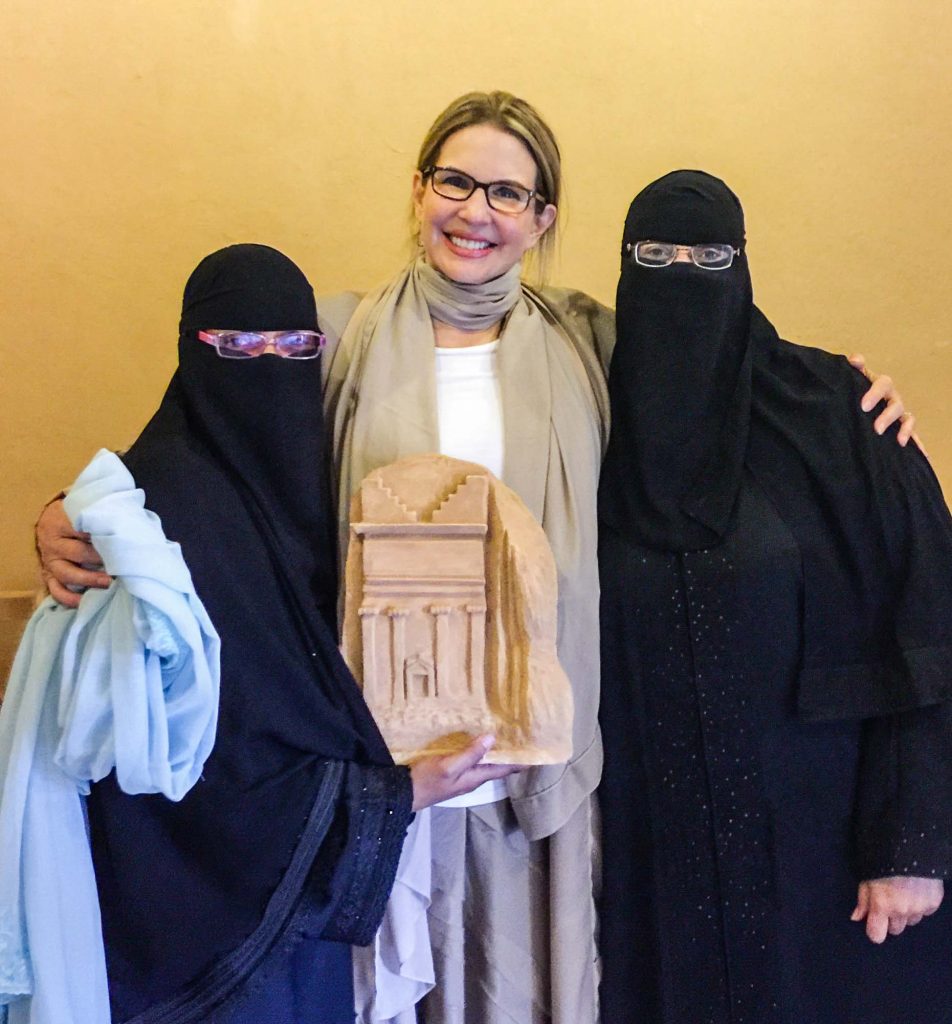
Shop keepers in Al-Ula opened their shop for me. They gave me this wonderful souvenir from Madain Saleh. The women themselves participated in the carving of this replica. I asked them if they were married. “Not yet.” Most of the women in Al-Ula prefer to be completely covered. Some of them even wear black gloves. The women were so warm and welcoming. The women were very affectionate with one another, as were the men with one another. I was welcomed by both men and women with open hearts and legendary hospitality.
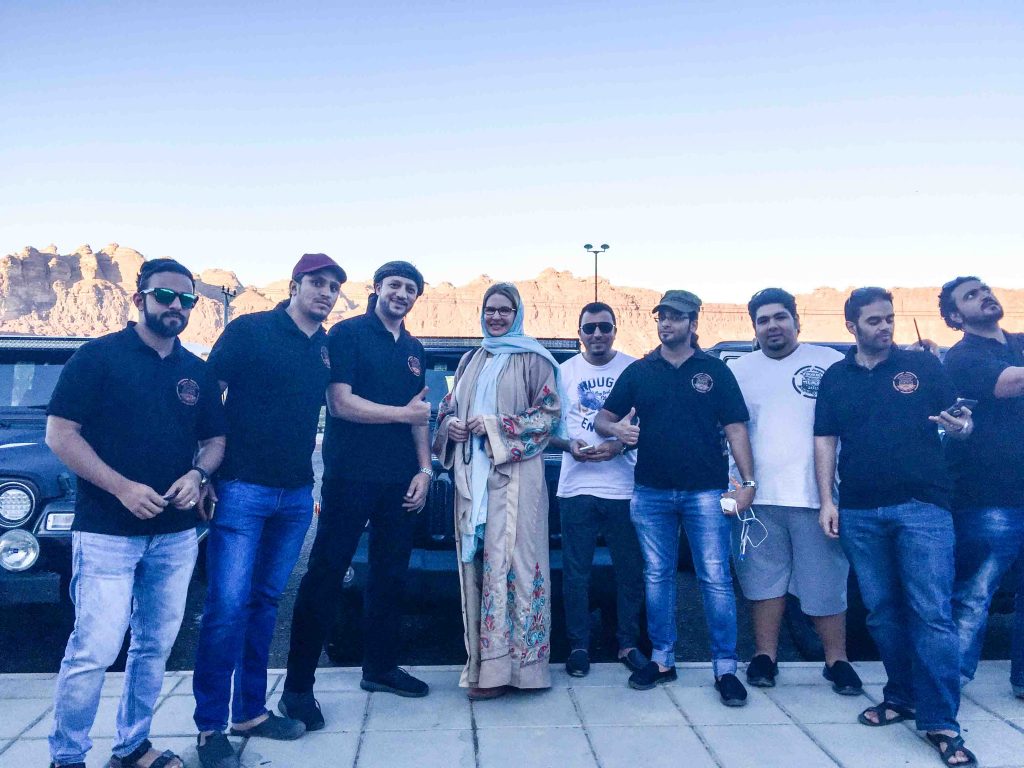
Outside of the shop we ran into “Saudi Jeepers” from Jeddah just arriving for a weekend of sand dune driving. They asked us to come along with them for a late afternoon adventure.
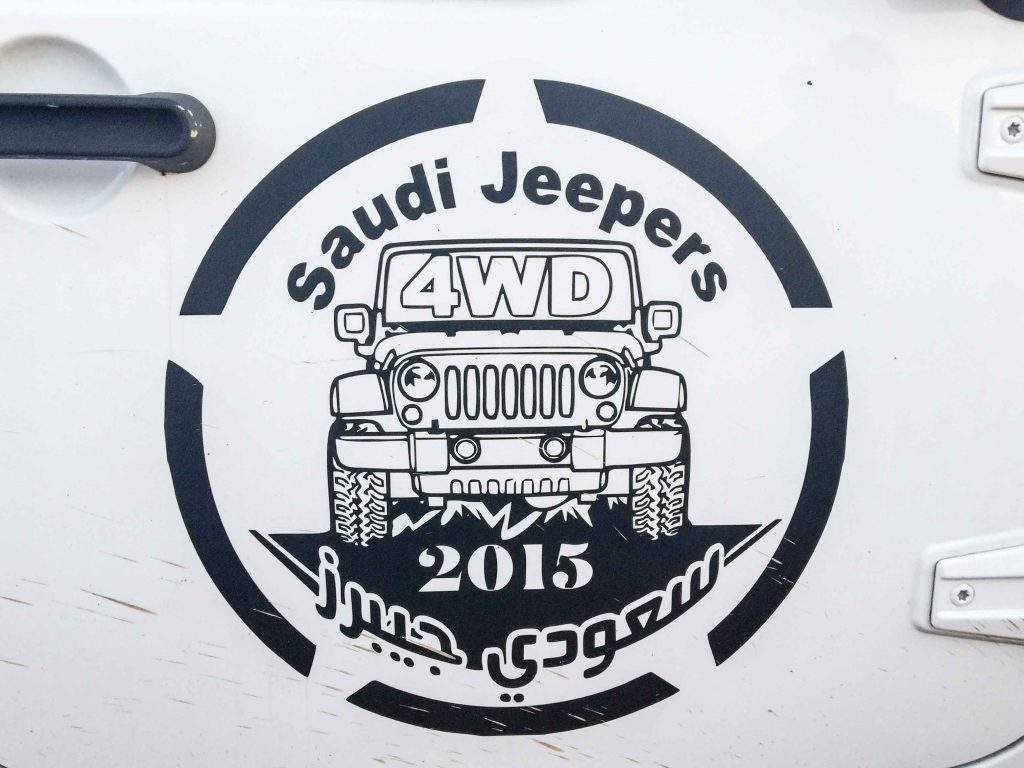
We followed the Saudi Jeepers caravan to their favorite sand dune.
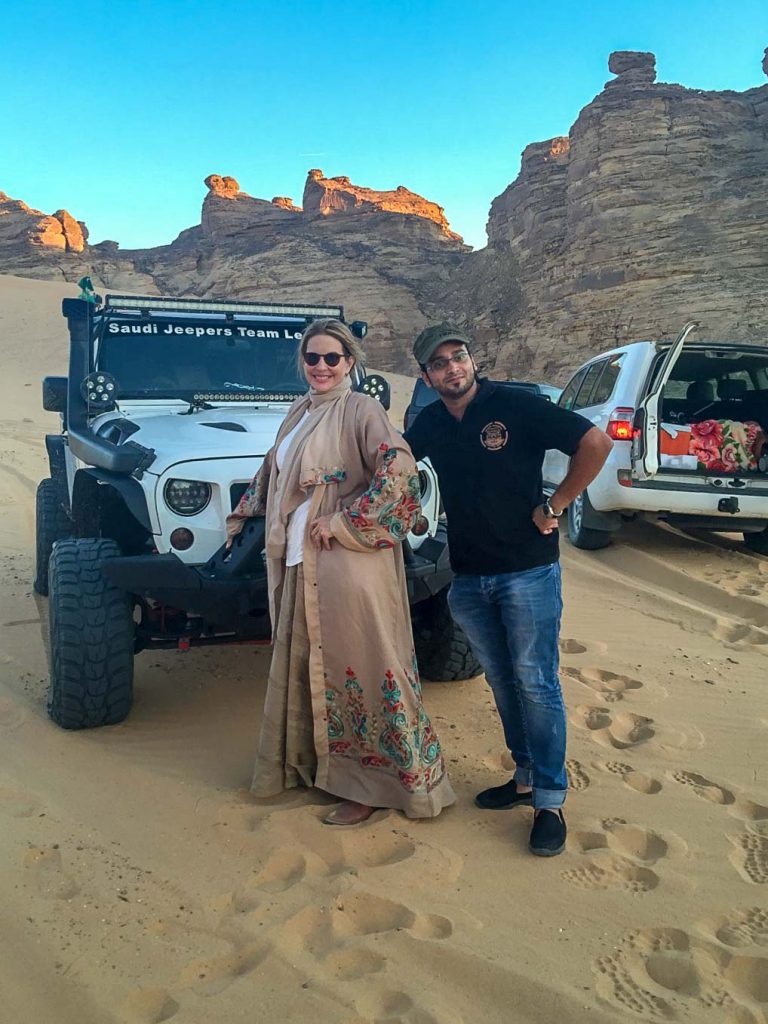
This gentleman was the Saudi Jeepers Team Leader. He asked me if I wanted to go with him in his Jeep to ascend/descend the dune. Of course, I was thrilled to do so! I asked him if I could remove my hijab/scarf. He immediately said “Please be comfortable!” The men were friendly, modern, fun loving, and were totally respectful.

Buckled in and ready to go!
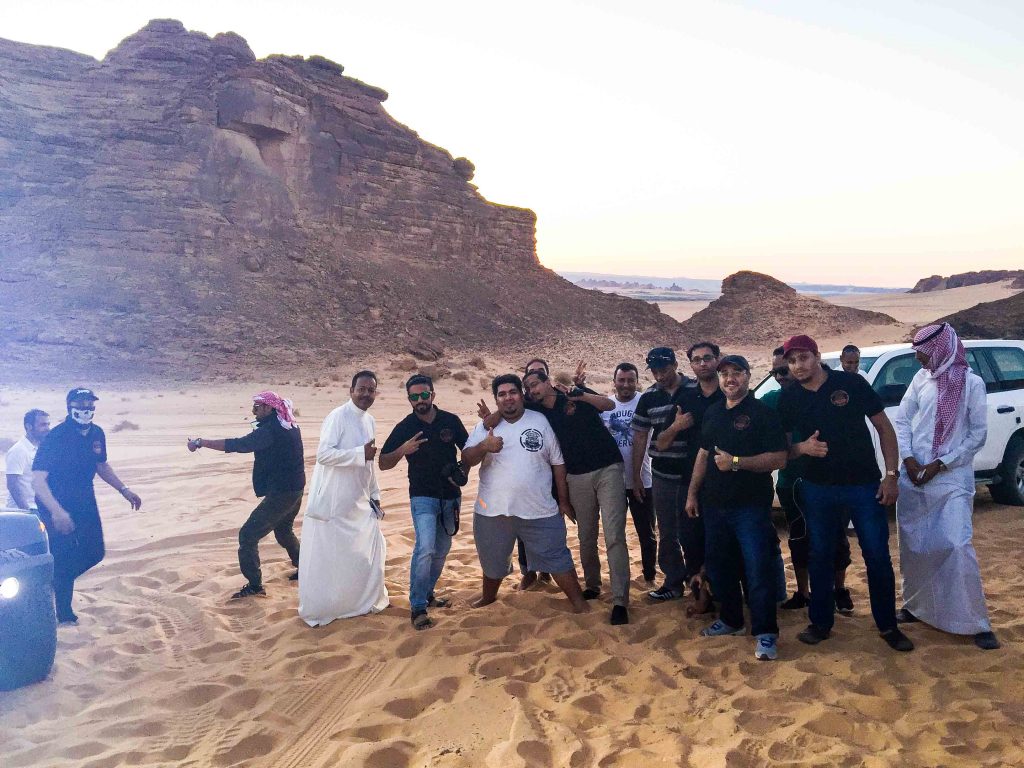
Clearly these men were great friends.
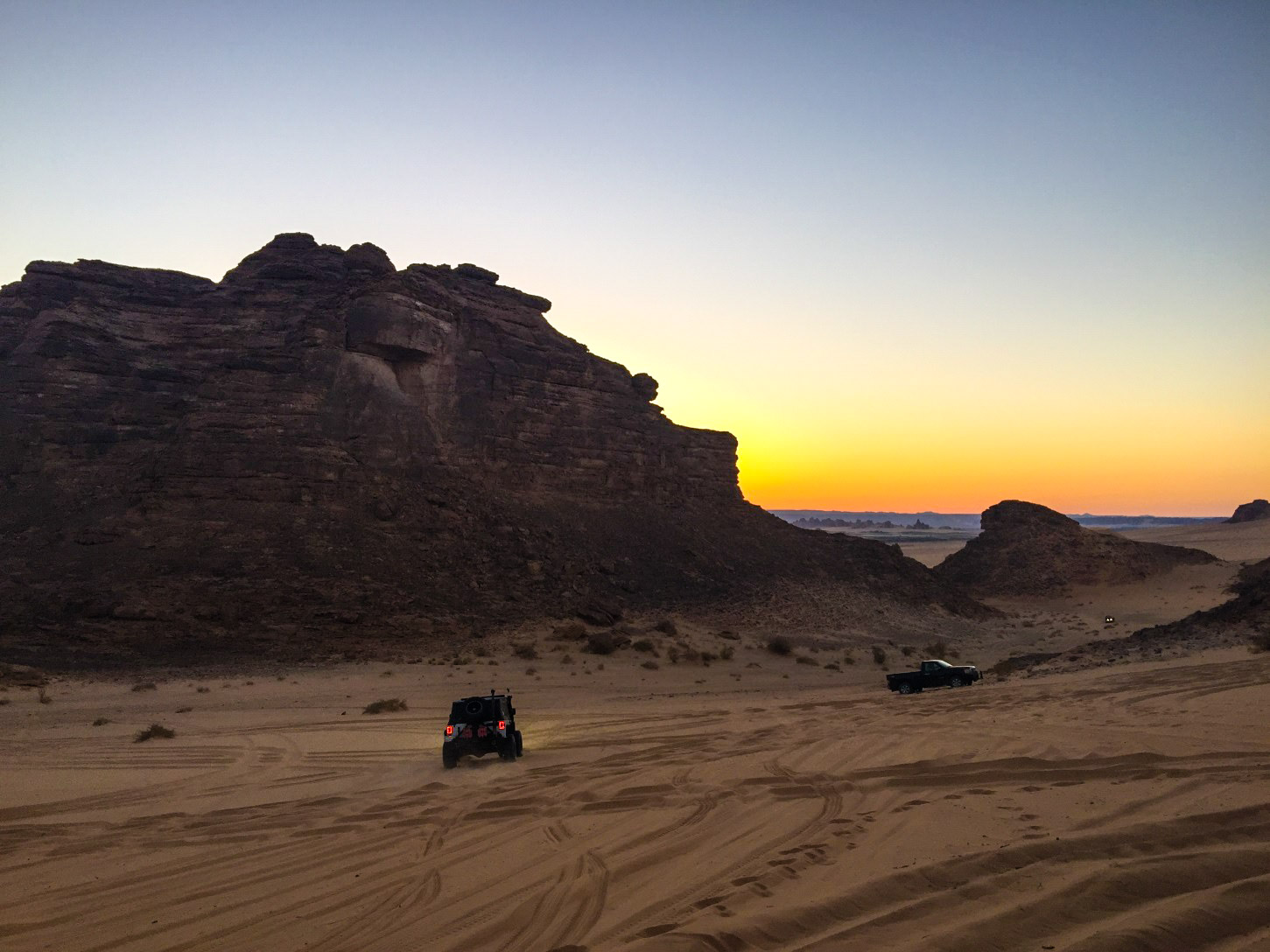
Dr. Mohammed H. Khlais Al-Harbi.
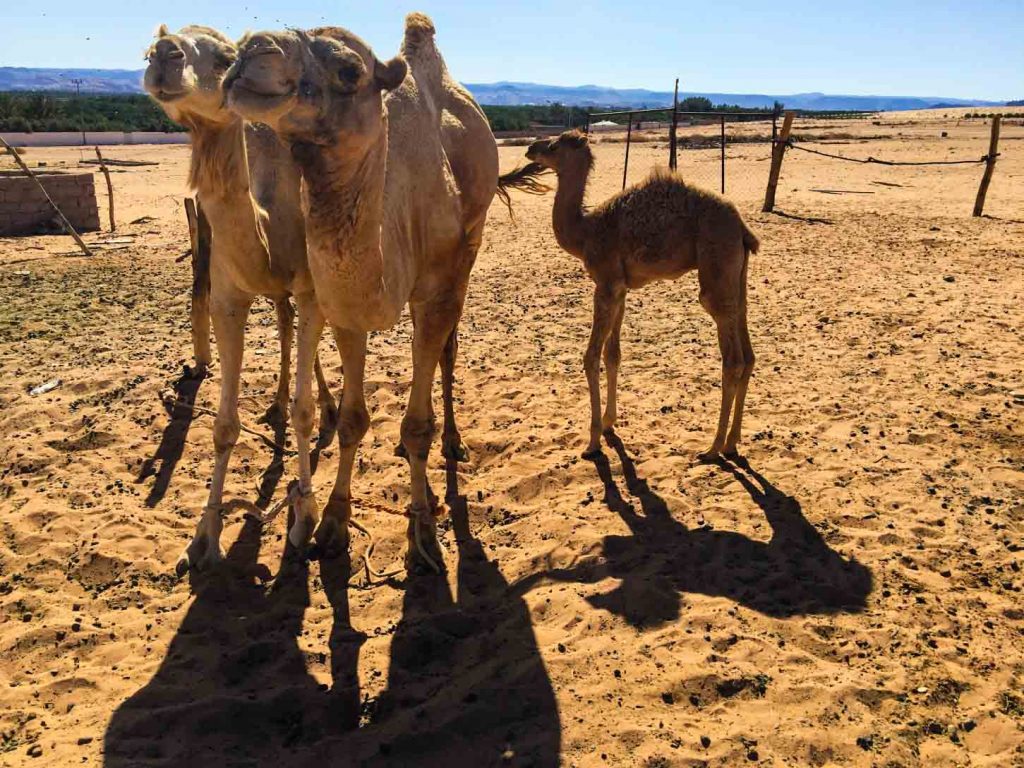
Camels’ nostrils close to keep sand at bay, and they have bushy eyebrows and two rows of long eyelashes to protect their eyes. Large, tough lips enable them to pick at dry and thorny desert vegetation. Big, thick footpads help them navigate the rough rocky terrain and shifting desert sands.
Camels are over seven feet tall at the hump. The hump stores up to 80 pounds of fat, which a camel can break down into water and energy when sustenance is not available. These humps give camels their legendary ability to travel up to 100 miles without water. The average life expectancy of a camel is 40 to 50 years.
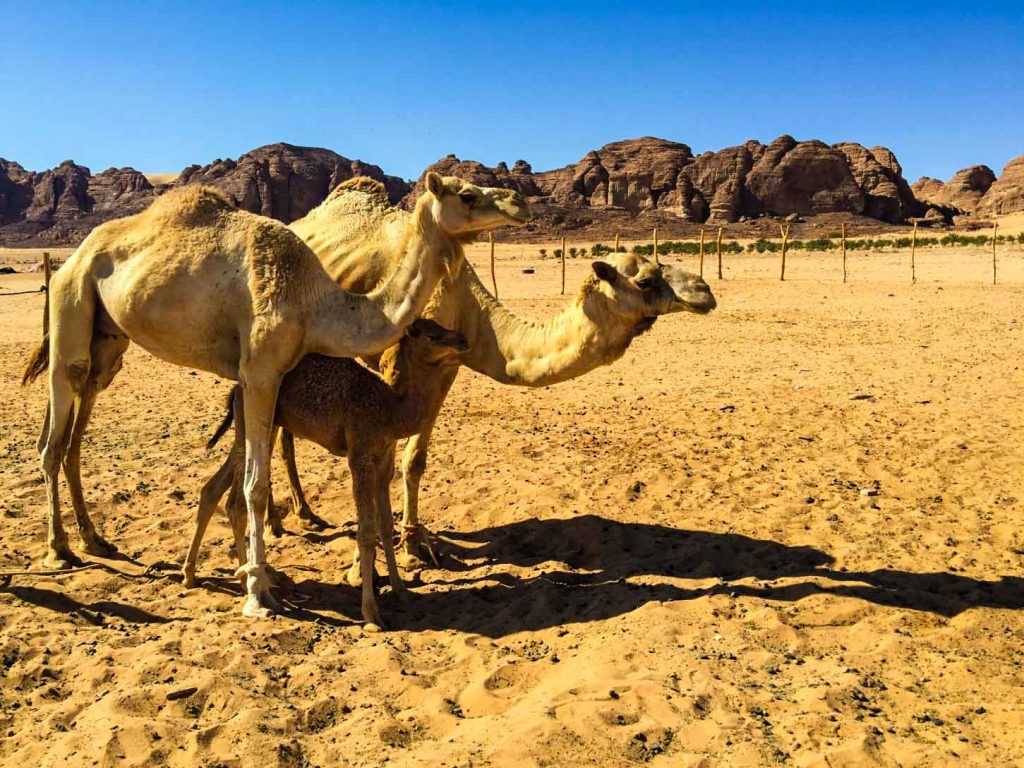
When this calf felt shy, he would back up underneath his mother’s front legs while his father stood by his family. Camels are very social and like to greet each other by blowing in each other’s faces. Camels can run 40 miles per hour. When they are provoked, they spit greenish substance from their stomach. Also, they can use all four legs to kick their opponent in self defense.
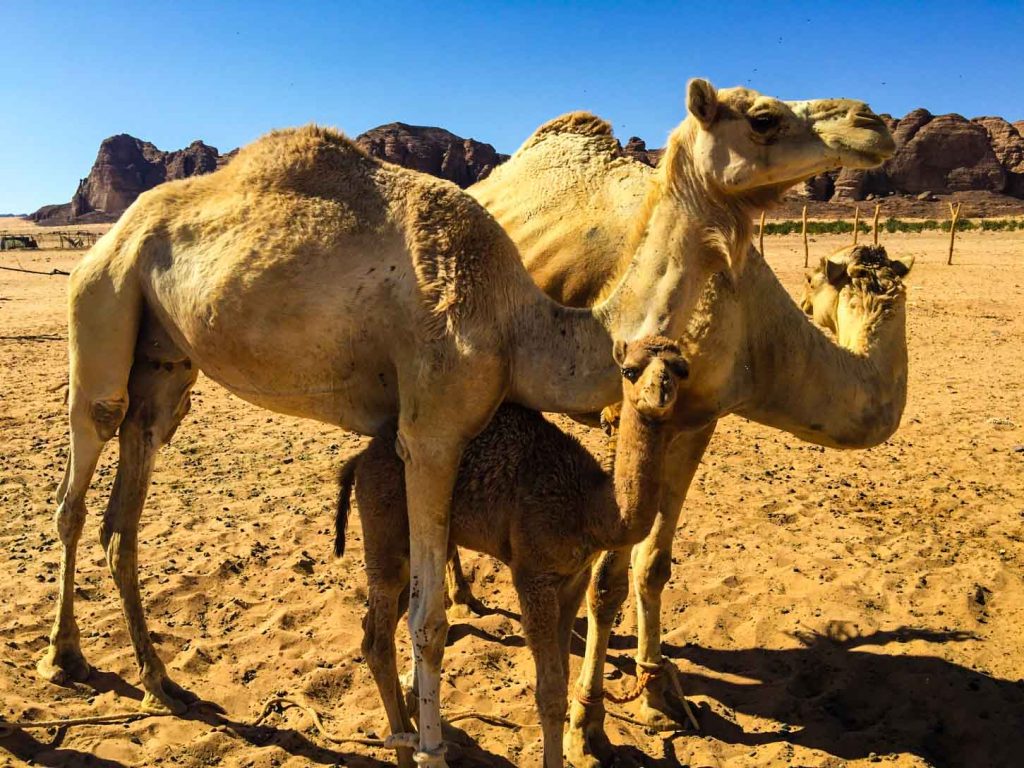
Camels rarely sweat, even in desert temperatures that reach 120°F, so when they do take in fluids they can conserve them for long periods of time. When camels refill, however, they soak up water like a sponge. A very thirsty animal can drink 40 gallons of water in less than 20 minutes.
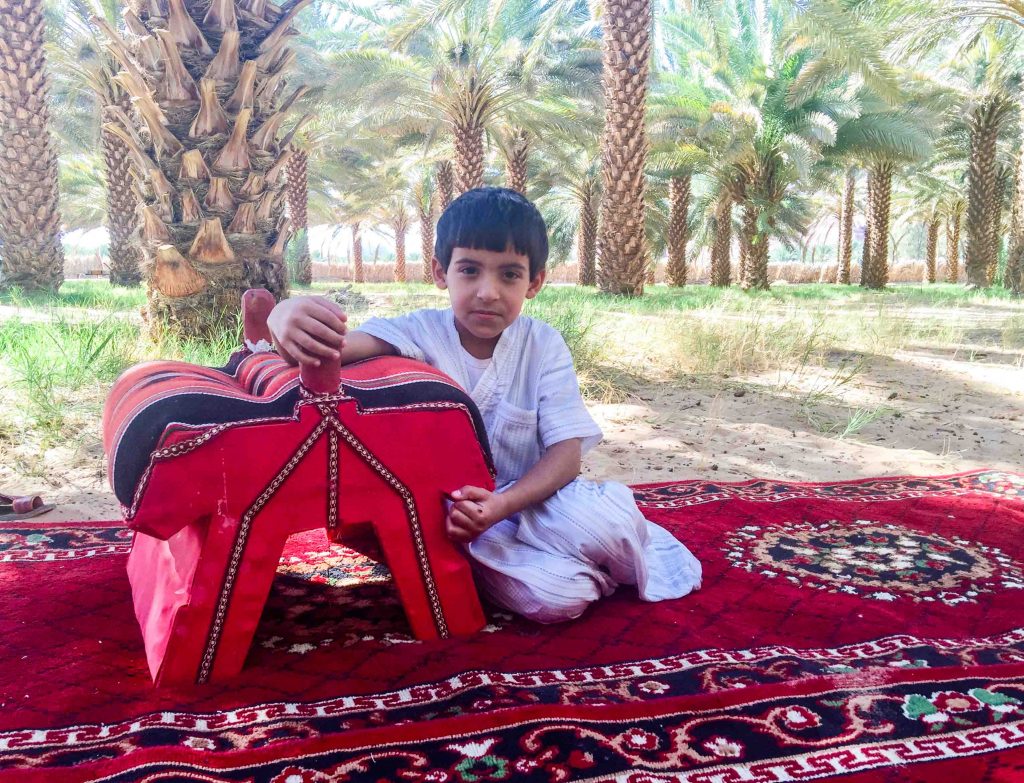
A picnic was organized in the orchard filled with the scent of lemon, sweet orange, tangerine, and date palms.
Dates are one of the major fruits found in Saudi Arabia. They have medicinal and nutritional value.
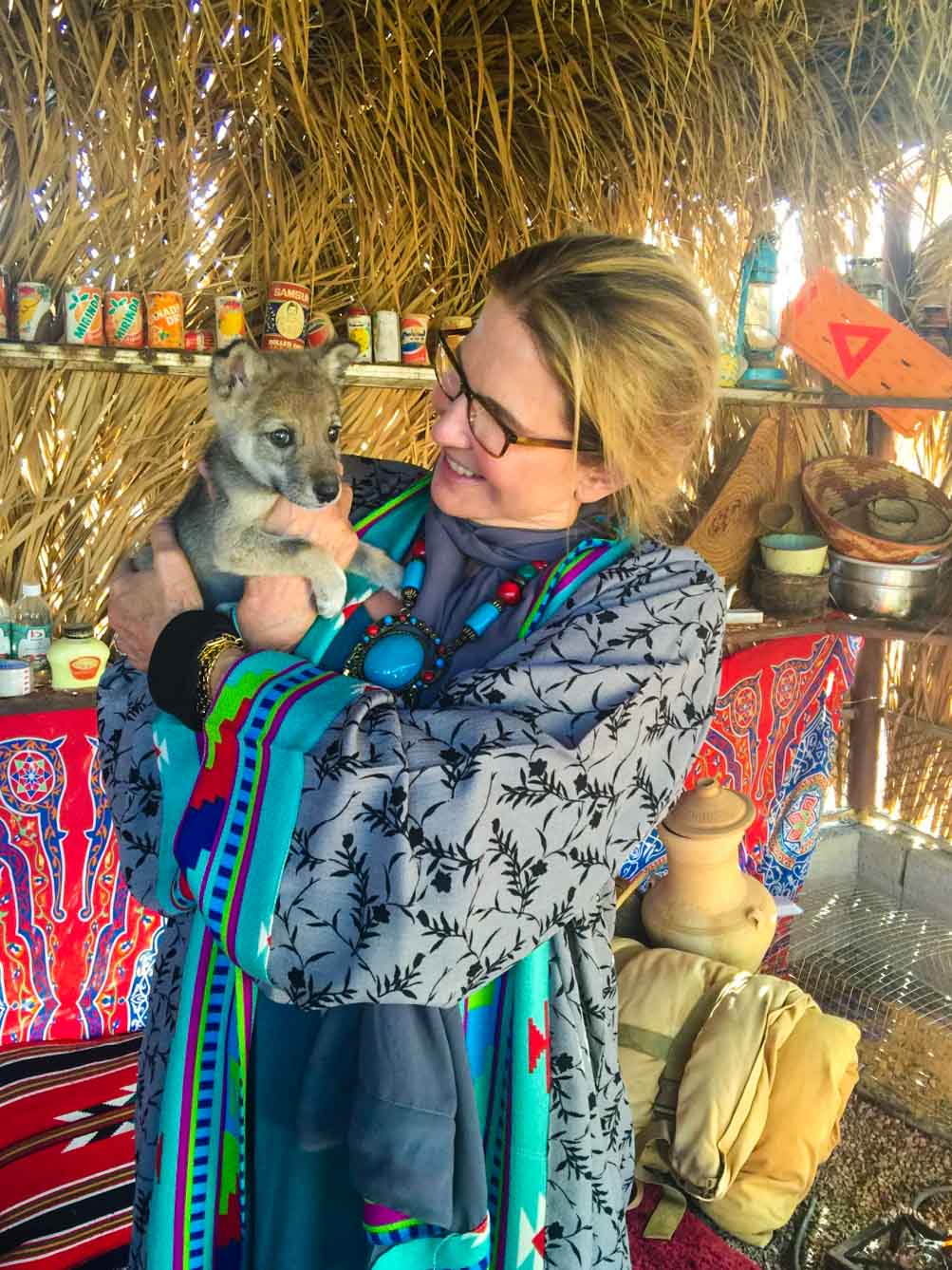
In a gesture of hospitality, the owner of the date farm gifted this wolf pup to me. I was told they found him on the side of the road next to his mother who had been hit by a car.
This wolf pup did get a bit exasperated by my affection.
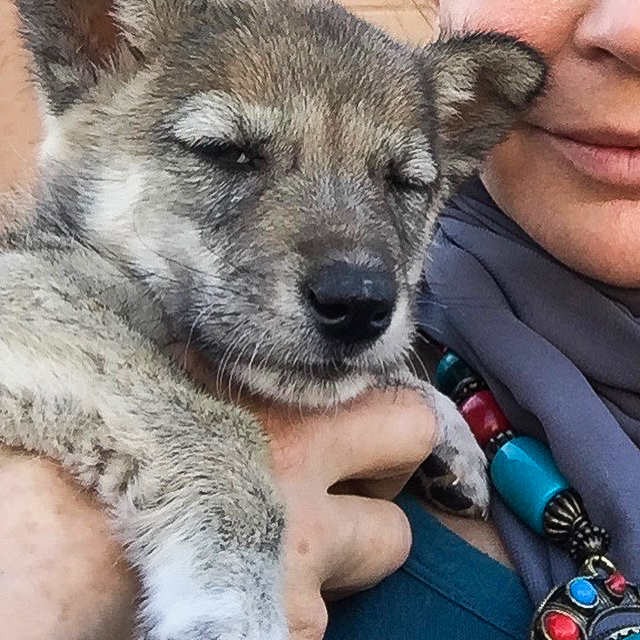
I wanted to take him home with me but I understood it would have been difficult getting him through Customs. I mean, really, look at that face!
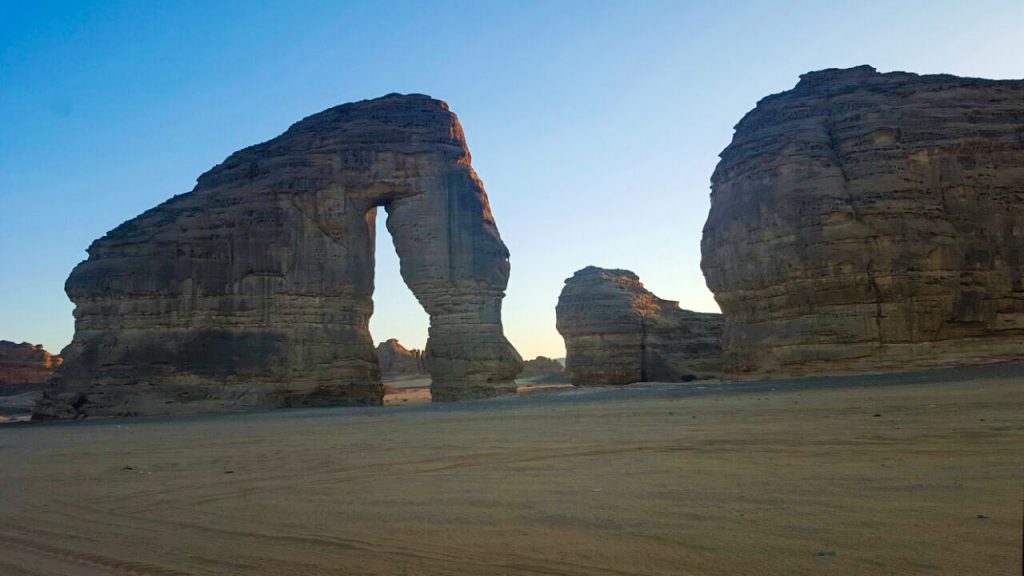
Near Al Ula, Elephant Rock is a distinctive and massive formation shaped by erosion over thousands of years. Greenery even appears after the winter and spring rains.
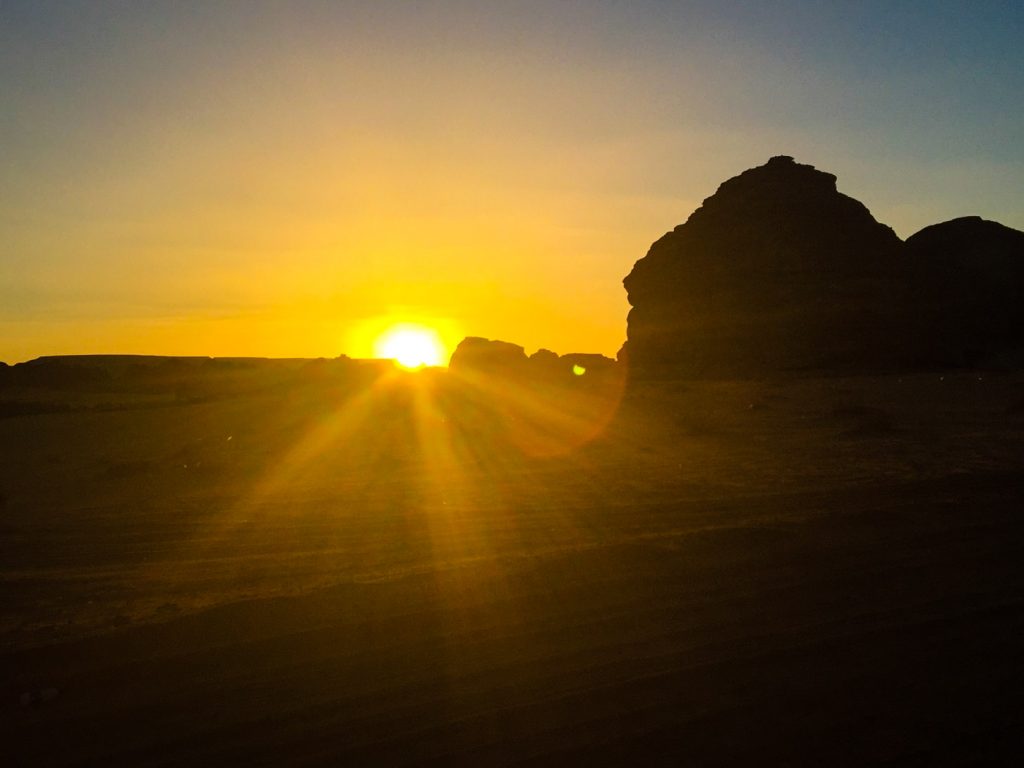
Good night, Madain Saleh.
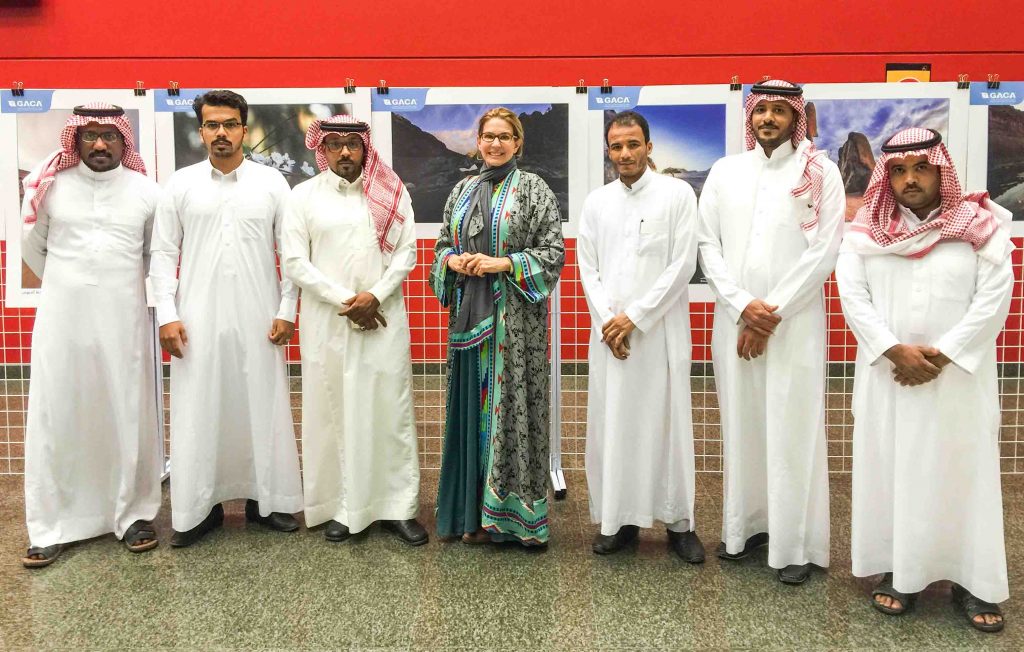
The photographers who greeted us at the airport when we arrived came back to wish us farewell upon our departure. Such noble, authentic men. Environmentalists. Proud of their work, which hung behind us. Proud of their town. As you can see, I was not wearing my head scarf here either. Saudi Arabia is everything you have heard it to be and nothing like you have heard it to be.
Share this:
- National Council Home
- Profile, Vision, & Mission
- Board & Staff
- Financial Statements & Reports
- Privacy Statement
- Terms of Use
- Annual Arab-U.S. Policymakers Conference
- Youth Leadership Development Program / Model Arab League
- Washington, DC Internship Programs
- Malone Fellowship in Arab and Islamic Studies
- Public Affairs Briefings
- Study Abroad
- Arab Cultural Institute
- Publications Library
- National Council Analyses & Assessments
- Model Arab League Research Resources
You must be logged in to post a comment.
How to Get to Hegra (Madain Saleh) and the Al Ula Valley
When traveling to Saudi Arabia, you might wonder how to get to Hegra and the Al Ula Valley. As one of the country’s foremost sights, you’re sure to want to visit the wondrous rock-cut tombs of Hegra, known to locals as Madain Saleh or al-Hijr. And you won’t want to miss the other breathtaking discoveries to be had in the Al Ula Valley. All of the best spots are covered in our guide to visiting Hegra and Al Ula . These range from the ancient mud-brick town of Al Ula to the Ekma Gorge or the nearby volcano fields.
Situated in the country’s northwest deserts, getting to Hegra and the Al Ula Valley might seem impossible. In fact, the UNESCO World Heritage Site is in fact very easy to reach. And once you’re already there, why not take a 3 day tour of Saudi Arabia and Hegra from Al Ula to learn all of its secrets? Here are the best ways to reach Hegra from Saudi Arabia, as well as Aqaba and Israel.
How to Get to Hegra From Riyadh
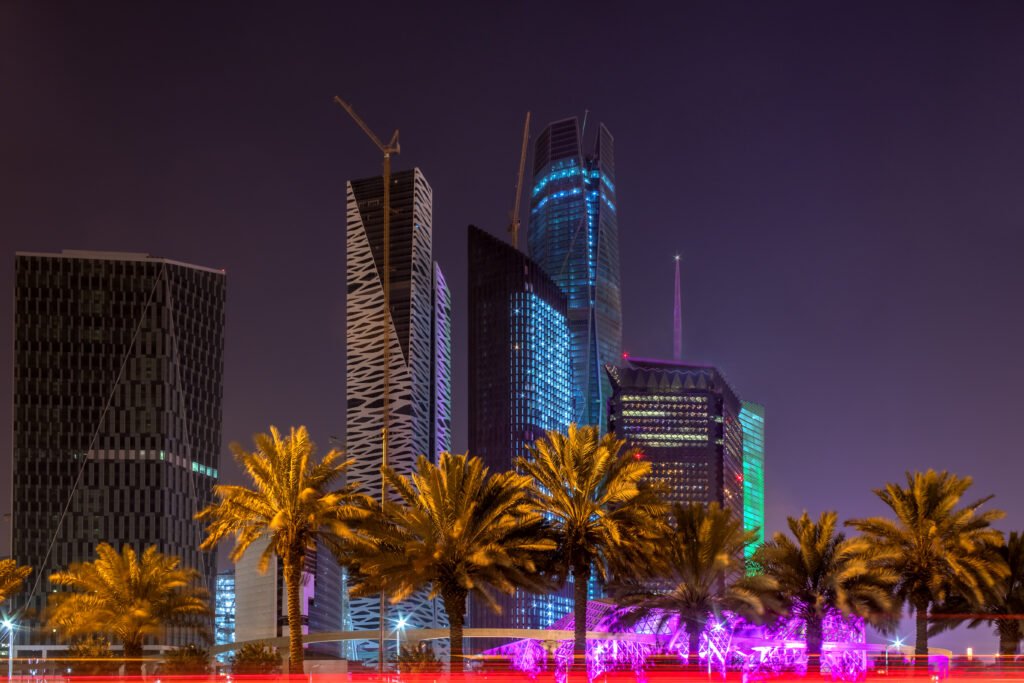
With transport already arranged and expert guides on hand, guided tours are the easiest way to reach Hegra, and allow you to simply sit back and enjoy the landscapes of a country still shrouded in mystery. Removing the risk of getting lost, or of losing insight on the day because of the language barrier, calculated minute for minute, guided tours are in fact a cost-effective way to explore Hegra and Al Ula, and a whole lot less stressful too.
Should you decide to go it alone, the Saudi capital of Riyadh is approximately 10 hours by road from Hegra. Driving in the kingdom is fairly straightforward, since the roads are well-maintained, however accident rates are some of the highest in the world. Fuel is inexpensive because of Saudi’s vast oil reserves, at around $0.4/liter, and vehicles can be rented in Riyadh for approximately $35/day. All you’ll need is an international driving license.
The Saudi Public Transport Company SAPTCO operates comfortable air-conditioned buses from Riyadh to Al Ula, which take approximately 13.5 hours from end to end and cost around $60. While these coaches stop regularly for comfort breaks, there’s obviously no way of exploring sights along the route more fully. Coach stations are also often inconveniently located for travelers. Local taxis will then take you on to the valley, 22 kilometers away. The fare will cost you $10-15 one way, although you’ll need a vehicle to explore the spaced-out ruins too.
If time is not on your side, the best way of getting to Hegra from Riyadh is to fly, which reduces the travelling time down to around three hours. Saudia, the national carrier, flies into Prince Abdul Majeed bin Abdulaziz domestic airport at Al Ula four times weekly, with flights evenly distributed throughout the week. The airport is roughly 35 kilometers south of Al Ula, and is connected to the city by taxis.
How to Get to Hegra From Jeddah
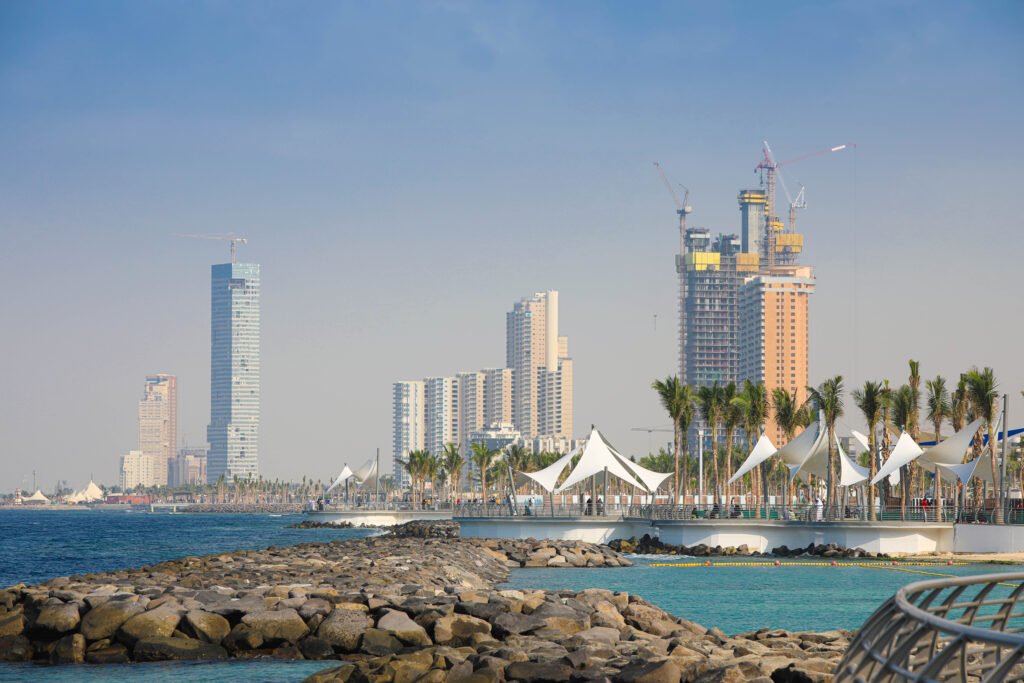
A whole string of archaeological sites and other attractions newly opened to the wider world exist between Jeddah and Hegra, and while information on them remains difficult to come by, a guided tour ensures you miss none of what this intriguing country has to offer.
If you’re set on renting a vehicle, the most scenic way of reaching Hegra from Jeddah is to follow the coast of the Red Sea north to the town of Yanbu. King Abdullah Economic City acts as a useful rest stop roughly halfway. You then need to turn inland in a north-easterly direction until Al Ula, with regular directions ensuring it’s difficult to get lost. However, the road journey from Jeddah will take around 8 hours to complete, and more still if using any of SAPTCO’s coach services, costing around $50 per person instead.
From Jeddah, flying remains the most sensible option of getting to Hegra for the time conscious. Flights on Saudia to Al Ula’s modern domestic airport around three times per week in either direction.
How to Get to Hegra From Medina

While non-Muslims are not permitted to visit Mecca, the holiest city in Islam, they are allowed to visit Medina. It has a large number of important sites worth considering on any itinerary to Saudi Arabia.
From Medina, it is a much shorter journey by road than from Riyadh and Jeddah; only four hours or 350 kilometers. It is also a simple journey, with the most direct path following Route 328 north for most of the way. Unfortunately, it is unlikely SAPTCO coaches will take non-Muslim passengers from Medina to Hegra. This is not an official ban and appears to depend on individual ticket sellers.
Both shared taxis and private taxis will complete the whole journey for you at a price. If you bargain well, a private taxi is about $150 one way. Shared taxis are around a quarter of that price per person. This makes a private taxi a reasonable option if you are traveling as a group.
How to Get to Hegra From Aqaba
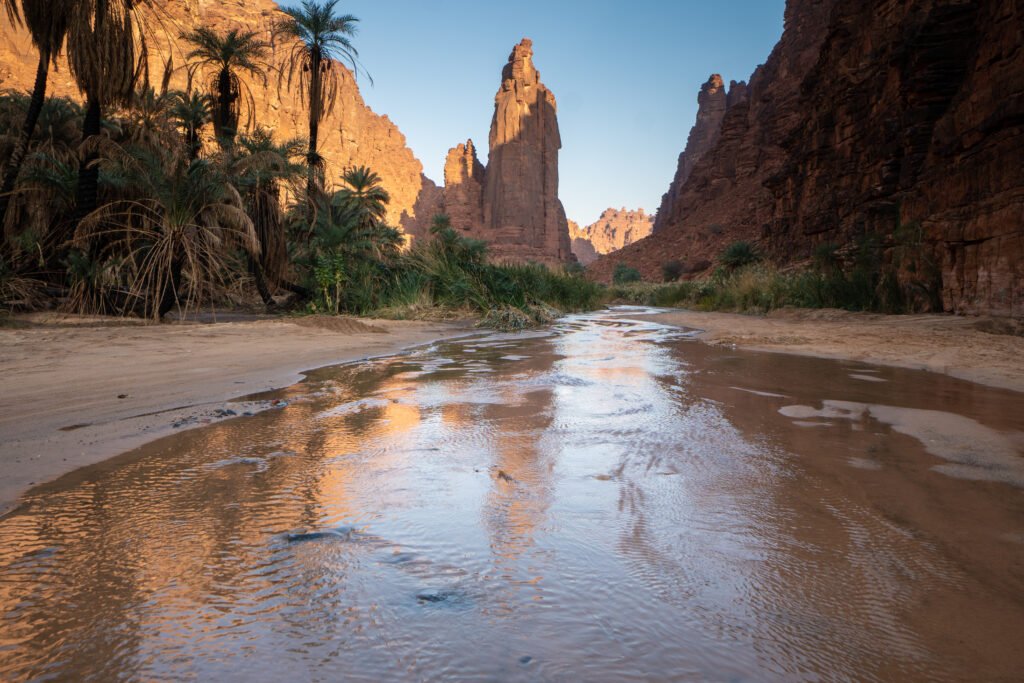
Tours taking in this fascinating archaeological treasure aren’t just an option from inside Saudi Arabia. A number of companies running multi-country tours that take in both Jordan and Saudi, including this 4 day tour from Aqaba . This allows visitors to compare the two most important cities in the Nabatean empire, Petra and Hegra.
Crossing the border from Jordan south into Saudi is pain-free. While opting for a guided tour means there’s someone else who speaks the language to worry about the red tape at the border crossing, it is also possible to do it independently.
From the Red Sea resort of Aqaba, buses and shared taxis run to the two nearest borders with Saudi Arabia. The Dourra border post connects with the Saudi city of Haql on the Red Sea. The Al Mudawara border post lies around two hours and 150 kilometers inland. It has better road connections to Tabuk and its stunning national park, and on to the Al Ula Valley.
Transport to the border will cost around $25, with a similar price for continuing on to Al Ula. Both border posts are open 24 hours a day. You will need to have organized a Saudi visa before traveling, as they are not available at the border. Expect border formalities to take around an hour, and a little longer at peak times and on public holidays.
How to Get to Hegra From Israel
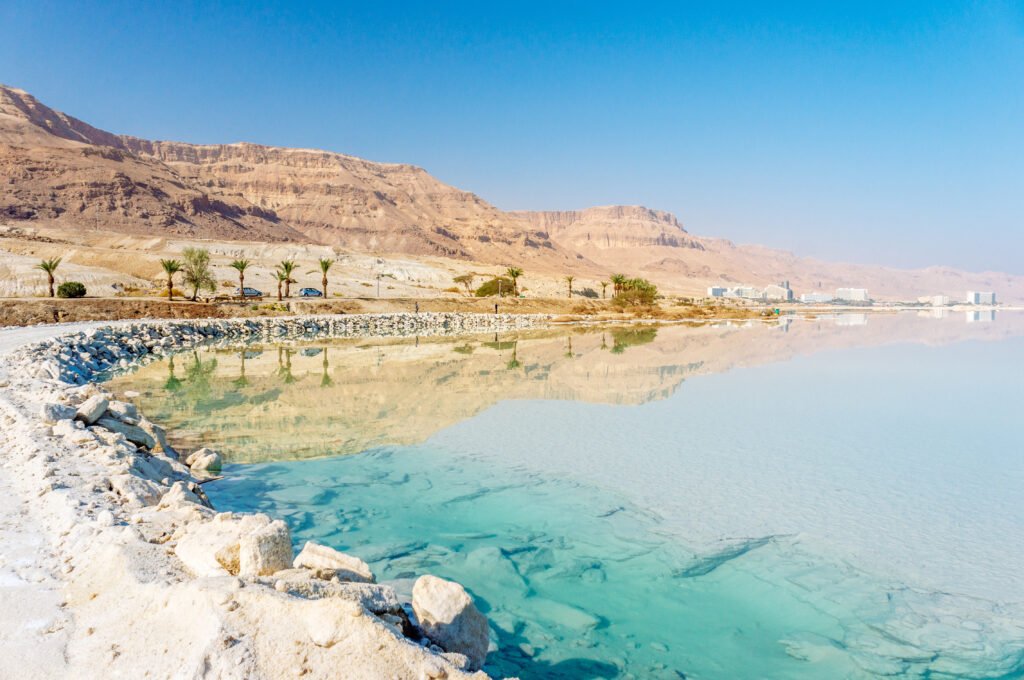
Even if you begin your journey around the Middle East in Israel, it is still possible to hand all the hard work of organizing transport and planning itineraries to the experts. Many tours to Hegra operate from Israel too. They include this 13 day highlights of Jordan, Israel, and Saudi Arabia tour that leaves from Tel Aviv, or this 4 day tour from Eilat . Given the site’s location in the northwest of the country, travel times are no greater than from Riyadh or Jeddah either.
At present, political disagreements mean there are no direct flights between Israel and Saudi Arabia. However, it is possible to travel overland between the two countries by road, via Jordan. If you have already organized a visa for Jordan, you can use any of the borders from Israel. If you haven’t, you can buy a visa at the border. Your best option is the Arava border near Eilat. The border is open daily from 06.30 to 20.00 Monday to Thursday and 08.00 to 20.00 on Fridays and Saturdays. Visa prices vary depending on nationality, but cost about $60. On crossing the border, the fastest route onward is to take a taxi to Aqaba. It costs around $15, and then follow our guidance above from Aqaba to Hegra.
Visiting Saudi Arabia’s Archaeological Gems
This guide on how to get to Hegra and the Al Ula Valley covers both independent and guided travel. Visiting this area is well worth the effort, and can be done from across the Middle East. Be sure you know what to wear in Saudi Arabia , and when to visit Saudi Arabia !
Subscribe for insider tips to Saudi Arabia Enter your email address to stay in-the-know of what's new in Saudi Arabia. We promise to only send you guides to the best experiences. Email Keep Me Updated
Recommended

Guide to Visiting Hegra (Madain Saleh) and the Al Ula Valley

Is Saudi Arabia Safe to Travel To?

What to Do in Saudi Arabia

What to Wear in Saudi Arabia

Best Time of Year to Visit Saudi Arabia

Celebrating the Saudi Seasons

Desert Blaze Run in Al Ula. August 26, 2023

How to Get From Jeddah to Al Ula

Azimuth Festival in Al Ula with Jason Derulo, DJ Snake & More. September 21-22, 2023.

How to Get From Riyadh to Al Ula
- COLLABORATIONS
- PHILIPPINES
- NETHERLANDS
- UNITED ARAB EMIRATES
- SAUDI ARABIA
- TRAVEL TIPS
- INSPIRATION
Best things to do in Al Ula, Saudi Arabia
Since returning from my last visit to Saudi Arabia, I have wanted to talk about the best things to do in Al Ula, the place that impressed me the most there.
Until 2019, there were no tourism visas for Saudi Arabia. And then, a little later, we all know what happened worldwide and how almost all countries have closed their boundaries to foreigners.
The same happened with the Saudi Kingdom, although it barely gave tourism a chance. Finally, the country was opening up not only to pilgrims going to Mecca but also to tourists from all over the world, even if they were not Muslim.
Just like Mount Al Qarah and other places I’m going to write about. I’m very sure that the beautiful places in Al Ula Saudi Arabia, will soon be serious competition for Petra and the Wadi Rum desert in Jordan.
But for now, tourism in this mysterious country is still new, and AlUla Saudi Arabia remains unknown to most people.
PIN IT FOR LATER

Except for a visit to Madain Saleh, the first UNESCO World Heritage site in Saudi Arabia, there are plenty of other things to do in Al Ula .
All are related to the spectacular scenery: mountain ranges, deserts, canyons , arcades, and Al Ula old town.
In this article, I set out to talk about everything in light of my experience here, so visiting Al Ula Saudi Arabia will be an absolute pleasure for you.
From beautiful canyons and palm oases to historic tombs and enchanting sights, there are plenty of Al Ula attractions you will love.
Best options for a last-minute trip to Al Ula
If you are on the last hundred meters with planning a trip to Al Ula, then this list is your main help to do it quickly and efficiently:
Best experiences and tours in Al Ula:
♦ Hegra Guided Tour
♦ Dadan & Jabal Ikmah Guided Tour
♦ Wadi Dissah Canyon Tour
Best hotels to stay in Al Ula:
♦ Habitas AlUla – the most incredible pool
♦ Banyan Tree AlUla – luxury & stunning views
♦ Ashar Tented Resort – amazing views

Rock formations in Al Ula | Best things to do in Al Ula Saudi Arabia
What is Al Ula Saudi Arabia, and why is it so famous?
In Al Ula, you’ll find the former capital of the ancient kingdoms of Dadan and Liyah and the second most important city, after Petra, in the Kingdom of the Nabataeans, Hegra Al Ula .
Al Ula is one of the oldest settlements in Saudi Arabia and the Middle East.
If we talk about fame, it is mainly due to discovering the 3000-year-old tombs in the area at Madain Saleh location or Hegra Al Ula.
Although their number is just over 100, compared to 600 in Jordan, they are a fabulous archaeological and historical discovery.
The Nabateans built these tombs in such a way as to keep their original structure intact over the years. Madain Saleh location is on the famous ancient route called The Incense Trade Route, halfway between Mecca and Petra.
The Incense Trade Route was part of a group of famous historical routes, thousands of years old, which welded trade links between Europe and Asia and part of East Africa.
Various goods were transported here, from spices, silk, tea, incense, and other materials of great importance at that time and beyond.
READ ALSO: Trip to Edge of the World in Riyadh, Saudi Arabia

Road in Al Ula Saudi Arabia
Where is Al Ula in Saudi Arabia?
Al Ula is far from the big cities of Saudi Arabia. So, to discover Al Ula, you will have to drive about three and a half hours from Medina, 7 hours if you want to start your Al Ula tour package from Jeddah, or even over 10 hours from the capital Riyadh.
→ Book your Al Ula 3-day tour from Riyadh
The good part is that there is also an international airport.
Specifically, the city is located in the province of Medina, in northwestern Saudi Arabia, in the region called Hejaz. The Red Sea is about 200 km from Al Ula.

Where to stay in Al Ula Saudi Arabia
There are many accommodation options in Al Ula . The first and cheapest option for Al Ula hotels would be to get accommodation in the city.
Prices for Al Ula hotels in the city can start from 300 Saudi riyals (350 lei) per night and reach 800 SAR (Saudi riyals).
The second option would be accommodation in the middle of the desert canyons. Recently, several luxury Al Ula resorts have opened in the Al Ula desert, and some of them even have top restaurants and infinity pools surrounded by cliffs.
Of course, the prices are high, but I think it’s worth it for a unique Al Ula experience.
Here are my suggestions for Al Ula hotels , depending on your budget:
- budget: شقق Flower-z – in the city, apartment with AC, TV, looks good
- mid-range: منتجع ومزرعة الرند العلا – great location, villa with pool, AC, terrace, TV, nice view
- luxury: Habitas AlUla – 5 stars hotel, amazing location, spectacular view, luxury, pool, fabulous breakfast
- also luxury: Shaden Resort – terrace, pool, fantastic location, beautiful decor

Two of the best Al Ula resorts
Best things to do in Al Ula Saudi Arabia
Start your al ula itinerary with a visit to madain saleh location, the history of the madain saleh necropolis.
Madain Saleh or Hejra is the first tourist attraction in Saudi Arabia to be included in UNESCO World Heritage, more precisely in 2008. It’s located about 20 km away from the city of Al Ula Saudi Arabia and is described as the Petra of Saudi Arabia.
Indeed, the two have a fascinating history and the way they look in common. Any Al Ula tour package should include a visit to Madain Saleh .
While Petra was the capital of the Nabataean kingdom, Madain Saleh was the second-largest city in the kingdom. The Nabataeans were both shepherds and farmers and excellent traders/merchants.
They controlled camel-drawn caravans loaded with spices and other goods on The Incense Route to Jordan, Syria, Egypt, and Mesopotamia.
Everything started about four centuries BC and lasted for several hundred years.

Tomb at Madain Saleh | Best things to do in Al Ula
What means Madain Saleh?
Madain Saleh means the city of Saleh, translated from Arabic. Saleh was the prophet who tried to convert the Thamud tribe to Islam. Toward the end of this article, you will find out the whole story.
In the Qur’an, Madain Saleh is referred to as Al-Hajir but is also known as the Hegra Al Ula or Hijr.
Nowadays, Madain Saleh is one of the main tourist places in Al Ula and one of the best things to do in Al Ula.

Landscape at Madain Saleh | Al Ula tour package
How to visit Madain Saleh?
You can only visit Madain Saleh on an organized tour , and you have practically two options for Madain Saleh tours: either explore the area in a bus with a guide, as I did, or in a smaller group with a convertible Land Rover.
No matter how you choose to do it, visiting Madain Saleh is one of the best things to do in Al Ula.
While there is no Al Ula entrance fee, there is a Madain Saleh entrance fee. The bus tour costs 95 SAR / person and starts from Winter Park in Al Ula.
From here, you will be taken by bus to the Madain Saleh location, after which you will board another bus with more oversized windows and explore the whole area.
The tour lasts a maximum of two hours, during which you will theoretically reach 5 locations in Madain Saleh:
- Jabal Ithlib
- Jabal AlBanat
- Tomb of Lihyan son of Kuza
- Jabal AlAhmar
- Jabal Alkhuraymat
⇒ Book your Hegra guided tour
Where is Madain Saleh located?
The Madain Saleh location is about 20 km from Al Ula.

I only visited the first 3. The reason could be that they are still working to make things as good as possible and excavating inside the tombs.
So remember that you may not be able to visit everything you set out to do at Madain Saleh.
A guide will explain the places visited at Madain Saleh locations. In my opinion, the guide’s descriptions are brief and do not fully cover the curiosities you might have about these fascinating places in Saudi Arabia.
Therefore, you must ask questions and research beforehand for more details about Madain Saleh’s history.
The tours are theoretically done every day. Madain Saleh’s opening hours are between 9 am and 5.30 pm, but the last entry is at 5.
As I already mentioned, you can also tour inside the Madain Saleh with a convertible Land Rover in a private group. It costs 665 SAR and lasts 2 hours with five stops, just like the bus tour.
However, you must make a reservation a few days in advance. Madain Saleh is gaining popularity, and the tours are Sold Out within a few days.
Tickets for both experiences can be purchased at tickets.experiencealula.com.

Hijaz Railway Station
If you are lucky enough to find it open, unlike me, then I think it’s worth a visit. Hijaz Railway Station is a train station built in the early 20th century to facilitate pilgrims’ access to Mecca.
The Madain Saleh train station was the last stop non-Muslims could access before Mecca.
Currently, the area has shrunk considerably, and the only place where non-Muslims are no longer allowed is the city of Mecca.

Qasr Al-Farid Tomb or Tomb of Lihyan, son of Kuza (The Lonely Castle)
The most representative and one of Madain Saleh’s largest tombs is Qasr Al-Farid. The tomb is a little bit different from the others at Madain Saleh.
It has four pillars instead of 2 and is also somehow separated from the others, dug into a huge rock.
For this reason, they call it the Lonely Castle, although it doesn’t look like a castle but instead looks like a giant boulder. Qasr Al-Farid is the image you will see on all the brochures about all Al Ula tours.
Although several thousand years have passed, the tomb’s façade remains in excellent condition.
The Nabataeans combined several architectural styles to build their graves, borrowed from ancient Greece and Rome, but there were even Persian and Egyptian elements in places.

Although the facades of Madain Saleh’s tombs were super well finished, especially for those times, the interiors were not very well arranged.

Al Diwan and Jabal Ithlib
My favorite place on the Madain Saleh tour is Al Diwan, next to Mount Jabal Ithlib. Basically, Al Diwan is a room dug into the rock by the Nabataeans, in the same architectural styles, with straight, well-defined lines.
Here the people of Nabataeus met for all kinds of decisions and trials and even for dining together.
Carved benches can be seen on each side of the room as proof of the role of the meeting place.
The mountain where Al Diwan is dug is called Jabal Ithib and forms a beautiful canyon, a place that seems to be split with a sword into two perfect halves, a passage that connects two worlds.
Passing through that passage, you will discover other tombs and other essential inscriptions in the history of Madain Saleh.
I am convinced that archaeologists will have a lot of work to do from now on, among this extraordinary evidence of the past that is still little known.

Jabal Al Ahmar (The Red Mountain)
Jabal Al Ahmar is the next and last place in the Madain Saleh tour, besides the information center and souvenir shops. Here is the grave of Hinat, daughter of Wahbu; at least, that’s what the on-site inscriptions mean.
Following the decipherments, the text “This is the tomb that Hinat daughter of Wahbu made for herself and her children and descendants forever,” meaning that women played a critical role in society during the Nabataean Kingdom.
There are inscriptions of this kind on several tombs of Madain Saleh in AlUla, Saudi Arabia, some of them being advice or even curses on those who would dare to open them.
The data is difficult to decipher, making it impossible to place the history of the Nabataeans on the time axis.
Although there are over 7 000 inscriptions discovered throughout their kingdom, only a few hundred have a date.
→ Book your Hegra Guided Tour

Tombs at Madain Saleh | Best things to do in AlUla Saudi Arabia

- Souvenir shops
At the end of the tour, you can take a look at the souvenir shop, loaded with objects that remind you of your visit to Madain Saleh. However, the prices seemed a bit steep.

Go on a road trip around Al Ula, Saudi Arabia
The best way to fully enjoy the relief with such unusual shapes is to get in a car and make a road trip to discover Al Ula city and the AlUla desert as much as possible.
No matter which direction you choose to visit, let yourself be driven by instinct, and you will surely see some sensational places that will enrich your experience in the Saudi realm.
You don’t necessarily need to book an Al Ula tour to have a fantastic experience here.
You will see camel farms, bedouins, all kinds of shrubs, rocks and mountain peaks, and, last but not least, spectacular dunes.
Therefore, a road trip is something you must add to your Al Ula itinerary.

Roads in Al Ula | Best things to do in AlUla Saudi Arabia

Roads in Al Ula | Al Ula tour package
Search for the most interesting rock formations in Al Ula Saudi Arabia
The landscape in Al Ula is fantastic, one of the most beautiful I have ever seen. You won’t be able to see everything from your first visit to Al Ula, but you should check at least a few of the spectacular rocks.
It would be a shame since it’s not easy to get there, not to explore the area properly. A road trip is one of the best things to do in Al Ula, Saudi Arabia.
- Elephant Rock Al Ula (Jabal Alfil)
A true masterpiece sculpted by the forces of nature, rainfall, and winds, is Elephant Rock Al Ula, the most famous formation in the Al Ula desert.
Elephant Rock Al Ula is much larger than it may seem from a distance, with a height of 52 meters, almost double that of a 10-story building. And yes, it looks exactly like an elephant with its trunk on the ground from any angle.
Experts say the erosions took millions of years to “sculpt” this impressive rock. Since it looks so beautiful and unique, people in Al Ula arranged a lounge around the Elephant Rock Al Ula.
There is no lack of lights, music, good food, sometimes concerts and a fantastic atmosphere overall.
Visiting Elephant Rock Al Ula is one of the best things to do in Al Ula, no matter how much time you have to spend here. ⇒ Book your Guided Tour of Elephant Rock with Transportation

Elephant Rock Al Ula | Best things to do in Al Ula Saudi Arabia

Elephant Rock Al Ula during nighttime

- Face Rock Al Ula
Another piece of nature’s art is this rock that looks perfectly like a human figure. The resemblance to a man’s face is truly impressive!
The stone is located inside the Madain Saleh site and can be seen when visiting Red Mountain.

Face Rock AlUla Saudi Arabia
Vessel Hole Rock (Jar Rock at Jabal Jarrah)
One of the most beautiful places to visit in Al Ula is Vessel Hole Rock, a rock in the middle of which formed a hollow that looks like a vessel.
It seemed like a keyhole when I first saw it, but of course, more similarities to objects in everyday life can be attributed—for example, a skittle.
Vessel Hole Rock can be admired and visited together with Elephant Rock Al Ula, located nearby, at a distance of about a kilometer or even less.

Vessel Hole Rock AlUla Saudi Arabia
I didn’t see them all; we even changed our mind about one of them at the last minute because our car was not ideal for an off-road through the sand. Other famous rocks in Al Ula are:
- Dancing Rocks
- AlGharameel
And, of course, the list goes on and on because there are a lot of such weird shapes sprinkled in the selenium relief of this area.
Every person who comes in contact with these landscapes can interpret the figures differently.
Just like when we try to define the resemblance of a cloud to something in our lives, be it objects or beings.
I also got into this game and developed some naming ideas for the geological “oddities” in Al Ula Saudi Arabia.
- The Mushroom

- The bust of the president

- Last Supper

Go to the best viewpoint in Al Ula Saudi Arabia
I still can’t believe how instinct led us to this beautiful place to visit in Al Ula. Although time was limited and we still had other places to check, we decided to follow a random road that seemed exciting and led us to an observation point over the entire valley.
The road starts from Winter Park in Al Ula Saudi Arabia, and has about 17 km to cover in 20-25 minutes by car.
The Al Ula viewpoint is called King Abdulaziz Park and is located at 600 meters altitude, a perfect height to admire the spectacular relief of Al Ula.
Here you will find a few tables with umbrellas, but I think the project has been abandoned. So, don’t be surprised if other people aren’t in the area.
Take advantage of this and enjoy the discovery to the fullest because the panorama here will take your breath away.
For hours I admired the sight that unfolded before my eyes, and only here did I realize how beautiful it is in Al Ula. This place resembles the Grand Canyon in the USA and Cappadocia in Turkey .

Road to Al Ula viewpoint | Best things to do in Al Ula Saudi Arabia

Viewpoint in Al Ula | Best things to do in AlUla Saudi Arabia

Go to Maraya Al Ula, the largest mirror-walled building in the world
I didn’t visit Maraya Al Ula because it was still closed to prepare for some grand events. But if you come here and are lucky enough to find it available for visitation, don’t miss this place.
It’s one of the best places to visit in Al Ula.
Maraya means mirror in Arabic and is the largest building globally covered with mirrors, a record certified by the Guinness Book. 9740 mirror panels were used in this miraculous construction.
Maraya Al Ula is located in the Ashar Valley desert canyon, and its purpose was to reflect the surrounding landscape and be a venue for significant events.
International stars have had and will have concerts here, such as Enrique Iglesias or Andrea Bocelli, but especially Arabic music singers, such as Hiba Tawaji or Nancy Ajram.
Maraya also has a luxury restaurant called Maraya Social, which harmoniously combines the Mediterranean, British and Arabic cuisine.

Maraya Al Ula | Best things to do in Al Ula Saudi Arabia
Visit the AlUla Old Town
Among the places to visit in Al Ula is the old town, inhabited from the 12th century to the end of the 20th century.
It comprises about 900 houses, all connected, which means that the inhabitants were trying to protect themselves from unwanted guests, turning the town into a fortification.
You can visit the Al Ula old town on a guided tour that lasts up to an hour and a half, and the ticket price is 70 SAR.
Next to the ruins of Al Ula’s old town is a promenade area with shops full of souvenirs, handicrafts, cafes, and restaurants with Arabic food and hookah.
I recommend the ACME restaurant, where we ate some delicious burgers and a portion of french fries that look great, but there are other great Al Ula restaurants. Other places to eat well in Al Ula old town are:
- Pink Camel Pastry Boutique
- Al Rahbah
- Derwas Corner Restaurant
⇒ Check the prices for the Old Town guided tour

Al Ula Oasis | Best things to do in Al Ula Saudi Arabia
Imagine a sea of green palm trees in the reddish desert of Al Ula. A superb contrast that will surely catch your eye once you get here.
The palm trees of Wadi AlQura are dates, but in addition to them, there are figs, olives, citrus, and other plants that have helped many civilizations throughout history to feed.
Over 2 million date trees in Al Ula produce around 90,000 tons of dates annually, and there are also 200,000 citrus trees of different varieties.
Of course, all this vegetation needs water to survive. Well, there are about 80 natural springs in the Al Ula oasis.
Add visiting a farm to your Al Ula itinerary. There are three date farms in the Al Ula oasis that you can see on an Al Ula tour with a guide: AlUla Fresh, Hijrat Nora Farm, and Princess Noura Farm.
In addition to palm trees and citrus, you will discover a magical tree called Moringa Peregrina.
It makes some beautiful flowers that look much like magnolias but smaller. But the top quality of the Moringa Peregrina tree is the production of a luxury oil used in cosmetics and perfumes.

Al Ula oasis | Best things to do in Al Ula Saudi Arabia
ATV ride in Al Ula
One of the most adrenaline-fueled activities in Al Ula Saudi Arabia, is renting an ATV and riding it among the rocks with interesting shapes.
You can do this, especially around Elephant Rock, where I have seen several people renting. Prices range between 50-150 riyals per hour, depending on the place you rent from and the type of ATV.

Events in Al Ula | Al Ula tour package
There are a lot of events and festivals that are organized in Al Ula. Many of these events are about horses, whether we talk about competitions, exhibitions, or even horse-drawn carriages.
I’m sure you know about the famous Arabian horses in Saudi Arabia; some of them are worth millions of dollars.
The events occur almost every week, and you can check the calendar here https://www.experiencealula.com/en/alula-moments.
In addition to the Saudi Arabian horses, you can participate in concerts with world-class artists. For example, in January 2022, Andrea Bocelli will have a show at Maraya, the fabulous construction with glass walls that I mentioned earlier.

Al Ula landscape | Best things to do in Al Ula Saudi Arabia
Other places to visit in Al Ula:
- the ancient city of Dadan – the capital of the Dadanit and Lihyanite empires
- Jabal Ikmah – a canyon full of inscriptions
- helicopter tour over the entire region, one of the best things to do in Al Ula
- hiking in the Hidden Valley
- Al Ula museum
Questions and Answers about Al Ula
The best al ula tours packages.
As usual, I use GetYourGuide to buy tours to the places I visit. These are the best Al Ula tour packages:
- tour to Hegra, Dadan and Ikmah
- tour the Al Ula old town with a guide
- AlUla: 4×4 Desert Safari & Dune Bashing with Dinner & Pickup
Guided Stargazing Experience with Dinner
How to get to Al Ula
First of all, you need a visa to enter the territory of Saudi Arabia. The visa is obtained online on the visa.visitsaudi.com website and costs 480 SAR as we speak (prices may change).
You will likely receive it by e-mail a few minutes after the application or the next day. With a tourist visa, you can spend up to 3 months a year in Saudi Arabia.
Once you have a visa and a vaccination certificate, you can enter the country. There is no Al Ula entrance fee.
Travel insurance is included in the visa price. To get to Al Ula, you have two options:
- either you rent a car
- either by plane and land at Al Ula’s new international airport, Al Ula International Airport (ULH). Only Saudi Airlines and Flynas operate flights to and from this airport.

Road to Al Ula | Best things to do in Al Ula Saudi Arabia
How many days do you need in Al Ula, Saudi Arabia
You need at least two full days here to see the main places in Al Ula. But, if you want to tick off everything this area has to offer, including accommodation in the middle of the canyons and attending an event, then you should spend a week to fully experience Al Ula.
There is also the middle option and the most suitable for the ordinary traveler, who wants to feel that he has managed to visit a destination without being superficial, in which case 3 or 4 days sounds ideal.
I stayed only two days, and I must admit that I had to run from one tourist destination to another without checking them all.
For this reason, I want to go back, and add even more places to my Al Ula itinerary.

Rock formations in Al Ula Saudi Arabia
Is Al Ula cursed? What is written about Al-Ula in Quran?
It seems that Madain Saleh is mentioned in the Qur’an, the holy book of Islam, through the prism of the Prophet Saleh.
According to the sources I found, he was trying to convince the Thamud tribe of the existence of one God. Instead, the tribe chose to believe in other idols.
To prove his point, Saleh asked Allah for proof. This is how a pregnant camel appeared, like a miracle from God (Allah).
Saleh urged the Thamud tribe not to harm the poor animal. Instead, they killed the camel, and three days later, they died in a huge, totally unexpected earthquake.
The camel’s baby managed to escape, fleeing through the canyons of Al Ula, and his cry can be heard even today.
For this reason, the place is considered cursed, and many Saudis now refuse to visit it.

Can you visit Al Ula by yourself?
You can definitely visit Al Ula without resorting to any travel agency. You can find accommodation in Al Ula on Booking.com, and to see everything, you can rent a car or buy individual tours on the spot or on the experiencealula.com website.
In general, you can enter almost anywhere without an organized tour, except for Madain Saleh, where, unfortunately, you currently visit only in this way, with limited guidance and time.

How to dress in Al Ula as a female tourist?
Proper attire for Saudi Arabia is indeed a controversial topic that raises questions, especially among women who want to visit this country.
Having spent a total of 4 months in Saudi Arabia during my two visits here, I can give you a pertinent opinion on this.
There is no short answer to how you should dress in Saudi Arabia because it differs from area to area.
But, from what I noticed, Al Ula is one of the most touristy places in the country, and here you can dress the way you want, as long as you cover your neckline, shoulders, and legs.
Dresses like the ones I wear are suitable, and you can also wear pants, jeans, regular blouses. The keyword is decency.
There are many women tourists in Al Ula, and I saw very few who wore abaya, but this is also a variant, especially if you want to feel part of the local landscape.

Final thoughts
Visiting Al Ula is one of the best things to do in Saudi Arabia. The place is impressive, especially now that it is not yet very well known. I definitely recommend that you don’t miss Al Ula on your first visit to Saudi Arabia.
YOU THE BEST GIRL I HAD SO MANY QUESTIONS AND YOU REPLY TO ALMOST EVERYTHING, IM A BACKPACKER SOLO TRAVELER AND I WANT TO EXPLORE ALULA WITHOUT BREAKING THE BANK BECAUSE OF THE ACCOMODATIONS THANKS A LOT
Buna, Pentru a inchiria o masina ai nevoie obligatoriu de un permis de conducere international? Multumesc
Leave a Reply Cancel reply
Your email address will not be published. Required fields are marked *
Notify me of follow-up comments by email.
Notify me of new posts by email.
Recent Posts

Subscribe and follow

Al Hijr Archaeological Site, Hegira Madain Saleh: Inside, History, How To Reach, Permit
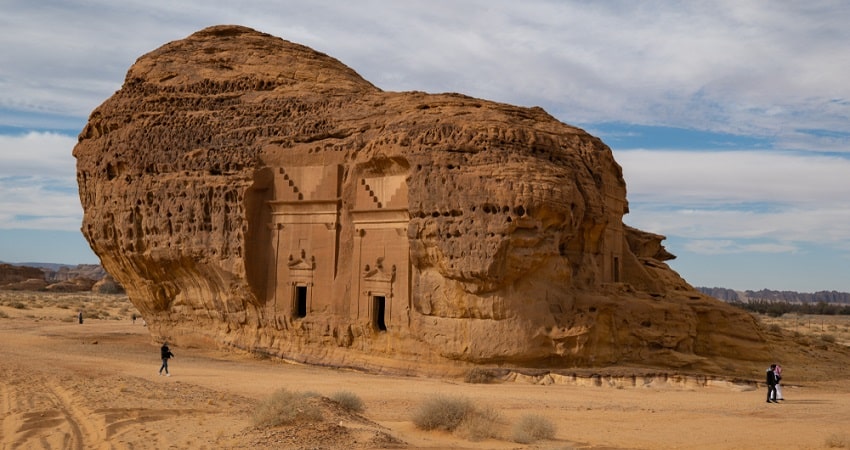
With preserved monumental tombs, the Hegra Madain Saleh or Al Hijr is a World Heritage Site located in Saudi Arabia. It has a decorated facade representing the civilization of Nabataeans in the south of Petra in Jordan. It lies at the crossroads of the trade route present in the Arabian Peninsula. The Al-Hijr Archaeological Site is also known as ‘The Capital of Monuments’. It is home to numerous cave drawings and inscriptions that boast past artistic-styled inscriptions in old languages and scripts. The site also features 111 tombs and water wells that depict the hydraulic expertise and architectural accomplishments of the Nabataeans.
History of Hegra Madain Saleh

The natural setting and beautiful view of Madain Saleh convinced the Nabataeans to build their home here. It was similar to their first home, Petra, having heavenly sandstone cliffs in the north of Jordan. According to the inscriptions, Hegra was a thriving civilization between 1 BCE and 74 CE. The Nabataeans raised their herds of goats, sheep, and camels in Hegra Madain Saleh. They followed the footstep of other Arabian tribes that existed here before them and also started oasis agriculture. The excavated remains do not tell much about the time when the tribe inhabited the region, but they tell more about their style of living.
The site shows that the Nabataeans worshipped deities and practiced harsh laws to lead an ascetic life. They knew their ways around the desert and came here after facing invasion from enemy tribes. It is believed that Nabataeans controlled the spice trade in this region. They brought spices from the southern region of Saudi Arabia to the north so that Roman Egyptians, Greeks, Phoenicians, and other Mediterranean civilizations could buy from them.
Many ruins of the Hegra town lie a little far from the tombs. However, most parts of the site are still unexcavated and look like sun-dried mud brick. The inscriptions on the tombs serve as references for historians.
The Al Hijr Story

The history of Islam suggests that Al-Hijr was a settlement of the Thamud tribe. Those people carved their homes and palaces in the mountains and plains of the site. The Madain Saleh story starts when the people of the tribe started believing in idol worship and began practicing oppression. Due to this, Saleh asked them to repent by bringing a pregnant camel from the back of the mountain and taking care of her. Only a few people from the Thamud tribe heeded what was asked of them, but the non-believers killed the camel.
Soon after the animal’s death, her calf escaped to the back of the mountain. The tribe was given three days before the date of punishment. Saleh and his Monotheistic followers left the then-established city while the non-believers in the tribe faced the wrath of God in the form of an earthquake and a lightning event. Legends say that the almighty cursed Madain Saleh and after that, the calf started haunting the region.
However, many researchers suggest that the tribe existed before 715 BCE. Several narrations tell that Thamud was the name of the region and not the tribe.
What to see inside Madain Saleh?

A part of the Al Hijr Archaeological Site, tombs of Hegra are the most spectacular sites in Saleh. After Petra, it is the only site with beautiful tombs depicting magnificent skills and ancient carvings on the walls. The center of the façade offers an opulent entrance to the tomb. The walls inside Madain Saleh have carvings where the bodies of the deceased were placed. Here are some of the things that are worthy of attention and admiration:
- There are Nabatean inscriptions that indicate the ownership of the triclinium, places dedicated to rituals and banquets. At least six triclinium exist in Madain Saleh.
- Qasr al Bint or the ‘Palace of the Daughter or Madain’ is the largest tomb in Hegra and has a height of 16 m. The sculptor of this tomb was Hoor ibn Ahi for Hani ibn Tafsy. He and his family lived here during the reign of the Nabataean King, Aretas IV, in 31CE.
- Qasr al-Farid is considered the most iconic tomb in Madain Saleh because it was carved from a single stone, and it stands alone as a complete structure. The old documents suggest that tombs were chiseled in the top to down approach.
- There are carvings of winged lions on the tomb that have significance in Egyptian iconography. It suggests the exchange between the Nabataean and Ptolemaic kingdoms.
- The Jebel Ithlib is a massive outcrop that exists in the northern part of the site. The middle region has a natural slit called the Siq and is 40 m high. It bears a resemblance to the corridor at Petra. To the right of its entrance is a square-shaped chamber that features three stone benches where people sat during sacred feasts. After the Siq, there is a natural alcove called the Jebel Ithlib sanctuary. Here a canal brings water into a cistern. It is believed to be the sacred place where ancient people worshipped Dushara, the Lord of the Mountain and a Nabataean deity.
Suggested Read: 6 UNESCO World Heritage Sites In Saudi Arabia
How to reach Madain Saleh?
To reach the Al Hijr archaeological site, take a flight from Riyadh or Jeddah to the Prince Abdul Majeed bin Abdulaziz domestic airport in Al Ula. From there, taxis are easily available for Madain Saleh. A direct cab from Jeddah, Madinah or Riyadh is also an option but it will take a long time. Buses are available from major cities of Saudi Arabia to take passengers to Al Ula and Madain Saleh.
Stay Options
The Hegira region has budget-friendly as well as luxury accommodations. With parking facilities, high-speed Wi-Fi, satellite TV, shuttle service, ATM on-site and other such high-end services, the hotels ensure a comfortable stay. Some of the well-known hotels in and around Madain Salah are Hilton International Hotel Chain, Holiday Inn by IHG, Waad Al Ula Hotel, Movenpick Hotel & Resorts Madain Saleh, and Elaf Hotels.
Suggested Read: Top 5 Al Ula Resorts To Experience Traditional Saudi Hospitality
Permissions Required
Tourists need to get a permit to enter Madain Saleh. This permit request might take time to get through hence it is suggested to apply well in advance. Travel agents readily arrange permits on behalf of the travellers and groups at a minimal charge. Tourists arriving in a car have to register first and ensure to leave the premises before 5 pm. The site has fixed visiting hours. One can also visit the Saudi Commission for Tourism and Antiquities in the Diplomatic Quarters to gain permission to visit Madain Saleh.
Suggested Read: How to Become a Travel Agent
Tourists visit this place to witness the epitome of beauty and get acquainted with the history. It helps to understand a civilization from the past and has interesting tales for the visitors.
Al Hijr Archaeological Site FAQs
Who built hegra madain saleh.
According to the remains, Nabataean King, Aretas IV, developed this site in 31 CE.
How old is the archaeological site of Madain Saleh?
The tombs of Madain Saleh date back at least 2000 years.
Is entry to Madain Saleh permitted?
Visitors are allowed to visit Madain Saleh. However, no one is allowed to stay there overnight.
What was the purpose of developing Madain Saleh?
The site was a prosperous city in the past, and Nabataeans built their homes and palaces here. However, today, it is an archaeological site to study a civilization of the past.
What happened in Madain Saleh?
According to a tale, the people of the Thamud tribe started idol worshipping, and oppression rose in the region. God ordered Saleh to ask these people to repent; however, the non-believers did the opposite. Therefore, Saleh left the city, and the people of the tribe faced the wrath of the Almighty in the form of an earthquake and a lightning event.

Pratyush Srivastava
I think, every human is a beautifully concealed epoch in the making with God to unravel it at the perfect time. Hence, synergizing with distinctive individuals in search of an interesting story is my favorite work as a writer and creator.
Related Posts

Pigeon Towers: A Humble Example Of Arabian Architecture

Damside Park Abha: A Beautiful Lush Area Near A Renowned Dam

Fish Market Jeddah: An Immersive Shopping Experience

Ports In Saudi Arabia: Prominent Ports, Location, Capacity And Facilities
Leave a reply, we use cookies.
Zamzam.com uses cookies for proper & secured functioning of the site, and personalizing its content & advertising to ensure a superior user experience. Know more.
Information for Travellers During COVID-19
- 2 doses of Pfizer BioNTech
- 2 doses of Oxford AstraZeneca
- 2 doses of Moderna
- 1 dose of Johnson and Johnson
- A visitor must enter their immunization data into the Saudi vaccination registration system “Muqeem” before arrival into Saudi Arabia. The vaccination registration website address is: https://muqeem.sa/#/vaccine-registration/home .
- Visitors arriving in Saudi Arabia are also required to provide a negative PCR COVID-19 test taken no more than 72 hours before departure and an approved paper vaccination certificate, issued by the official health authorities in the issuing country.
- Visitors are advised to check the current entry requirements with their chosen airline before purchasing a ticket.

Mada'in Saleh - Saudi Arabia’s Abandoned Nabatean City
- Read Later
Although archaeological remains may not be the first thing that spring to mind when most people think of Saudi Arabia, it has incredible historic sites. Mada'in Saleh, which was designated a World Heritage Site by UNESCO, contains many remarkable ruins and tombs. It is the first location in Saudi Arabia to have achieved this distinction. It was once the second city of perhaps the most important pre-Islamic Arabian civilization, the Nabateans.
The Fabled History of Mada'in Saleh
The environment of Saudi Arabia was not always as arid as it is today, and ancient civilizations were able to flourish. Sometime around 800 BC, the Assyrians were aware of an Arab people called the Thamuds who are believed to have established the first settlement at Mada'in Saleh. According to the Quran, they were pagans. Allah sent Prophet Salih to warn the Thamuds, but unwilling to listen, they were destroyed and only the faithful were allowed to live on.
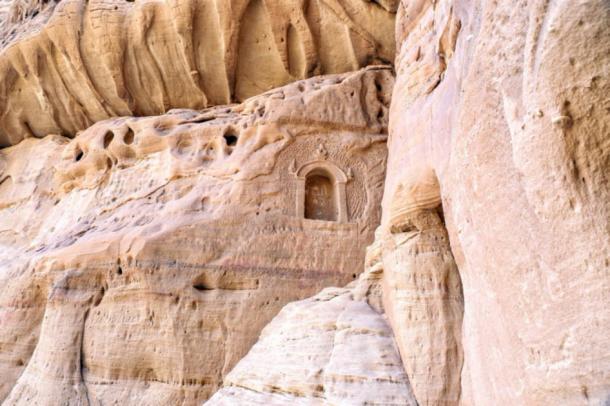
Niches carved into the rock at Mada’in Saleh, Saudi Arabia ( paulfell / Adobe Stock)
In the 3 rd and 2 nd century BC, the Dedan (also called Lihyan) culture occupied the site and left many examples of their rock art in the locality. They appear to have turned Mada'in Saleh into a caravan town where traders would rest and sell their wares.
The Nabateans occupied the city in the 1 st century BC. They were originally nomads who established a powerful kingdom in the Sinai and parts of modern Jordan in north-west Arabia. Under the Nabateans, the settlement of Mada'in Saleh became a true city. They developed a system for irrigation based on the collection of rainwater in tanks which helped agriculture to flourish.
Mada'in Saleh became the second city of the Nabatean kingdom, the capital of which was the famous city of Petra in Jordan. The Nabateans referred to Mada'in Saleh as Hegra and it grew fabulously rich as it monopolized the spice and incense trade.
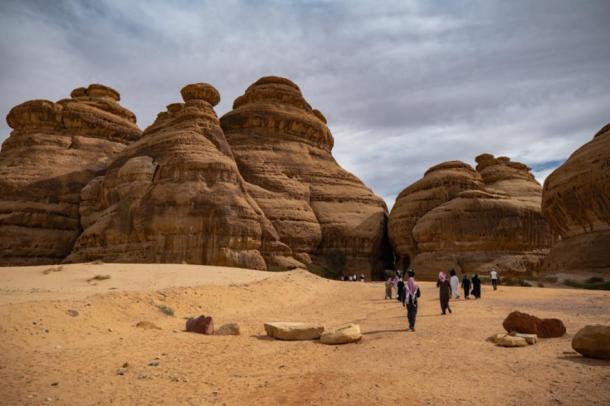
Mada'in Saleh archaeological site, Saudi Arabia ( mstarling / Adobe Stock)
In 106 AD, the Roman legions under Emperor Trajan occupied the kingdom and turned it into the province of Arabia. Changing trade routes meant that the caravan city of Mada'in Saleh began to decline. During the early Islamic period, the former city became depopulated and was only a staging post on the Hajj pilgrim route.
By the Middle Ages, Mada'in Saleh was abandoned, but the Ottomans later built a fort in the area, which was destroyed during WWI. Archaeologists began to explore the city in the 19 th century.
The Wonders of Mada'in Saleh, Saudi Arabia
The ruined caravan city is roughly mid-point between Mecca and Petra and is located on a flat plain, near an oasis. This area is also dotted with sandstone outcrops which are part of the Hejaz Mountains.
- Rock art: Life-sized Sculptures of Dromedaries Found in Saudi Arabia
- The Magnificent Ancient City of Petra, Jordan
- The sophisticated water technologies of the ancient Nabataeans
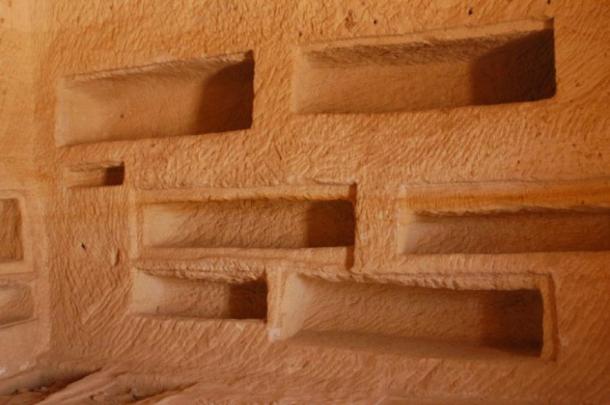
Recessed shelves of the tombs, Mada'in Saleh ( CC BY SA 2.0 )
Mada'in Saleh, often referred to as Al-Hijr by local Saudis, has ruins similar to those found in Petra. There four necropolises in the area spread over 8 miles (12km). More than 130 tombs carved into the rock and elaborately decorated grace the site with Nabatean script indicating the social status and even military rank of the dead. Some of the later tombs have inscriptions in Latin. These texts, which are unique to Mada'in Saleh, are extraordinarily valuable as the Nabateans left no extensive written history.
Many tombs have been badly eroded by the desert winds, but it is possible to view the interiors as they are empty. A religious area where the Nabatean deity Dushara was worshiped was enclosed by an adobe wall.
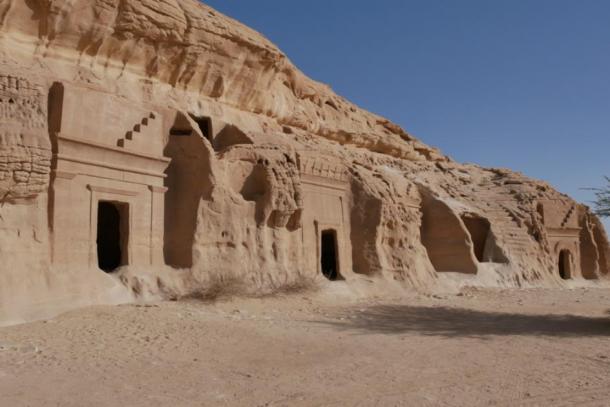
A row of tombs, Mada'in Saleh, Saudi Arabia ( mstarling / Adobe Stock)
A narrow corridor, graced by a number of ancient shrines, was cut into two high rock outcrops and leads to an old council chamber.
There are numerous wells that were once part of the Nabatean system of irrigation that helped the caravan city to flourish in the desert region. Of the approximately 60 wells, some are up to 20 feet (7m) high and hewn into the rock, while others are in the ground and were reinforced with blocks of stone. In the center of the site are a number of ruined adobe houses.
Experience Mada'in Saleh, Saudi Arabia
Because visas for non-Muslims to enter Saudi Arabia were notoriously difficult to obtain in the past, the absence of hordes of tourists, as well as the dry climate, kept Mada'in Saleh beautifully preserved.
Mada'in Saleh is near Al-'Ula in Medina Province. It is possible to book a tour of the site, but the more intrepid adventurers can hire a vehicle and travel to the location independently. A fee is charged to explore, and information is available at Mada'in Saleh.
Top image: Tombs of Mada’in Saleh Source: mstarling / Adobe Stock
By Ed Whelan
Khairy, N. I. (2011). T he Mada'in Saleh Monuments and the Function and Date of The Khazneh in Petra . Palestine Exploration Quarterly, 143(3), 167-175
Available at: https://www.tandfonline.com/doi/abs/10.1179/003103211X13092562976135
Nehmé, L., Villeneuve, F., Al Talhi, D., Al Anzi, A., Bouchaud, C., Charloux, G., ... & Al Hajîrî, M. (2011). Report on the second season (2009) of the Madâ'in Sâlih Archaeological Project
Available at: https://halshs.archives-ouvertes.fr/halshs-00548747/
Saleh, M. (2013). Honeycomb weathering of sandstone outcrops at Al-Hijr (Mada'in Salih), Saudi Arabia
Available at: http://ejars.journals.ekb.eg/article_7278_73bde99af9663be87b9071821a1fd1c3.pdf

My name is Edward Whelan and I graduated with a PhD in history in 2008. Between 2010-2012 I worked in the Limerick City Archives. I have written a book and several peer reviewed journal articles. At present I am a... Read More
Related Articles on Ancient-Origins
Travel | November 23, 2020
Hegra, an Ancient City in Saudi Arabia Untouched for Millennia, Makes Its Public Debut
The archaeological site, now open to tourists, offers clues about the mysterious empire that built it and its more famous sister city of Petra in Jordan
/https://tf-cmsv2-smithsonianmag-media.s3.amazonaws.com/filer/59/69/59691db3-ebcd-49cb-99fe-07437316e3bb/madain_saleh_mobile.jpg)
Lauren Keith
In the scrub-speckled desert north of AlUla in Saudi Arabia, rocky outcrops and giant boulders the size of buildings, beautifully carved and with classical-style pediments and columns, poke out of the sands like divinely scattered seeds. As the sun sets, the dusty colors flare, revealing pockmarks and stains caused by rain, which has shaped these stones for millennia.
Once a thriving international trade hub, the archeological site of Hegra (also known as Mada'in Saleh) has been left practically undisturbed for almost 2,000 years. But now for the first time, Saudi Arabia has opened the site to tourists. Astute visitors will notice that the rock-cut constructions at Hegra look similar to its more famous sister site of Petra , a few hundred miles to the north in Jordan. Hegra was the second city of the Nabataean kingdom, but Hegra does much more than simply play second fiddle to Petra: it could hold the key to unlocking the secrets of an almost-forgotten ancient civilization.
Determined to wean its economy off the petro pipeline, Saudi Arabia is banking on tourism as a new source of income. Oil currently accounts for 90 percent of the country’s export earnings and makes up about 40 percent of its GDP. In 2016, Crown Prince Mohammed bin Salman announced Saudi Vision 2030 , a roadmap for the country over the next two decades that aims to transform it into a global hub for trade and tourism that connects Africa, Asia and Europe.
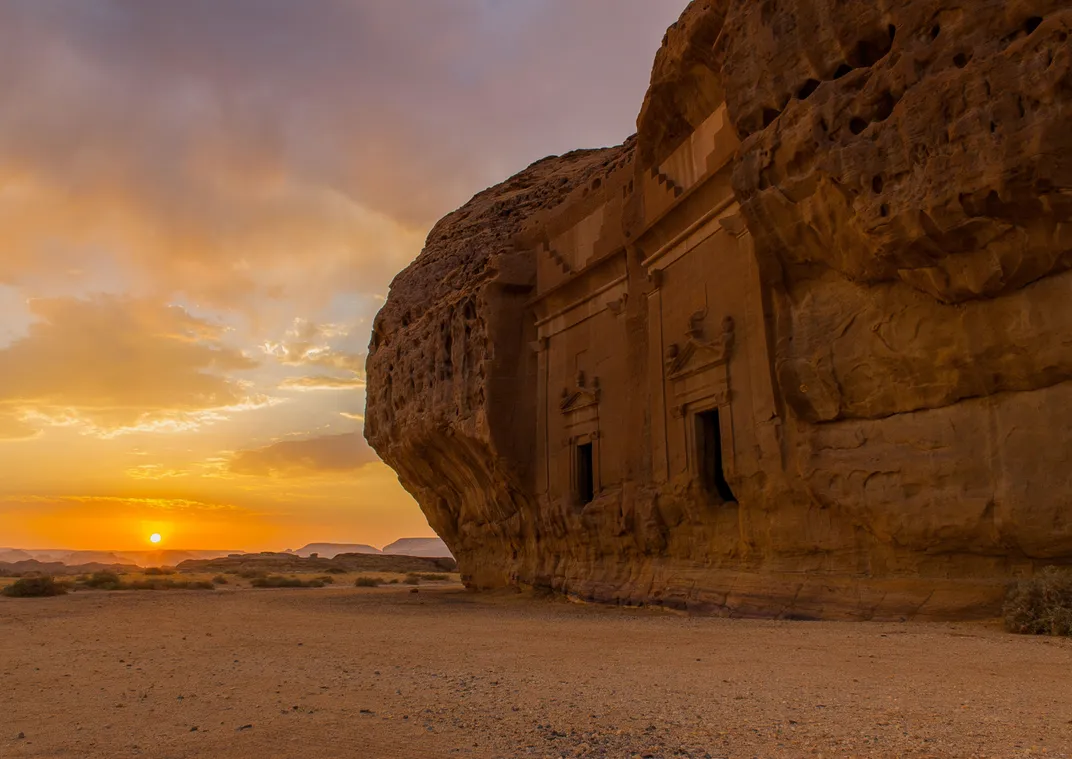
Saudi Arabia launched tourist visas for the first time in September 2019, allowing casual visitors without a business or religious purpose into the country. Hegra, with its mysterious, eye-catching architecture, is an obvious choice to highlight when marketing Saudi Arabia to tourists. Much of Hegra’s appeal lies in the fact that it’s virtually unknown to outsiders despite its similarities to Petra , which now sees nearly one million visitors a year and could be classified as an endangered world heritage site if not properly cared for, according to Unesco .
While Hegra is being promoted to tourists for the first time, the story that still seems to get lost is that of the ancient empire responsible for its existence. The Nabataeans are arguably one of the most enigmatic and intriguing civilizations that many have never heard of before.
“For a tourist going to Hegra, you need to know more than seeing the tombs and the inscriptions and then coming away without knowing who produced them and when,” says David Graf, a Nabataean specialist, archeologist and professor at the University of Miami. “It should evoke in any good tourist with any kind of intellectual curiosity: who produced these tombs? Who are the people who created Hegra? Where did they come from? How long were they here? To have the context of Hegra is very important.”
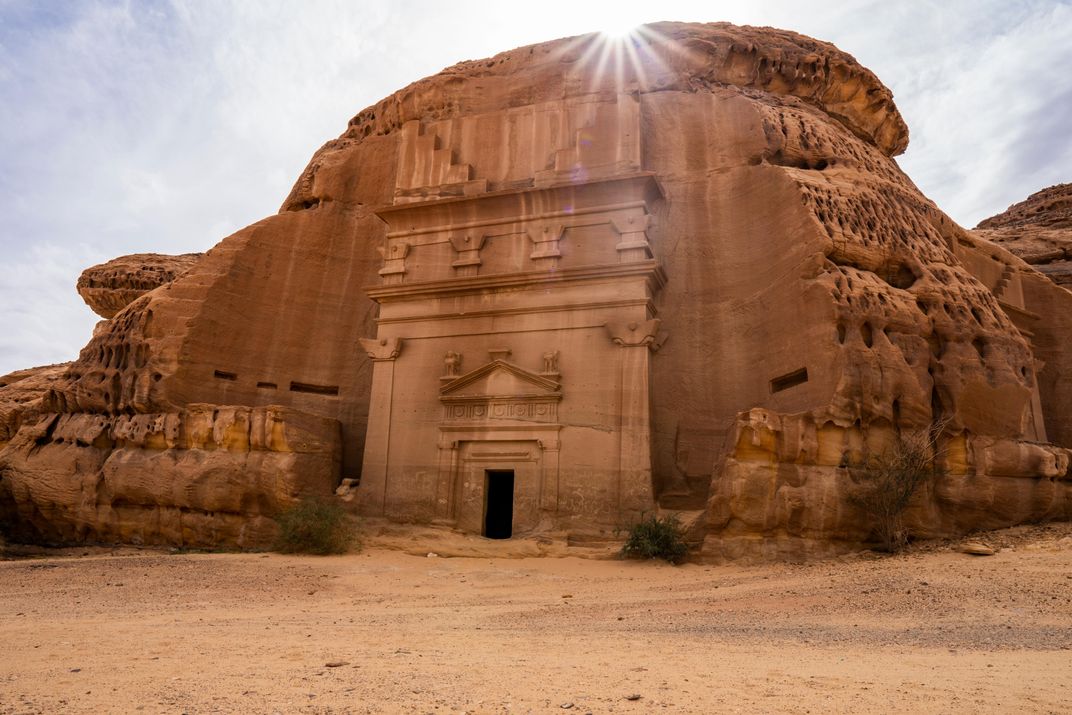
The Nabataeans were desert-dwelling nomads turned master merchants, controlling the incense and spice trade routes through Arabia and Jordan to the Mediterranean, Egypt, Syria and Mesopotamia. Camel-drawn caravans laden with piles of fragrant peppercorn, ginger root, sugar and cotton passed through Hegra, a provincial city on the kingdom’s southern frontier. The Nabataeans also became the suppliers of aromatics, such as frankincense and myrrh, that were highly prized in religious ceremonies.
“The reason why they emerged and they became new in ancient sources is that they became wealthy,” says Laila Nehmé, an archeologist and co-director of the Hegra Archeological Project, a partnership between the French and Saudi governments that is excavating sections of the site. “When you become wealthy, you become visible.”
The Nabataeans prospered from the 4th century B.C. until the 1st century A.D., when the expanding Roman Empire annexed and subsumed their huge swath of land, which included modern-day Jordan, Egypt’s Sinai peninsula, and parts of Saudi Arabia, Israel and Syria. Gradually, the Nabataean identity was lost entirely. Forgotten by the West for centuries, Petra was “rediscovered” by Swiss explorer Johann Ludwig Burckhardt in 1812, though local Bedouin tribes had been living in the caves and tombs for generations. Perhaps it could be said that Petra was truly seen by most Westerners for the first time a century and a half later thanks to its starring role as the set for Indiana Jones and the Last Crusade in 1989.
The challenge with getting to know the Nabataeans is that they left behind so little first-hand history. With the immense popularity of Petra today, it’s hard to imagine that we don’t know much about its creators. Most of what we’ve learned about the Nabataeans comes from the documents of outsiders: the ancient Greeks, Romans and Egyptians.
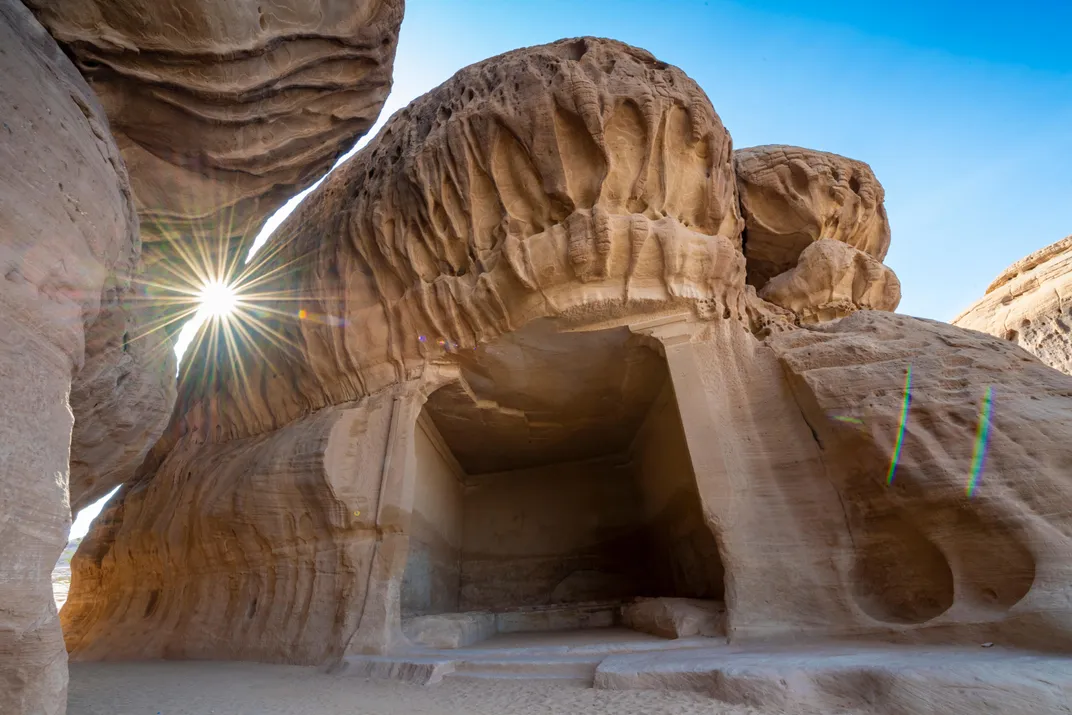
“The reason we don’t know much about them is because we don’t have books or sources written by them that tell us about the way they lived and died and worshipped their gods,” says Nehmé. “We have some sources that are external, so people who talk about them. They did not leave any large mythological texts like the ones we have for Gilgamesh and Mesopotamia. We don’t have their mythology.”
Like Petra, Hegra is a metropolis turned necropolis: most of the remaining structures that can be seen today are tombs, with much of the architectural remains of the city waiting to be excavated or already lost, quite literally, to the sands of time. One of the only places where the words of the Nabataeans exist is in the inscriptions above the entrances to several of the tombs at Hegra.
Obscure though they might be to us now, the Nabataeans were ancient pioneers in architecture and hydraulics, harnessing the unforgiving desert environment to their benefit. Rainwater that poured down from the craggy mountains was collected for later use in ground-level cisterns. Natural water pipes were built around the tombs to protect their facades from erosion, which have kept them well preserved thousands of years after their construction.
“These people were creative, innovative, imaginative, pioneering,” says Graf, who has been researching the Nabataeans since he unexpectedly unearthed some of their pottery in 1980 on an excavation in Jordan. “It just blew my mind.”
Hegra contains 111 carefully carved tombs, far fewer than the more than 600 at the Nabataean capital of Petra. But the tombs at Hegra are often in much better condition, allowing visitors to get a closer look into the forgotten civilization. Classical Greek and Roman architecture clearly influenced construction, and many tombs include capital-topped columns that hold a triangular pediment above the doorway or a tomb-wide entablature. A Nabataean “crown,” consisting of two sets of five stairs, rests at the uppermost part of the facade, waiting to transport the soul to heaven. Sphinxes, eagles and griffins with spread wings—important symbols in the Greek, Roman, Egyptian and Persian worlds—menacingly hover above the tomb entrances to protect them from intruders. Others are guarded by Medusa-like masks, with snakes spiraling out as hair.
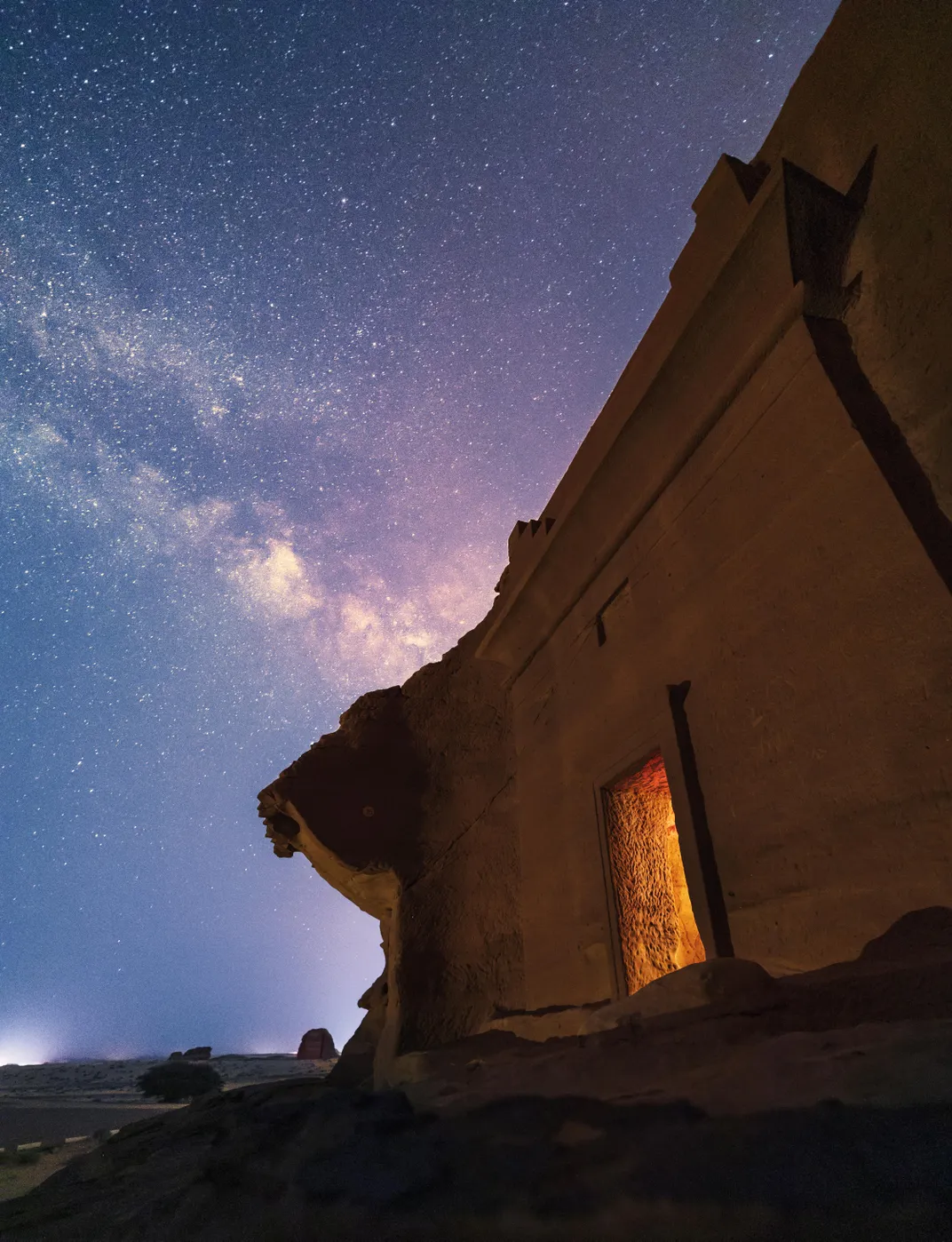
Nehmé calls this style Arab Baroque. “Why Baroque? Because it is a mixture of influences: we have some Mesopotamian, Iranian, Greek, Egyptian,” she says. “You can borrow something completely from a civilization and try to reproduce it, which is not what they did. They borrowed from various places and built their own original models.”
Intimidating inscriptions, common on many of the tombs at Hegra but rare at Petra, are etched into the facade and warn of fines and divine punishment for trespassing or attempting to surreptitiously occupy the tomb as your own. “May the lord of the world curse upon anyone who disturb this tomb or open it,” proclaims part of the inscription on Tomb 41, “...and further curse upon whoever may change the scripts on top of the tomb.”
The inscriptions, written in a precursor to modern Arabic, sometimes read as jumbled legalese, but a significant number include dates—a gold mine for archeologists and historians. Hegra’s oldest dated tomb is from 1 B.C. and the most recent from 70 A.D., allowing researchers to fill in gaps on the Nabataeans’ timeline, though building a clear picture is still problematic.
Graf says that about 7,000 Nabataean inscriptions have been found throughout their kingdom. “Out of that 7,000, only a little over 100 of them have dates. Most of them are very brief graffiti: the name of an individual and his father or a petition to a god. They are limited in their content, so it’s difficult to write a history on the basis of the inscriptions.”
Some tombs at Hegra are the final resting places for high-ranking officers and their families, who, according to the writing on their tombs, took the adopted Roman military titles of prefect and centurion to the afterworld with them. The inscriptions also underscore Hegra’s commercial importance on the empire’s southern fringes, and the texts reveal the diverse composition of Nabataean society.
“I argue the word Nabataean is not an ethnic term,” Graf says. “Rather it’s a political term. It means they are the people who controlled a kingdom, a dynasty, and there are various kinds of people in the Nabataean kingdom. Hegrites, Moabites, Syrians, Jews, all kinds of people.”
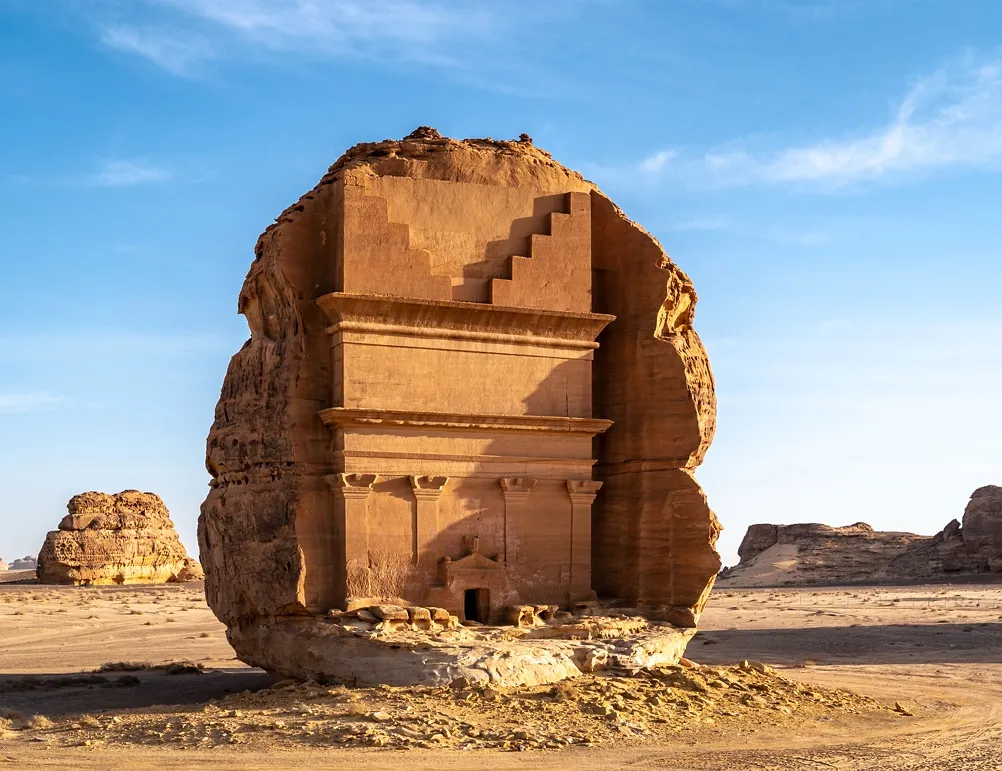
The full stories behind many of these tombs remain unknown. Hegra’s largest tomb, measuring about 72 feet tall, is the monolithic Tomb of Lihyan Son of Kuza, sometimes called Qasr al-Farid, meaning the “Lonely Castle” in English, because of its distant position in relation to the other tombs. It was left unfinished, with rough, unsmoothed chisel marks skirting its lower third. A few tombs were abandoned mid-construction for unclear reasons. The deserted work at Tomb 46 shows most clearly how the Nabataeans built from top to bottom, with only the stepped “crown” visible above an uncut cliffside. Both the Tomb of Lihyan Son of Kuza and Tomb 46 have short inscriptions, designating them for specific families.
A new chapter in Hegra’s history, however, is just beginning, as travelers are allowed easy access to the site for the first time. Previously, less than 5,000 Saudis visited Hegra each year, and foreign tourists had to obtain special permission from the government to visit, which fewer than 1,000 did annually. But now it’s as simple as buying a ticket online for 95 Saudi riyal (about $25). Hop-on-hop-off buses drop visitors off in seven areas, where Al Rowah , or storytellers, help bring the necropolis to life. Tours are given in Arabic and English.
“They are tour guides, but they are more than that,” says Helen McGauran, curatorial manager at the Royal Commission for AlUla, the Saudi governing body that's the caretaker of the site. “The handpicked team of Saudi men and women have been mentored by archeologists and trained by international museums to connect every visitor to the stories of this extraordinary open-air gallery. Many are from AlUla and speak beautifully of their own connections to this place and its heritage.”
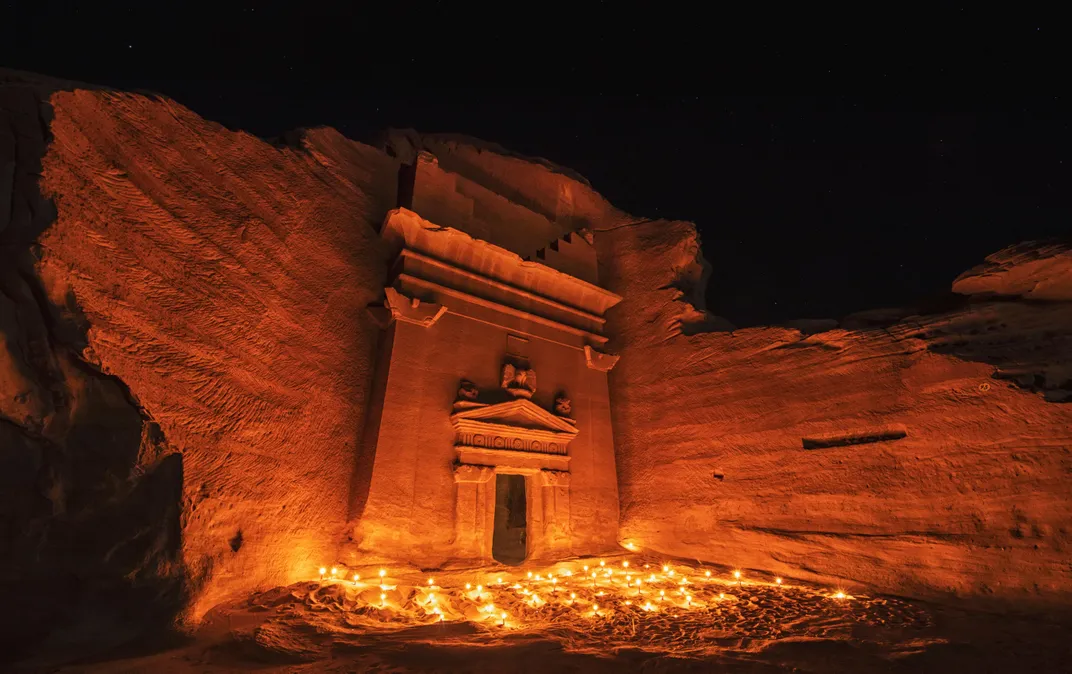
A visit to Hegra is merely scratching the surface of AlUla’s archeological trove. Other nearby heritage sites—the ancient city of Dadan, the capital of the Dadanite and Lihyanite kingdoms, which predated the Nabataeans, and Jabal Ikmah, a canyon filled with ancient rock inscriptions—are also now open to visitors. AlUla’s labyrinthine old town of mudbrick houses, which had been occupied since the 12th century but more recently abandoned and fell into a state of disrepair, is now a conservation site and is slated to welcome tourists starting in December.
“Hegra is absolutely the jewel in the crown,” McGauran says. “However, one of the beautiful and unique things about AlUla is that it is this palimpsest of human civilization for many thousands of years. You have this near continuous spread of 7,000 years of successive civilizations that are settling in this valley—important civilizations that are just now being revealed to the world through archeology.”
By 2035, AlUla is hoping to attract two million tourists (domestic and international) annually. AlUla’s airport, about 35 miles from Hegra, only opened in 2011, but it has already undergone large-scale renovations in anticipation of the influx of visitors, quadrupling its annual passenger capacity. The Pritzker Prize-winning French architect Jean Nouvel is designing a luxury cliff-carved cave hotel inspired by the Nabataeans’ work at Hegra, set to be completed in 2024.
“We see the development of AlUla as a visitor destination as being something that is happening with archeology and heritage at its heart, with a new layer of art, creativity and cultural institutions being added to that,” McGauran says.
Scholars believe that the Nabataeans saw their tombs as their eternal home, and now their spirits are being resurrected and stories retold as part of AlUla’s push to become an open-air museum.
“This is not just one museum building. This is an extraordinary landscape where heritage, nature and arts combine,” McGauran says. “We talk a lot about AlUla for millennia as being this place of cultural transfer, of journeys, of travelers, and a home to complex societies. It continues to be that place of cultural identity and artistic expression.”
Though the Nabataeans left behind scant records, Hegra is where their words are most prominently visible. But the Nabataeans weren’t the only ones here: about 10 historic languages have been found inscribed into the landscape of AlUla, and this region in particular is seen as instrumental in the development of the Arabic language. Something about AlUla has inspired civilization after civilization to leave their mark.
“Why are we telling these stories here?” McGauran asks. “Because they’re not stories that you can tell anywhere else.”
Get the latest Travel & Culture stories in your inbox.
/https://tf-cmsv2-smithsonianmag-media.s3.amazonaws.com/accounts/headshot/lauren.png)
Lauren Keith | READ MORE
Lauren Keith is a Kansas City–based travel journalist and guidebook author who writes about off-the-beaten-track and under-loved places from the Midwest to the Middle East.

Saudi Arabia Tours
Madain Saleh Tour
Approx. 6-7 hours
Pickup Time:
8:00 am – we can change the time to suit you.
Tour Highlights:
Madain Saleh, Hegra, Hijaz Railway station, Elephant Rock, Dadan & Jabel Ikmah.
Tour Prices:
Your Tour leader/driver will be awaiting you. They will be holding a sign of your name, You do not need to look for them – they will be waiting for you and will find you.
From the moment your tour starts, your tour leader will give you full attention. Once in the car, your tour leader will talk to you about all the things on the way as well as other aspects of your tour that will interest you.
Start your tour visiting the Hegra , also known as Madain Saleh , or Al-Ḥijr is an archaeological site located in the area of AlUla within Al Madinah Region in the Hejaz, Saudi Arabia. A majority of the remains date from the Nabatean kingdom. The site constitutes the kingdom’s southernmost and largest settlement after Petra, its capital.
The Archaeological Site of Al-Hijr (Madain Saleh) is the first World Heritage property to be inscribed in Saudi Arabia. Formerly known as Hegra it is the largest conserved site of the civilization of the Nabataeans south of Petra in Jordan. It features well-preserved monumental tombs with decorated facades dating from the 1st century BC to the 1st century AD. The site also features some 50 inscriptions of the pre-Nabataean period and some cave drawings. Al-Hijr bears a unique testimony to Nabataean civilization. With its 111 monumental tombs, 94 of which are decorated, and water wells, the site is an outstanding example of the Nabataeans’ architectural accomplishment and hydraulic expertise.
Then enjoy Elephant Rock ,This spectacular rock formation resembles an elephant with its trunk touching the ground, is one of AlUla’s geomorphological wonders became one of AlUla iconic landmarks.
Elephant Rock, also known as Jabal AlFil, one of AlUla’s many geological marvels.
Then visit Jabal Ikmah , An open air library across AlUla’s Valley, lie thousands of inscriptions in Aramaic, Dadanitic, Thamudic, Minaic and Nabataean, features one of the oldest inscriptions of the Islamic era dating back to 24AH (644 CE).
Thousands of pre-Arabic inscriptions across numerous sites make AlUla an important location in studying the Arabic language. A mountain north of the AlUla Valley, AlAqra’a, features more than 450 early Arabic inscriptions. Naqsh Zuhayr, to the east, features one of the oldest inscriptions of the Islamic era — dating back to 24AH (644 CE). But no such site is more significant than Jabal Ikmah, home to the highest concentration of and most varied inscriptions in AlUla.
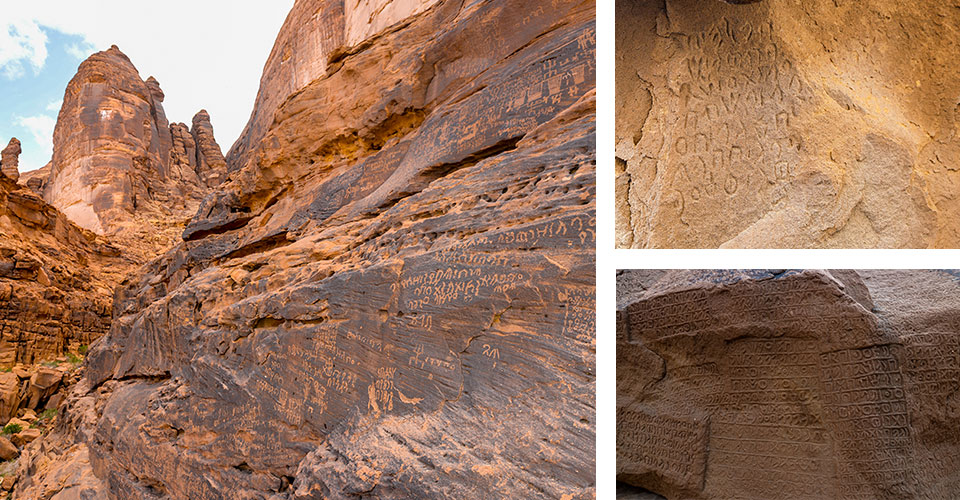
In a beautiful desert landscape warmed by the sun, the largest “open library” in Saudi Arabia sits tucked away in a remote canyon valley.
Dadan was a caravan way station for many peoples, and one of the clues that AlUla was truly a crossroads of civilisations is Jabal Ikmah, which was visited by those wishing to leave their inscriptions and offerings en route through AlUla. Records kept here — in the form of hundreds of inscriptions and carvings lining the cliff faces and rocks — ensured that Jabal Ikmah would be remembered throughout the ages.
A visit to this magnificent site, with its inscriptions thought to date as far back as the 1st millennium BCE, is a glimpse into the past.
Note: sightseeing tours on Herga and Dadan & ikmah will be sharing with a local tour guide and a small local group.
Travel in comfort back to your hotel, AlUla has so much to see, feel, eat and buy so if you have time and want to add more to your itinerary – just let us know what you are interested in and we will arrange it for you.
- Flexibility to customize your itinerary to your own preferences
- All transfers by modern air-conditioned van from your hotel in AlUla
- Tour leader/driver.
- Entrance fees
- All Service charges and taxes

IMAGES
VIDEO
COMMENTS
The most iconic historical site of Saudi Arabia. Madain Saleh is the most iconic historical site of the Kingdom of Saudi Arabia and the first to be listed as a UNESCO Word Heritage, back in 2008.It is located in the north of Madinah Province, in the area of Al-Ula, where many other fascinating archeological sites attest to the thousands of years of human occupation of the area thanks to the ...
12 tourist places to visit in Al Ula; Madain Saleh History. Madain Saleh was once the capital of the Kingdom of Lihyan. It is believed that the people of Thamud started inhabiting this place at around 2100 B.C. (i.e. around 4100 years from now).. This area has been discussed in the Holy Quran and a Hadith.
It would be a travesty to visit Saudi Arabia without visiting Al Ula and Hegra. It's a region awash with historic treasures, including the 2,500 year old mudbrick town of Al Ula and Hegra. Hegra, also called Madain Saleh or al-Hijr, is the country's first UNESCO-enshrined World Heritage Site. But it is also a region of great natural beauty.
Hegra (Ancient Greek: Ἕγρα), known to Muslims as Al-Hijr (Arabic: ٱلْحِجْر), also known as Mada'in Salih (Arabic: مَدَائِن صَالِح, romanized: madāʼin Ṣāliḥ, lit. 'Cities of Salih'), is an archaeological site located in the area of Al-'Ula within Medina Province in the Hejaz region, Saudi Arabia.A majority of the remains date from the Nabataean Kingdom (1st ...
The Hegra Archaeological Site (al-Hijr / Madā ͐ in Ṣāliḥ) is the first World Heritage property to be inscribed in Saudi Arabia. Formerly known as Hegra it is the largest conserved site of the civilization of the Nabataeans south of Petra in Jordan. It features well-preserved monumental tombs with decorated facades dating from the 1st ...
The tombs of Madain Saleh in Saudi Arabia are a UNESCO World Heritage Site. Located in Saudi Arabia, they represent the Nabataean civilization in Jordan's Petra. If you look at a map, you will see it standing on the Arabian Peninsula's trade route. Al Hijr is also called an archaeological site by the name "The Capital of Monuments.".
Mada'in Saleh. Mada'in Saleh, not far from al-Ula (22 km), was known as al-Hijr, or Hegra, by the Nabataean people who carved its magnificent tombs into the golden Quweira sandstone outcrops. The delicate details on the entrance portals and the smooth surfaces of its 111 tomb façades reflect the great skills of the masons of their time.
Understand [edit] Madain Saleh. A Nabataean city hewed out of rock in the same style as Jordan's far more famous Petra, Madain Saleh has been a UNESCO World Heritage Site since 2008, and would be a top tourist draw in any other country than Saudi Arabia. With the introduction of tourist visas by the Saudi government, it has now become easier for foreigners to visit.
Given Saudi Arabia's track record of abruptly closing and opening major tourist sights, however, it is best to call the contact centre ahead of any attempted visit. At the main entrance of the site is the Madain Saleh station of the Hejaz Railway, soon to become the visitors centre. Built in 1907, it consists of 16 buildings and includes a ...
Located in the Al Madinah region, halfway between Petra and Medina, Mada'in Saleh is a ruined city that once served as the second capital of the Nabataean Kingdom.Although the site is under police surveillance and is challenging to visit even today, with special arrangements more and more travellers are discovering this archaeological treasure, walking freely among the exceptional ruins cut ...
Madain Saleh is considered to be the most important settlement of the Nabataeans, second only to Petra.Its most significant cultural role dates back to the first two centuries BCE and first century CE, i.e., during the flourishing Nabataean state and before its fall at the hands of the Roman Emperor in 106 CE Al Hijr continued to be a source of cultural energy and intellectual interaction ...
Take a look at Saudi Arabia's first UNESCO World Heritage Site, the Hegra (Mada'in Saleh) archaeological site in AlUla, which features monumental Nabataean rock-cut tombs with ornate facades decorated with epigraphs. collections. Image. Monumental Nabataean tombs carved into the rocks at Hegra (Mada'in Saleh), a UNESCO World Heritage Site in AlUla.
The Madain Saleh site. After 11 days I finally find a tourist center in Saudi Arabia. Madain Saleh is hardly a tourist trap. Tourist traps get more than 11 tourists on a tour bus to see the remarkable remnants of a 2,000-year-old civilization, freshly refurbished this year. About 1,300 years before Marco Polo, there were the Nabataeans.
This photo essay illustrates her visit to Madain Saleh, one of Saudi Arabia's "hidden treasures." When he was the Kingdom of Saudi Arabia's Ambassador to the United States, Foreign Minister Adel Al-Jubeir gave me an extended visa. He had two good reasons for doing that. One was professional.
The Al Mudawara border post lies around two hours and 150 kilometers inland. It has better road connections to Tabuk and its stunning national park, and on to the Al Ula Valley. Transport to the border will cost around $25, with a similar price for continuing on to Al Ula. Both border posts are open 24 hours a day.
Start your Al Ula itinerary with a visit to Madain Saleh location . The history of the Madain Saleh necropolis . Madain Saleh or Hejra is the first tourist attraction in Saudi Arabia to be included in UNESCO World Heritage, more precisely in 2008. It's located about 20 km away from the city of Al Ula Saudi Arabia and is described as the Petra ...
PUBLISHED 21 MARCH 2024. Also known as Al Hijr or Hegra, Madain Saleh is a fascinating archaeological site in Saudi Arabia. It was a major site for the Nabataean Kingdom, second only to their capital, Petra, a UNESCO World Heritage Site in modern-day Jordan. The Nabataeans were a skilled civilization that thrived in trade and engineering around ...
One can also visit the Saudi Commission for Tourism and Antiquities in the Diplomatic Quarters to gain permission to visit Madain Saleh. Suggested Read: How to Become a Travel Agent. Tourists visit this place to witness the epitome of beauty and get acquainted with the history. It helps to understand a civilization from the past and has ...
Mada'in Saleh archaeological site, Saudi Arabia (mstarling/ Adobe Stock) In 106 AD, the Roman legions under Emperor Trajan occupied the kingdom and turned it into the province of Arabia. Changing trade routes meant that the caravan city of Mada'in Saleh began to decline. During the early Islamic period, the former city became depopulated and ...
Once a thriving international trade hub, the archeological site of Hegra (also known as Mada'in Saleh) has been left practically undisturbed for almost 2,000 years. But now for the first time ...
Madain Saleh is an excellent place to visit and learn about Saudi Arabia's pre-Islamic past. One also actually walks in the footsteps of Prophet Muhammad (peace be upon him).
Madain Saleh, Hegra, Hijaz Railway station, Elephant Rock, Dadan & Jabel Ikmah. Tour Prices: Single: 2- 3 Persons: 4-6 Persons: 7-10 Persons: 560$ 380$ 345 $ 330 $ ... A visit to this magnificent site, with its inscriptions thought to date as far back as the 1st millennium BCE, is a glimpse into the past. ...
Madain Saleh (مدائن صالح , also Medain Saleh) is a large archaeological site in Saudi Arabia. Understand . ... During your visit to Madain Saleh Area , you can eat good food in your hotel , (ARAC Al-Ula Hotel 4+ stars or Madain Saleh Hotel also 4 stars category), both hotels offer good and clean food , also if you want to try the local ...